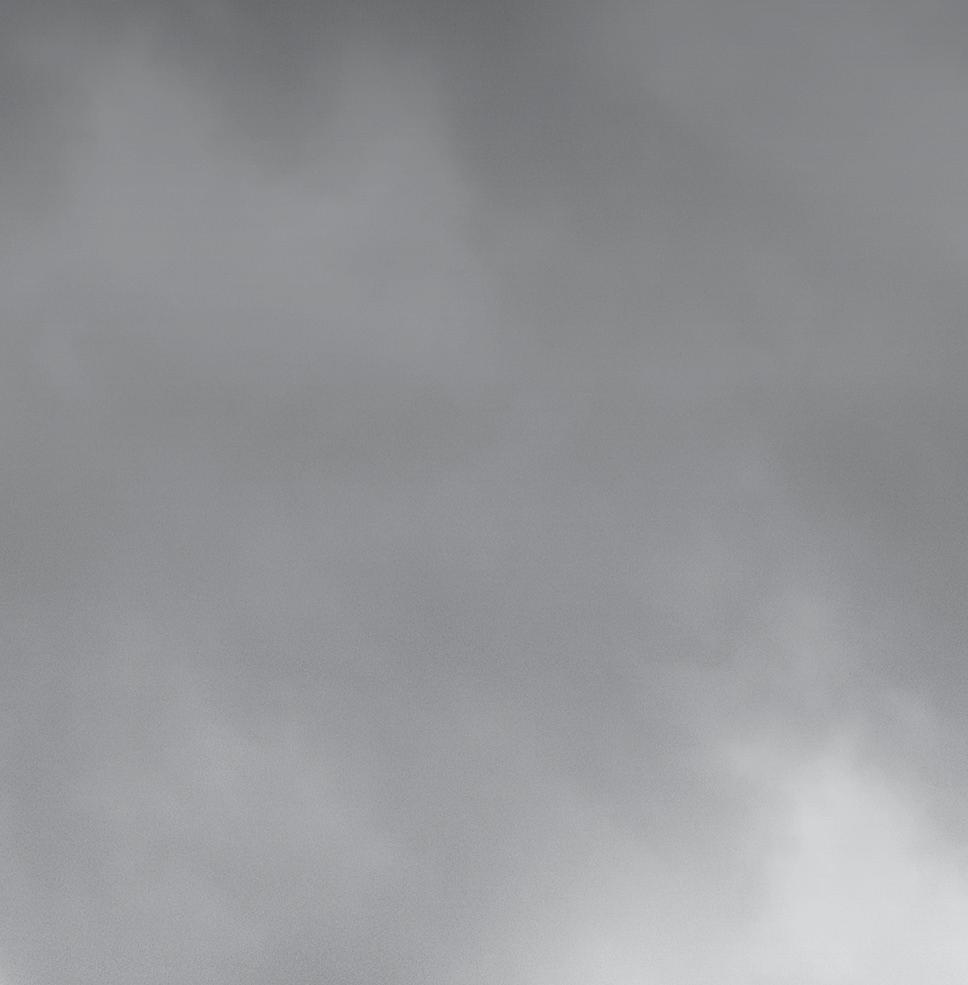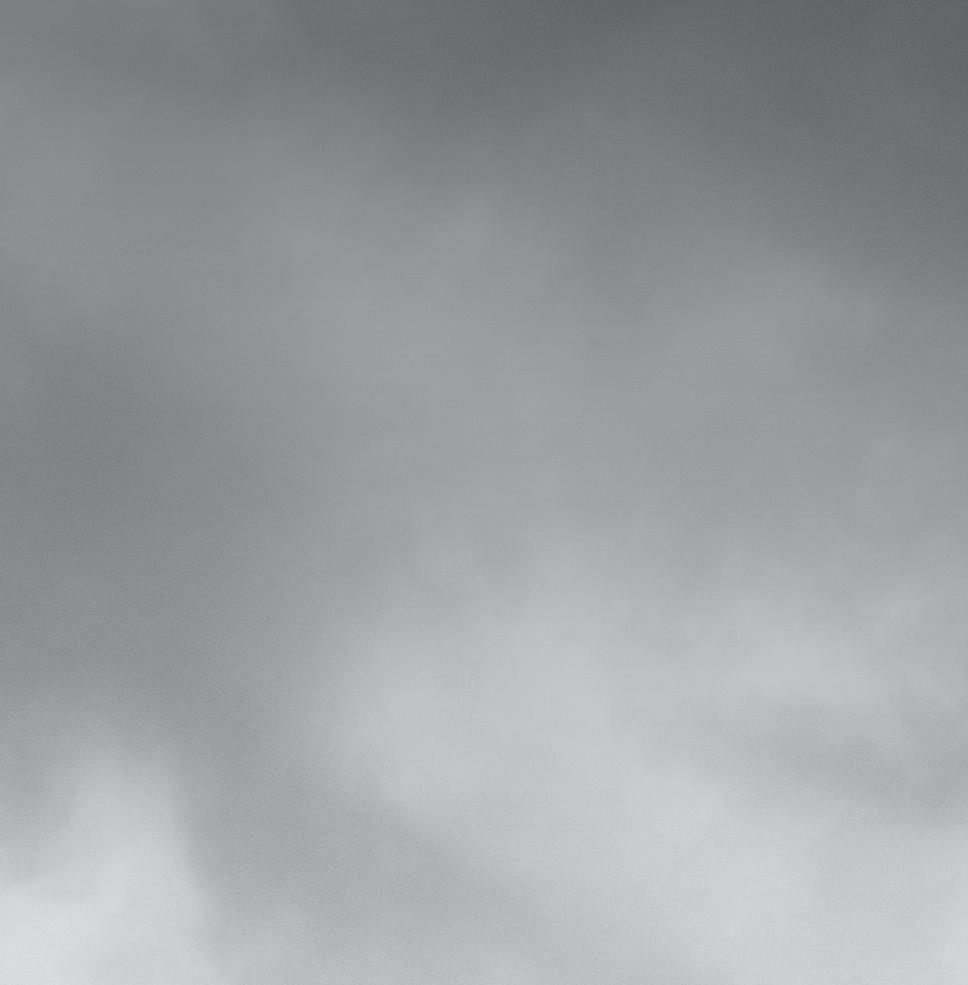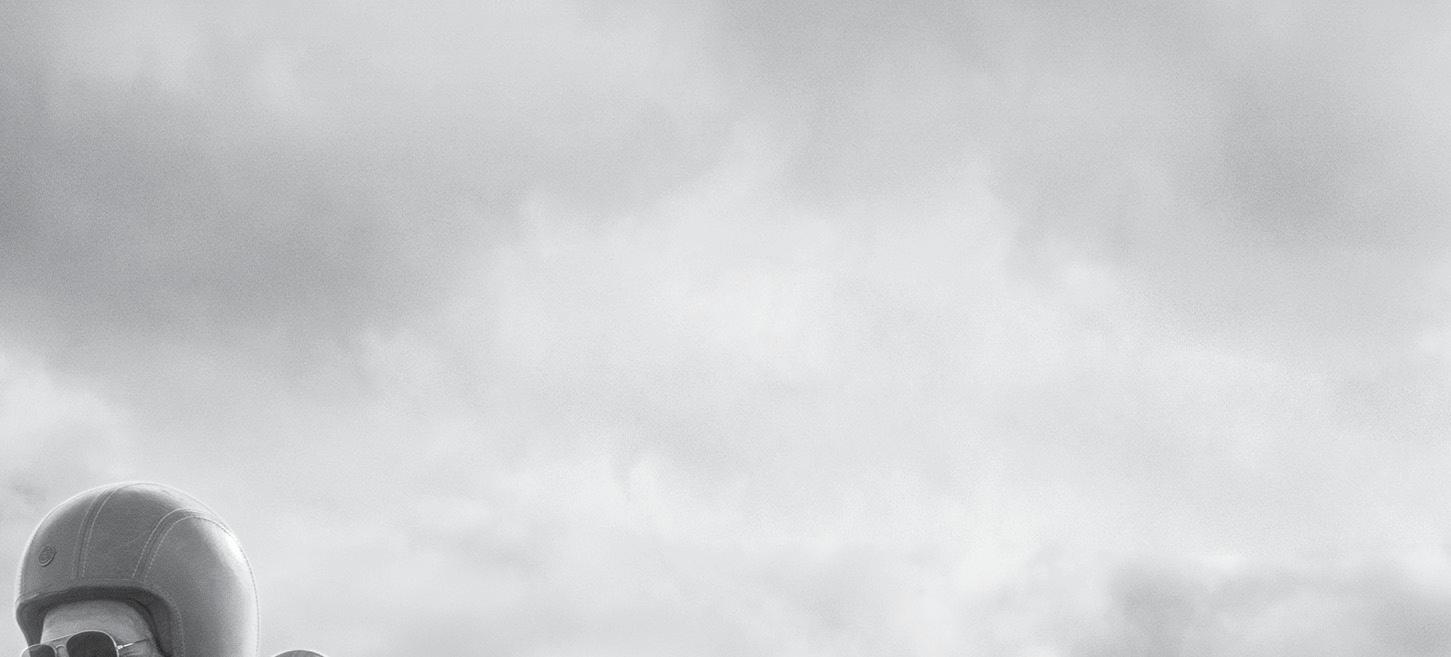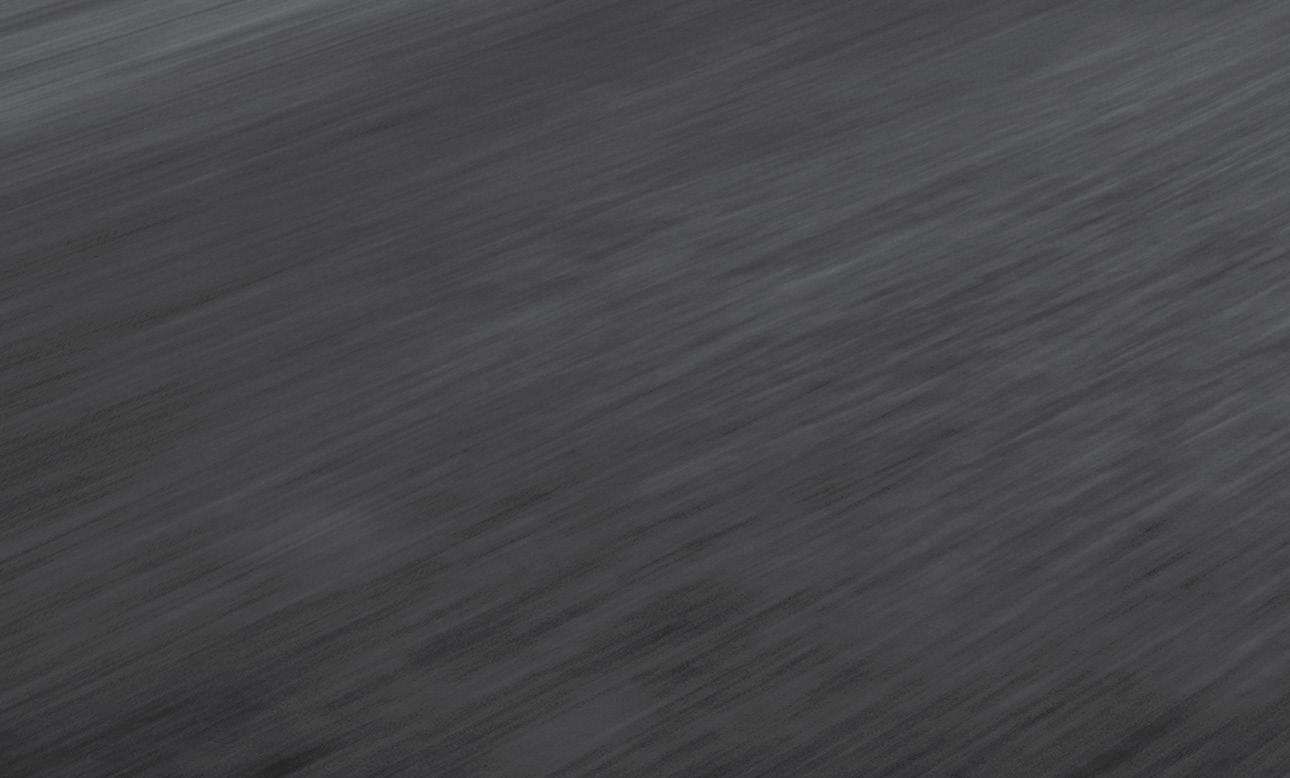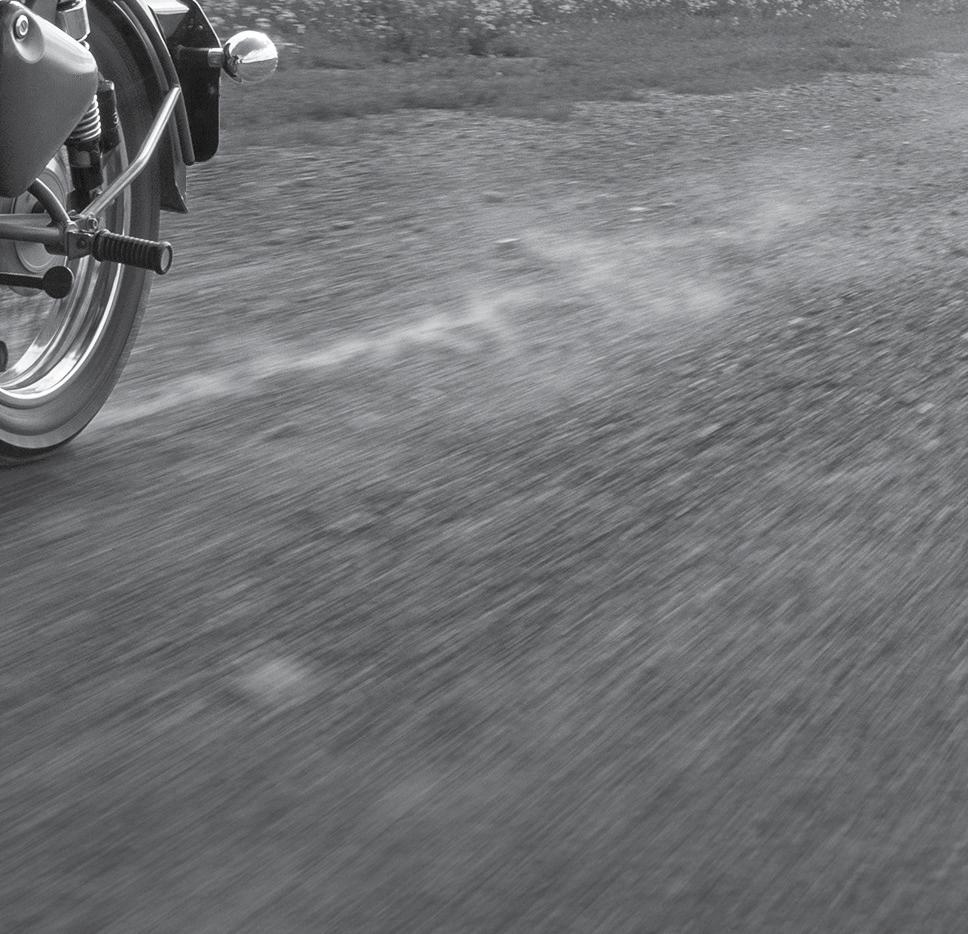

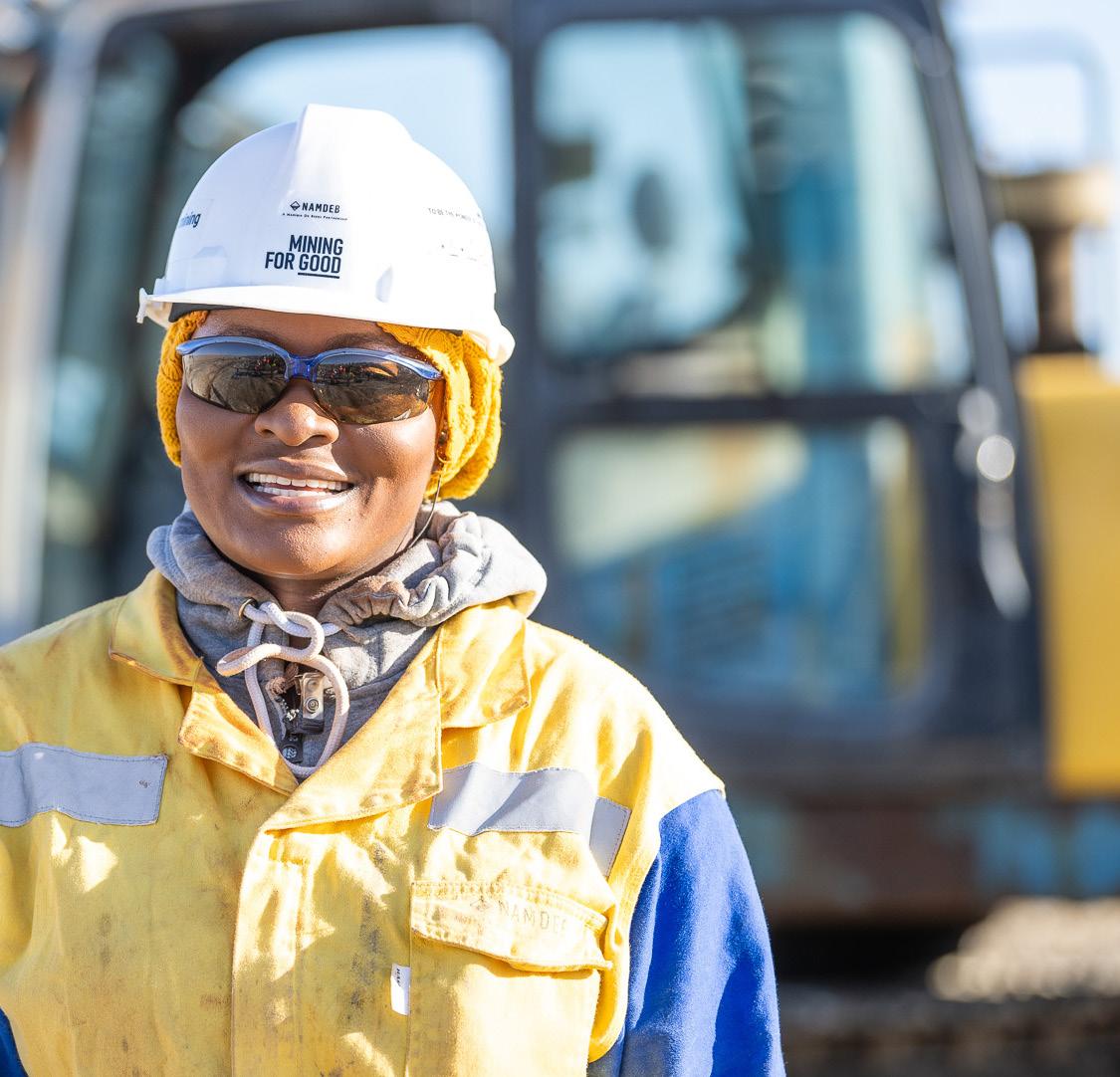
















We enable an inclusive environment for enhanced career prospects, focusing on accelerating equal opportunities for all.
At Namdeb, we are about more than mining. We are about mining for good.


“But
- Fyodor Dostoevsky
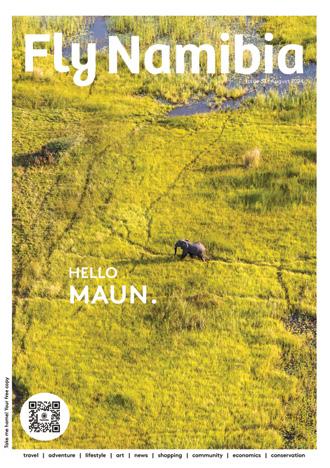







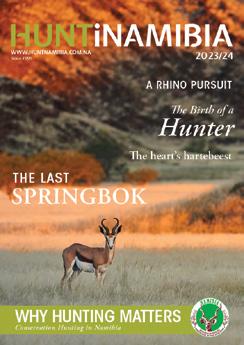
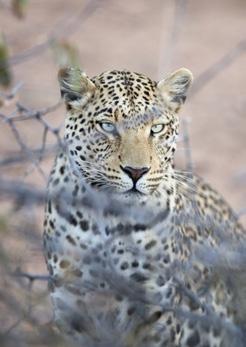

Meet the voices behind the incredible stories we share with Namibia each month. The pages of FlyNamibia are a collaboration of Namibian minds and passions and we hope you find a narrative that speaks directly to you amongst them.

Kirsty Watermeyer Media and communication consultant, storyteller and writer. A Multi-media producer, presenter, voice artist and curious wellbeing enthusiast.

Rukee Kaakunga
A Windhoek-based communications specialist, blogger and freelance fashion writer. Contact her via email: rukeekaakunga@gmail.com

David Bishop
Media commentator and critic, climbing wall owner, voracious reader, sometime writer, active lifestyle proponent, family man, and coffee lover.
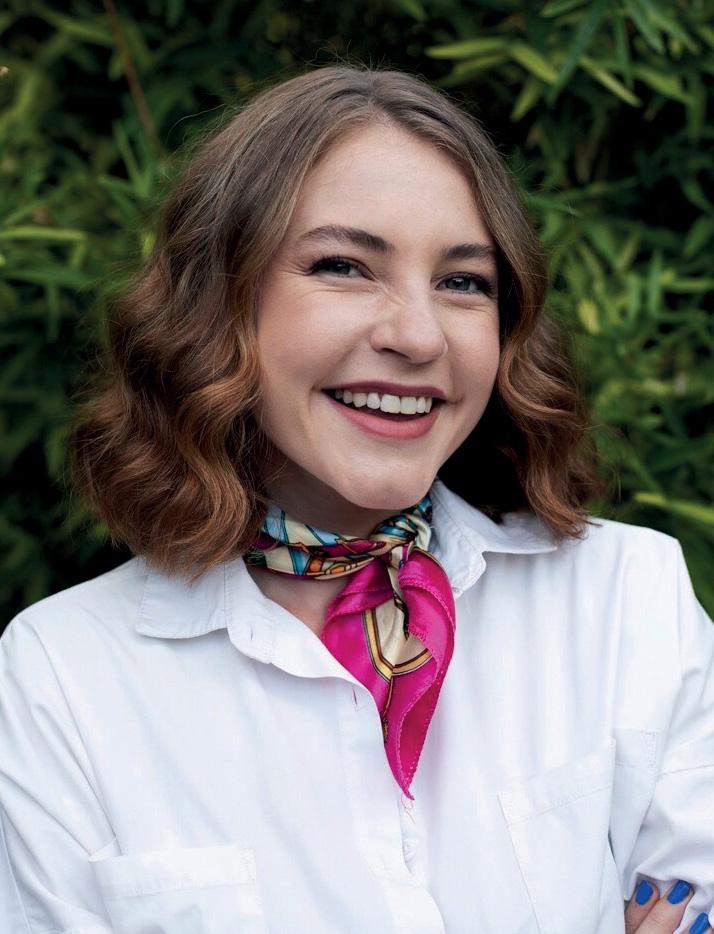
Charene Labuschagne
Art director, writer and presenter, she tells stories out of pure necessity for expression. Namibia is her favourite subject.

Agnes Shivute
An environmental consultant with interest in indigenous flora, nature enthusiast, Namibia Botanical Society awardee and aspiring author
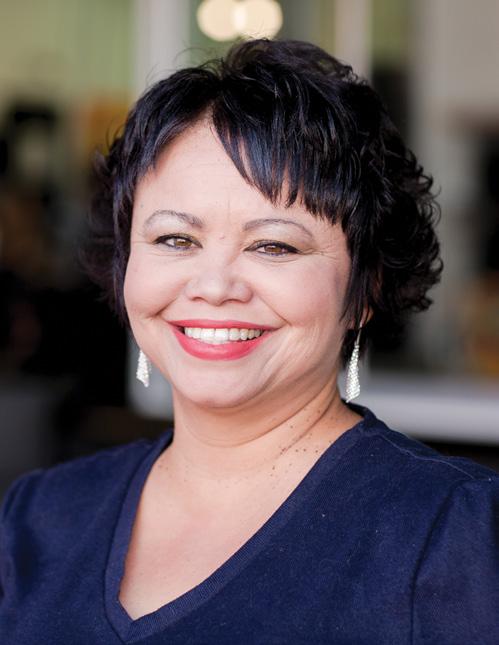
Forcelledo Paz
& Content Editor. Passion and dedication to keep the

Victoria Nakafingo
An aspiring astronomer, who enjoys gazing at the stars and sharing science research stories.
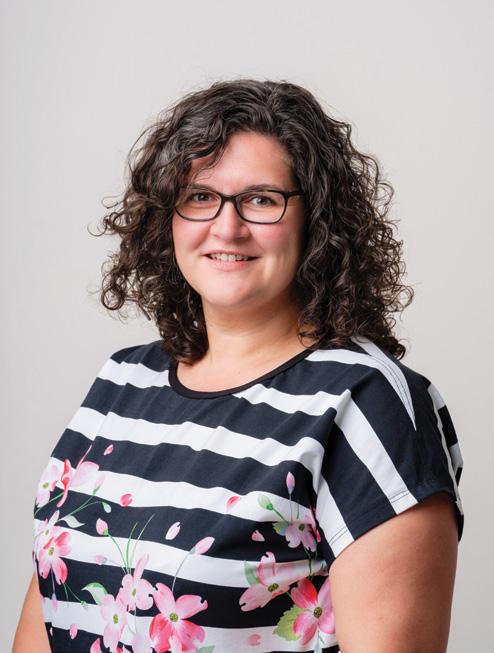
Dr. Daleen de Lange Specialist Psychiatrist who is passionate about mental health and about every visiting individual with his/ her own needs within a unique personal context.



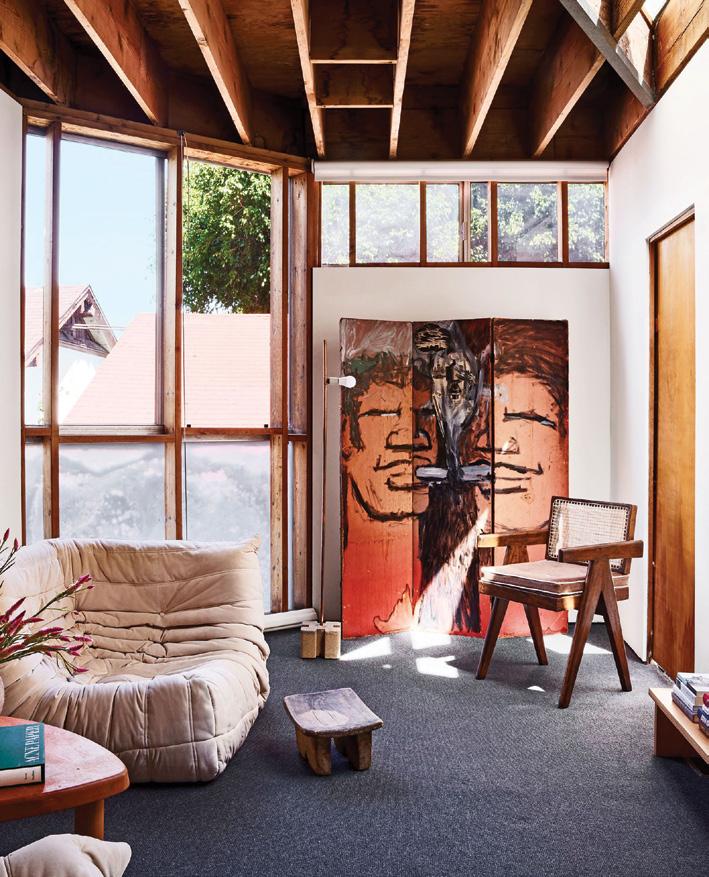
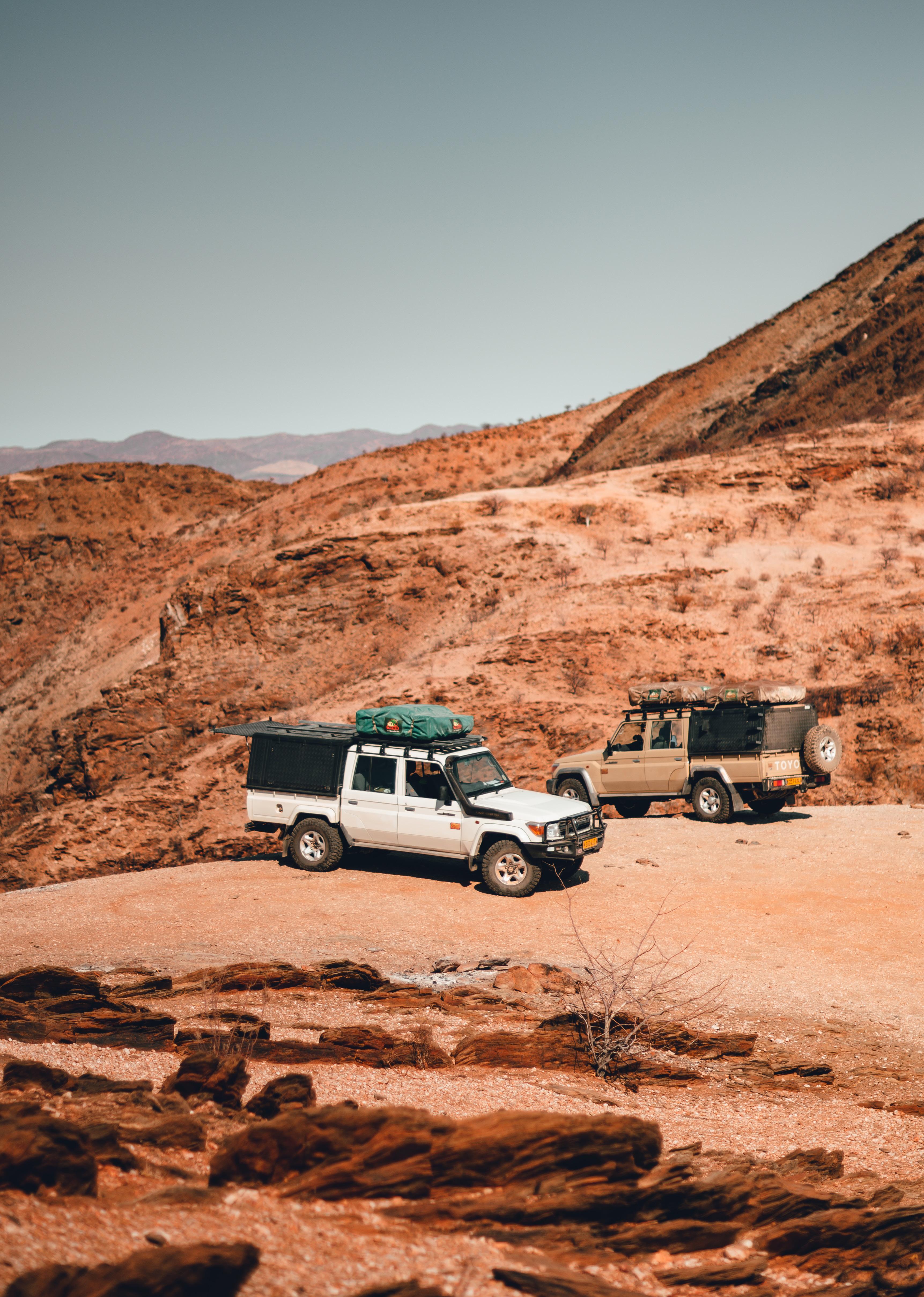
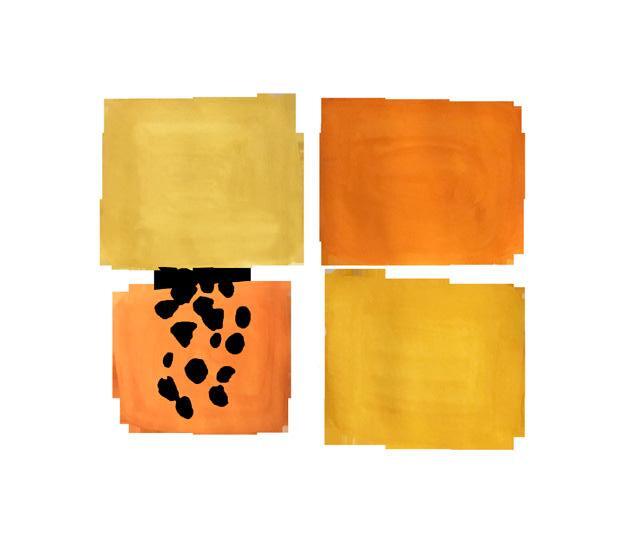

Select which tickets you would like to purchase: destinations, travel dates, morning/afternoon departure. We offer multiple fare options such as: Saver, Classic or Premium
Please enter names as they appear on passport or travel documentation
LOGIN to upload passenger details from previous booking.
More options for the perfect trip
Baggage policy, sporting equipment, over weight luggage or to add an additional bag(s)
Cash payment at: Eros Airport, Ondangwa Airport, Oranjemund Airport
Online card transaction
Electronic Funds Transfer (EFT)
PayToday app Buddy SuperApp
Online check-in opens 24 hours before departure of the flight on Fly Namibia
Check-in opens 1h 30min before domestic flight and 2 hours before international flight.
Check-in CLOSES 30 min prior to domestic flight and 50 min prior to international flight.
flight information / rules
Read up on all our additional information regarding terms and conditions, and tick the selection box once completed to continue.
Fill in your payment details in our DPO paygate to make final payment.
Transaction confirmation will be sent to passenger email entered.
Windhoek Eros Airport Office
Ondangwa airport office
Rundu airport office
Katima Mulilo airport office
Hosea Kutako airport office
All major travel agents
Items NOT allowed in hand luggage:
Lotions and aerosols above 100ml, flammable aerosol, sharp objects, i.e. nail files, nail scissors, Leatherman, matches.
20kg Per person
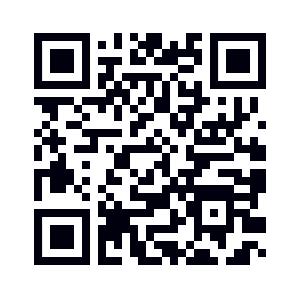




DEPARTURE FROM TO ARRIVAL DAYS
06:30 Eros - Windhoek
08:00
Ondangwa - Toivo Ya Toivo
16:20 Eros - Windhoek
17:50
Ondangwa - Toivo Ya Toivo
10:15 HKIA - Windhoek
12:55 Katima Mulilo
09:40 Eros - Windhoek
11:20 Oranjemund

Ondangwa - Toivo Ya Toivo 07:30 Mon, Tue, Fri
Eros - Windhoek 09:00 Mon, Tue, Fri
Ondangwa - Toivo Ya Toivo 17:20 Tue, Wed, Thu, Fri, Sun
Eros - Windhoek 18:50 Tue, Wed, Thu, Fri, Sun
Katima Mulilo 11:40 Wed, Fri, Sun
HKIA - Windhoek 14:15 Wed, Fri, Sun
Oranjemund 10:40 Mon, Fri
Eros - Windhoek 12:20 Mon, Fri
13:00 Eros - Windhoek Lüderitz 14:00 Mon, Tue, Thu
14:40 Lüderitz
Eros - Windhoek 15:40 Mon, Tue, Thu
DEPARTURE FROM TO ARRIVAL DAYS
10:15 HKIA - Windhoek Victoria Falls 11:45 Tue, Thu, Sat
12:45 Victoria Falls HKIA - Windhoek 14:15 Tue, Thu, Sat
From 3 July 2024 - 31 October 2024
10:15 HKIA - Windhoek Maun 11:15 Wed, Fri, Sun 11:55 Maun HKIA - Windhoek 14:15 Wed, Fri, Sun
in Partnership with
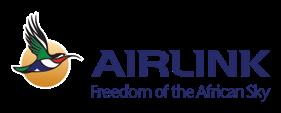
14:00 Cape Town Walvis Bay 16:15 Mon, Tue, Wed, Thu, Fri, Sun
16:50 Walvis Bay Cape Town 19:00 Mon, Tue, Wed, Thu, Fri, Sun
12:05 Cape Town Walvis Bay 14:20 Sat
14:55 Walvis Bay Cape Town 17:05 Sat
06:20 Cape Town

HKIA - Windhoek 08:35 Mon, Tue, Wed, Thu, Fri
09:25 HKIA - Windhoek Cape Town 11:35 Mon, Tue, Wed, Thu, Fri
10:45 Cape Town HKIA - Windhoek 13:00 7 days a week
13:45 HKIA - Windhoek Cape Town 15:55 7 days a week
17:10 Cape Town
HKIA - Windhoek 19:25 Thu, Fri, Sun
07:00 HKIA - Windhoek Cape Town 09:10 Mon, Fri, Sat
DEPARTURE FROM TO ARRIVAL
10:00 HKIA - Windhoek Keerweder 10:55 Mon, Wed, Fri, Sat
11:20 Keerweder Swakopmund 12:10 Mon, Wed, Fri, Sat
12:50 Swakopmund Twyfelfontein 13:30 Mon, Wed, Fri, Sat
14:00 Twyfelfontein Ongava 14:40 Mon, Wed, Fri, Sat
15:05 Ongava Mokuti 15:30 Mon, Wed, Fri, Sat
16:00 Mokuti
HKIA - Windhoek 17:00 Mon, Wed, Fri, Sat
10:00 HKIA - Windhoek Mokuti 11:00 Tue, Thu, Sun
11:30 Mokuti Ongava 11:55 Tue, Thu, Sun
12:20 Ongava Twyfelfontein 13:00 Tue, Thu, Sun
13:30
14:50 Swakopmund Keerweder 15:40 Tue, Thu, Sun
16:05 Keerweder HKIA - Windhoek 17:00 Tue, Thu, Sun
07:30 Eros - Windhoek Rundu 09:00 Mon, Wed, Fri
16:00 Rundu Eros - Windhoek 17:30 Mon, Wed, Fri
*HKIA - Hosea Kutako International Airport



Dear Passenger,
As you settle into your seats and prepare for your journey, we at FlyNamibia extend our warmest welcome. We are delighted to have you aboard and are excited to share our latest route additions and exciting upcoming ventures with you.
Hi David!
As we soar into September, we're thrilled to share some exciting milestones that mark new beginnings and bold steps forward for FlyNamibia. This month, we officially introduced David Penda as the new Face of FlyNamibia. Selected from an incredible pool of talented Namibians, David stood out for his passion, creativity, and deep love for our beautiful country. Over the next year, David will embark on a unique journey as our brand ambassador, capturing the essence of Namibia through his lens. He’ll be travelling to all our destinations, telling the stories that make Namibia so extraordinary, and showcasing the vibrant spirit of our people. We can't wait to see the inspiring content he creates and shares with all of you. Meet David on page 30.
Making your stuff fly!
But that’s not all—we're also excited to announce the launch of FlyNamibia Cargo, a new service that expands our capabilities and allows us to connect Namibia like never before. On 9 August, we celebrated the departure of our very first cargo shipment, marking the beginning of a new chapter in our service offerings.
FlyNamibia Cargo is designed with your needs in mind, offering a range of services to make shipping across Namibia and southern Africa easier, faster, and more reliable. Whether you’re sending everyday items, urgent packages, or even transporting your beloved pets, FlyNamibia Cargo ensures that your goods are in safe hands. With operations across all the airports we service, our cargo network allows your items to fly swiftly and securely from one point to another.
We understand that different shipments require different care, and that’s why we offer specialised services for perishable goods, valuable items, and even the delicate task of transporting human remains with the utmost respect and professionalism. Our express service guarantees fast delivery for those urgent needs, while our temperature-regulated storage keeps perishables fresh throughout their journey.
As we continue to grow and innovate, our commitment remains the same: to provide exceptional service and to connect Namibia with the world, one flight at a time. We’re honoured to have you on board with us this month, and we look forward to sharing the sky with you on your next adventure.
Safe travels and happy flying!
The FlyNamibia Team
Unique local lifestyle brands we're loving, and why you should too
We love their uber cool, half-moon leather bag. A stylish blend of handsfree practicality and timeless craftsmanship, the L E D half-moon bag is designed for versatility. This unisex leather bag can be worn over the shoulder or crossbody, making it perfect for life on the go. Inside, you’ll find two convenient card slots, while the exterior boasts L E D signature solid brass hardware and a reliable YKK zip. Each bag is meticulously hand-stitched using the age-old saddle stitch method, known as the strongest in leather manufacturing, which is why L E D offers a lifetime warranty. Available in various colours, including a newly launched double-zip model for extra space, this bag is both a fashion statement and a lifetime investment.
Shop online at www.leonengelbrecht.com
@leonengelbrechtdesign
+264 81 251 2169
30 Lazarett Street, Southern Industrial, Windhoek

We love their cosy, cool and elegant ethos. For fourteen years, founder Charl Botes has carefully curated the home decor pieces in Habitat, a space that has become synonymous with Swakopmund’s special shopping scene. It was only a matter of time then, for their selection of bathroom and bedroom accessories, enchanting home fragrances, soft furnishings, captivating lighting, and rugs to find a home in Windhoek. A beacon of inspiration and possibilities for architects, designers and homeowners alike; whether in the capital or at the coast, a browse through Habitat entices everybody to bring joie de vivre to their homes and businesses.
Habitat Swakopmund
+264 406 466
Habitat Lifestyle Centre, New Industrial, Einstein Street.
Habitat Windhoek



+264 81 493 3733 | Bougain Villas Complex, Sam Nujoma Drive
We love their multi-media content creation expertise. From awe-inspiring photography, striking videography, impeccable design and crisp podcasts, Venture knows just how to bring a project to life through storytelling. It’s a kind of magic that comes from being Namibia’s premier tourism and conservation media partner for more than three decades. Whether you’re a lodge group or guesthouse, a non-profit organisation or a proudly Namibian corporate, Venture Media helps to tell the world your remarkable story. At this boutique publishing and content marketing house, stories that matter take centre stage.
www.venture.com.na info@venture.com.na


We love their exceptional offerings, not only with regard to accommodation but also the event and conference facilities. With a focus on providing unparalleled experiences, Droombos redefines corporate conferencing by providing state-of-the-art facilities, including indoor and outdoor spaces, breakaway rooms and top-notch audiovisual equipment. Their approach emphasises opportunities for connection and growth, complemented by unique team-building activities and customised catering options. Moreover, their stunning on-site accommodation ensures that events are more than just gatherings – they are unforgettable experiences, seamlessly blending business with leisure.
www.droombos.com.na reservations@droombos.com.na or events@droombos.com.na +264 81 872 2613 | +264 83 288 8352 | +264 61 250 238


Are you a Nam or SA based lifestyle brand? List your label with us for only N$1,000 per month for 6 months | fly@venture.com.na
Join the citizen science survey
your sightings of cheetahs and leopards in Etosha

EXPLORE NAMIBIA’S WILD HEART: ETOSHA NATIONAL PARK
Etosha National Park is a unique gem in Africa, distinguished by its 4,730 km² salt pan, so immense that it is visible from space. Despite its dry landscape, the park boasts abundant wildlife that gathers around its waterholes, which all but guarantees game sightings for visitors. Additionally, Etosha stands out as one of the most accessible wildlife viewing locations in Namibia and southern Africa, making it a prime destination for wildlife enthusiasts. Etosha hosts an almost complete guild of large carnivores, which are keystone species that can influence the entire food web and are highly valuable for tourism.
Effective wildlife conservation and management usually starts with knowing the population sizes of the species of interest. Approximately 6,600 cheetahs (Acinonyx jubatus) remain globally, highlighting this iconic species’ critical conservation status. In contrast, population estimates for leopards (Panthera pardus) have very wide confidence intervals, leading to considerable uncertainty around their actual numbers. In Etosha, the population estimates for cheetahs and leopards remain a mystery, as comprehensive studies have yet to be conducted on these two species. This gap underscores the urgent need for targeted research and conservation efforts to ensure the survival of these majestic predators in their natural habitats.
JOIN THE ADVENTURE: ETOSHA’S ONGOING CITIZEN SCIENCE SURVEY
Reliable carnivore population estimates and what affects these numbers are still unknown in Namibia’s flagship Etosha National Park. However, this information is crucial for effectively managing and conserving these keystone species, ensuring their continued presence in this vital ecosystem. This recognition led the members of the Greater Etosha Carnivore Programme – a collaboration between Ongava Research Centre, the Etosha Ecological Institute and other national and
international collaborators – to address this knowledge gap and conduct large-scale surveys in the park in 2024.
Carnivores are notoriously difficult to count due to their wideranging behaviours, nocturnal habits, elusive nature and low densities. Fortunately, methods to monitor population sizes have become relatively well developed. For instance, playback surveys are used to estimate the numbers of social and vocal species such as spotted hyenas (Crocuta crocuta) and lions (Panthera leo). Camera traps are ideal for species with unique coat patterns, enabling individual identification based on photographic evidence. However, due to the differing behaviours of leopards and cheetahs, two separate sampling designs of camera traps deployment would be necessary for reliable population size estimates of these two species. Consequently, a citizen science survey is the most practical approach, allowing for the collection of images for individual identification of both species over a long period and across the whole park, yielding useful population estimates.
A citizen science survey was therefore launched on 1 June 2024 and will continue until the end of May 2025. This survey is led by Ongava Research Centre’s 24-year-old master’s student, Mburaje Keja, in collaboration with Namibia University of Science and Technology. Mburaje aims to apply individual identification techniques to the photographs shared by Etosha’s visitors to produce the first population size estimates for these two species. This groundbreaking initiative seeks to fill a critical knowledge gap and enhance conservation efforts for cheetahs and leopards in the region.
At key locations in the park, posters and flyers containing all the essential information encourage visitors to share their sightings by filing an online form, providing details such as the date and location of sightings, number of individuals in a group and email address (no spamming, promise!). They will then receive an email from Mburaje inviting them to

share their photographs. These images will be processed using a specialised artificial intelligence (AI) platform called the African Carnivore Wildbook. This initiative empowers citizen scientists to participate actively in conservation efforts and to enhance the collective understanding and protection of wildlife in the park.
Dr Stéphanie Périquet-Pearce and Prof. Morgan Hauptfleisch will supervise Mburaje’s project, which is supported by the Ongava Research Centre, the University of Georgia in the USA and the Namibian Chamber of Environment.
Once photographs and the required information have been received, Mburaje will upload them to the African Carnivore Wildbook, a pivotal tool for individual identification of carnivores. This online platform is a groundbreaking conservation tool, harnessing AI’s power to identify similar patterns on animal coats and return a list of potential matches.
For instance, consider the leopard image below: the picture on the right displays the unknown animal, while the image on the left shows one of the AI platform’s suggested matches. The areas of similar coat patterns are highlighted as a heat map, helping in the decision-making process to confirm whether it is the same individual. If none of the suggested animals matches, the platform allows the user to create a new individual. What used to take hours of staring at a series of images and trying to find a match now takes only a few minutes. This streamlined process dramatically improves the efficiency and accuracy of individual identification.
Once individuals are identified on the images, we can build capture histories for each individual that summarise where and when it was recorded during the survey. From there, the data will be analysed in a capture-recapture statistical framework, which will generate population estimates and their confidence intervals. This project will also establish a comprehensive database of individuals from the two species, which will provide a baseline for future surveys and conservation efforts.

First of all, by sharing their images with us, citizen scientists help us in our mission to study and protect these enigmatic keystone species. On top of that, they stand a chance to win a two-night stay for two at Anderssons at Ongava on the Ongava Game Reserve, located on the southern boundary of Etosha National Park. The winner will enjoy Anderssons at Ongava’s complete luxury offering, including unparalleled game-viewing opportunities, whether from an underground hide, the pool or the comfort of their accommodation.
And for the icing on the cake, this also happens to be where the Ongava Research Centre is located. Hence, the winner will be invited to meet the researchers conducting this survey firsthand, as well as the rest of our team, and learn more about our mission and projects.
The winner will be randomly drawn from the participants who submitted identifiable images. Each submission will count as one entry, meaning the more observations you submit, the higher your chance of winning. The winner will be announced on 1 March 2026.
Mburaje Keja & Stéphanie Périquet-Pearce
First published in the Spring 2024 issue of Travel Namibia magazine. Subscribe to Travel Namibia here: www.travelnewsnamibia.zinioapps.com/shop

Do not wait any longer to plan your trip to Etosha – set out on the search for spotted cats! Join our effort to learn more about cheetahs and leopards and share your photographs from Etosha using the QR code.
IMAGE COPYRIGHT AND INTELLECTUAL PROPERTY DISCLAIMER: By submitting your images to this survey, you allow Ongava Research Centre to use them solely to identify individual cheetahs and leopards and give them the intellectual property of the data extracted from these images. Submitted images will not be used for any commercial purpose. The copyright and property of images remain entirely with the person submitting them. If the Ongava Research Centre (or collaborators) wishes to use the images to display to the public for research/illustration purposes, the person who submitted the image will be contacted, permission will be asked, and owner copyright will be clearly displayed on the image.


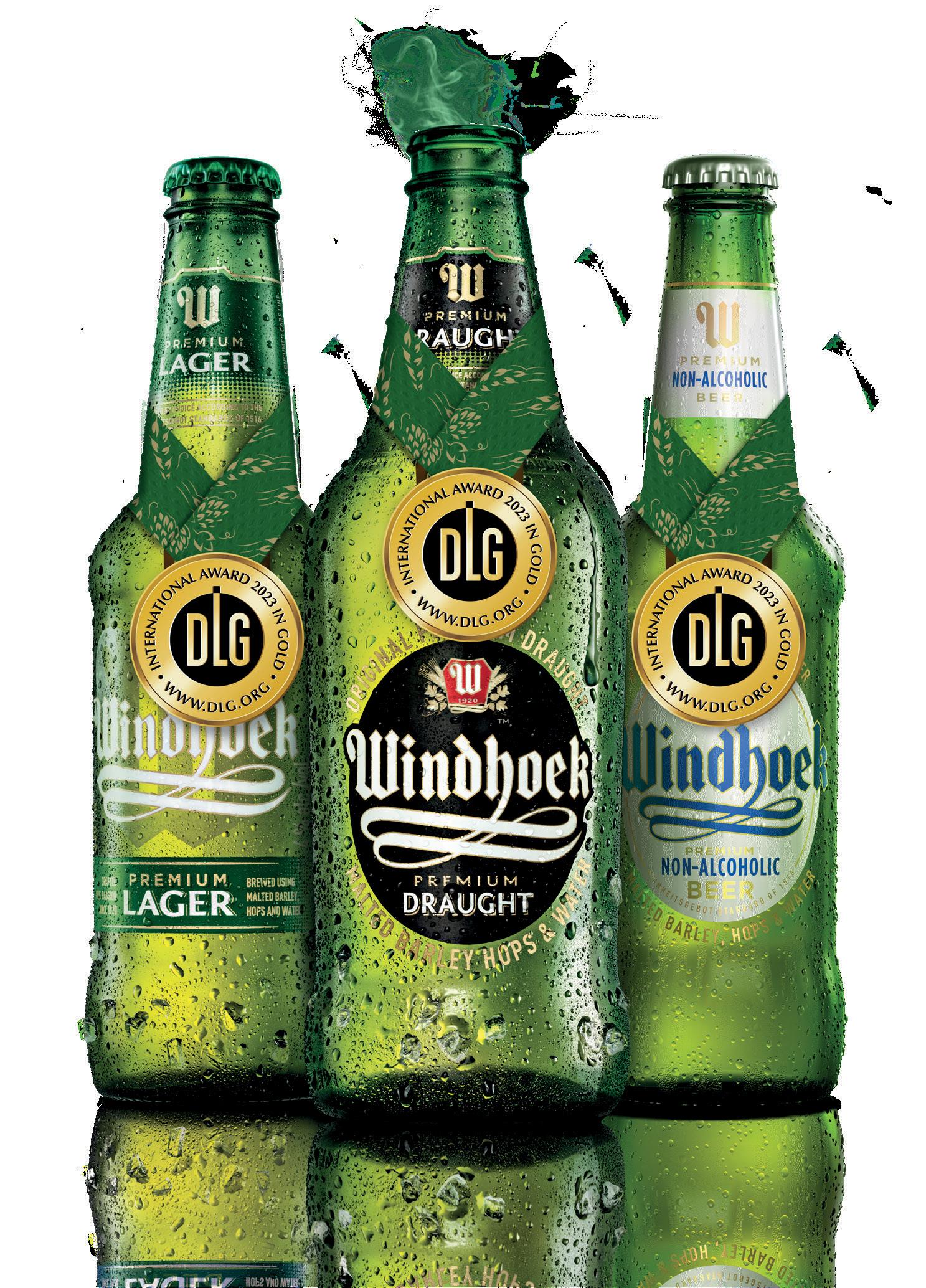
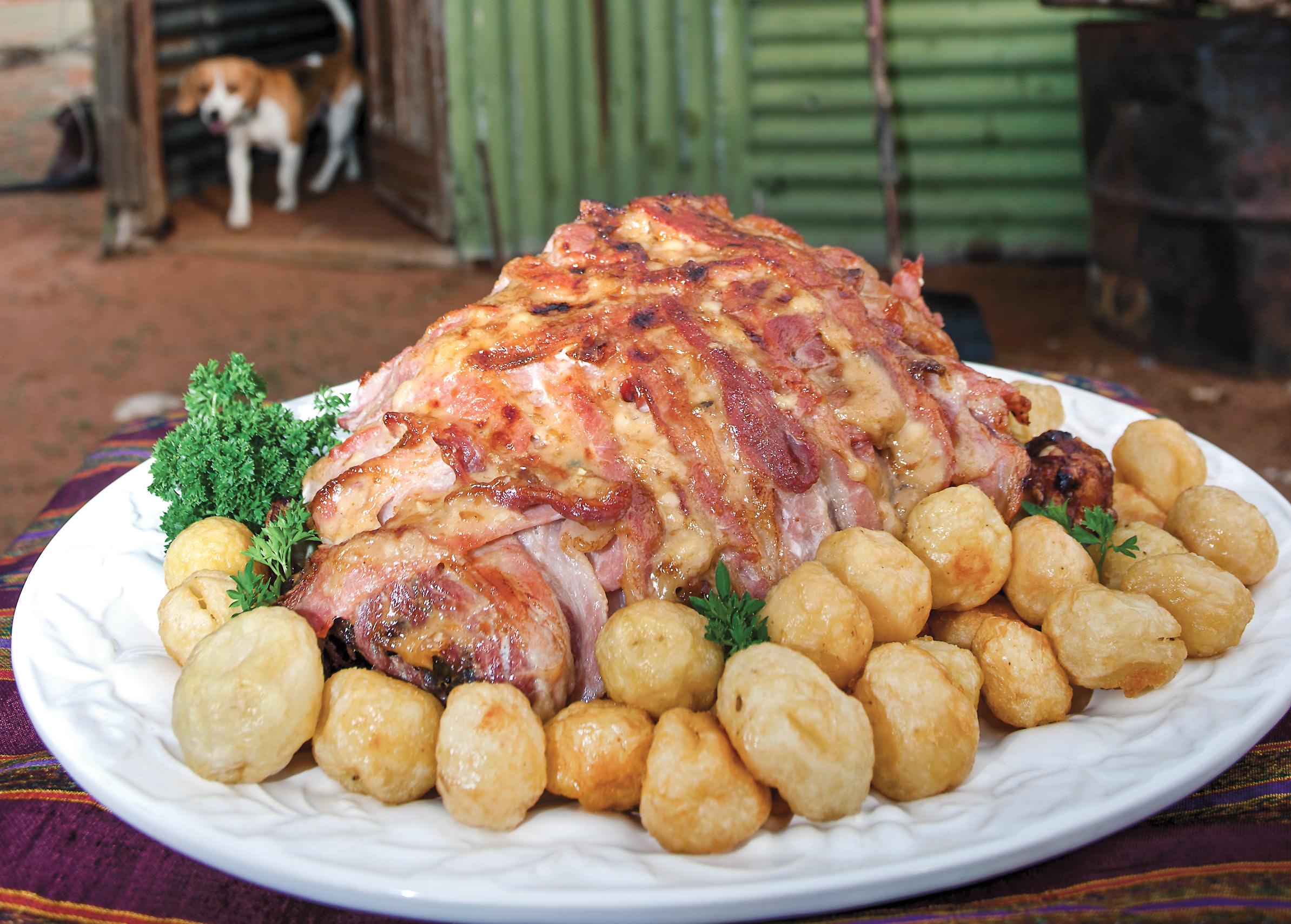
1 leg of lamb on the bone
50 g bacon, cut into short strips
6 cloves of garlic, quartered Salt and pepper
1 sprig of thyme
2 onions, quartered
4 cloves of garlic, extra
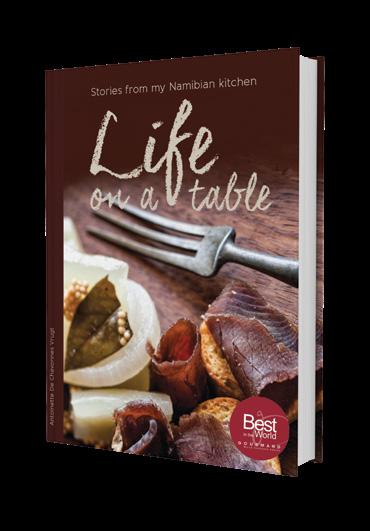
• Slit the surface of the meat and insert the bacon strips and quartered garlic cloves into the cuts.
• Rub with salt and pepper.
• Place in an ovenproof casserole with a lid.
• Put the sprig of thyme on top.
• Position the onions and extra garlic around the meat.
• Bake in the oven for 5–6 hours at 160°C.
Discover more of Antoinette's delicious recipes in Life on a Table
To order your copy contact Bonn Nortjé at Venture Publications: bonn@venture.com.na








A honeybee sits on the windscreen of the aeroplane. The pilot hesitates. It is time to depart, but she does not want to harm the bee. She waits another minute and starts the engine. The propeller spins, and we begin to move forward. The bee ups and goes…
Far below, the landscape moves like a silent movie, backwards through millennia.
The colour fades to sepia. Stubble becomes stretch marks.
Then: barren, dry plains, flat-topped mountains and sandstone cliffs. Petrified energy of spent volcanoes.
Harsh, brutal and breathtakingly beautiful.
We land on a strip of gravel and disembark. In utter disbelief and wonder, my three co-passengers from Mexico observe the strange, new, old world.
How is it possible to be here at the end of the world?
For this is quite literally where we are, having just flown over a tiny dot on the map called Wêreldsend – which means world’s end.
The natural history museum of time, the ancient, unapologetic earth that is Damaraland, the desert that is the last and only one where wild black rhino have adapted to. This is their home. Heaven knows how.
From the airstrip, the specialised Land Cruiser rolls over gravel and rock. I grew up travelling through different terrains in various vehicles, the first of which was an old white Land Rover with very uncomfortable 90-degree seats and a lot of charm.
Since then I’ve experienced every possible mode of transport over rocks and dunes, seas of sand and roaring rivers. This game viewer is unlike anything I have seen before. Everything has been thought through meticulously –ergonomics, comfort, convenience, excellence – from the individual little fridges between solid, comfortable bucket seats – stocked with cold water, beer and cooldrinks – to the tiny binoculars and every possible hook, nook and cranny you might need for holding, hanging, or storing.
“How is it possible?” my new friend from Mexico asks. “How do people build anything here? How do they live here? It is so far from anything.”
After rounding the last bend to the lodge, our driver, Bons, pulls over by a large bush with slender grey-green stems –Euphorbia damarana, poisonous to humans but not to rhinos or gemsbok.
Should humans even be here? I’m not sure that was the plan… And yet, we arrive at Desert Rhino Camp to the welcome
serenade of a jubilant and smiling choir. A wet cloth for dusty hands, welcome drinks and an invitation to enter while other necessary reminders of our previous worlds, like luggage, are swiftly and quietly taken care of.
I learn quickly that the carefully curated airport taxi was just an introduction to how everything is done at Desert Rhino Camp. Mindful. Attentive. Detailed.
The newly renovated Desert Rhino Camp's interior design is understated elegance. It is a haven of organic shapes, textures, and natural hues that feed off the landscape.
Fire circles, cosy corners, and the curvy, elongated lounge and dining space serve as an auditorium from where to gaze at the landscape before you. For all the luxurious aesthetic of the lodge, the landscape demands centre stage, always luring your eyes up and away. As long as you are here, you will remain captive.
You will serve its magnitude and remain under its spell. So you might as well surrender.
It would have been enough, just this.
But then Bons takes us on a sunset excursion.
The gentle rocking of the game viewer. Wind in my hair.
Bons tells us the stories of this 130-million-year-old landscape. He speaks of basalt and oxidation, air pockets and veins that produced cobalt and crystal formations, of how this phantasmagorical place came to be.
I am spellbound. This man knows. He knows the land, the rocks, the history. He knows so much about every bird, antelope and ant. He points out shepherd trees and deciphers faintly visible spoor. But there is a special reverence in his voice when he speaks about them.
“This is it,” he says. “The last desert-adapted black rhinoceros in the world…” We nod.
Bons is not convinced that we grasp the enormity of this phenomenon: “They receive no help, no water pumped to waterholes, no food supplementation or interference whatsoever to make their lives easier. If you were to bring black rhino from elsewhere to live here, they would suffer. These rhinos are the only ones of their kind.”
We are converted. We sense the presence of the prehistoric beasts, although Bons says that the area is so big that it is like finding a needle in a haystack. The only reason there is any chance of encountering them is because of the relentless and diligent work of Save the Rhino Trust, who employ people from local communities and train them to track and guard these prime specimens from poachers.
The power to make cross-border payments lies at your fingertips. By simply using the FNB App or FNB Online Banking, you can easily transact with South Africa, Lesotho and Eswatini (CMA countries) as well as the rest of the world.
Make a global payment on the FNB App
1. From the Menu, select ‘Forex’ then select ‘Global Payments’
2. Select ‘Beneficiary list’
3. Select ‘Pay’ next to the beneficiary
4. Select the account that payment will be made from and enter payment details
5. Select BoP code (reason for payment)
6. Accept the terms and conditions
7. Confirm that the details are correct
8. Accept quote
9. Select ‘Finish’
Make a global payment with FNB Online Banking
1. Select ‘Forex’
2. Select ‘Pay’ next to the beneficiary
3. Select the account that payment will be made from and enter payment details
4. Select BoP code (reason for payment)
5. Accept the terms and conditions and click ‘Confirm’
6. Accept quote
7. Select ‘Finish’

Please note that from 16 September 2024, all transactions to CMA countries must be initiated as a forex transaction and not EFT.
The love story between Desert Rhino Camp and Save the Rhino Trust is a beautiful one. Desert Rhino Camp originated as a field station for rhino protection work and proceeded to join forces with the formidable NGO that is Save the Rhino Trust and engaged with three local communities to join the cause.
Incorporating the local residents as partners in both the hospitality industry and the conservation operation completely changed the narrative and prospects of their communities. For the first time ever, the people here had opportunities to find employment, receive training and develop their potential. People who knew this land better than anyone in the world, who previously had to kill off predators to protect the desperate attempts at keeping livestock and were easy targets for cunning poachers with deep pockets who needed a hand on the ground, now had agency to protect the golden geese that brought them employment, economy and so much pride. And nobody was more equipped to do so than the inhabitants of this land.
My new foreign friends’ excitement at the sight of a couple of giraffes humbles me to the privilege of living in a country where wild, exotic animals are almost taken for granted. I look with new eyes and see, once again, the magnificence.
“A herd of giraffes is actually called a tower of giraffes,” Bons says.
No, we didn’t know that.
Bons whips out a classy sunset cocktail bar in the middle of nowhere. The sun drops like the curtain after a spectacular stage production. We toast to new friends and the wonder of the wilderness around us.
A chilly winter ride back to camp sends us to our rooms for hot showers and proper padding before dinner.
In the luxurious canvas-and-stone tented rooms, everything is, yet again, just so. Lush bedding, colours and textures, light fixtures and power sockets are all exactly where you need them to be, as effortlessly elegant as nature itself.
We meet up for dinner, warm water bottles for our laps. Our waiter, Water, is attentive and intuitive to our every move. My companions and I are at a loss for words yet again. How can a kitchen and a cook produce such exquisite, wonderfully prepared, beautifully presented dishes so far from civilisation?
Ingrid Noeh Tewes had brought her two young adult daughters to Africa in celebration of her sixtieth birthday. “We knew it would be wonderful, but we didn’t expect this. We could never have imagined this…”
To see the beautiful and worldly youngsters equally moved by what they have seen and experienced makes me wonder what exactly it is about this place that transcends age, nationality, culture and experience.
Perhaps this particular corner of the earth is one of the last outposts of pure existence. It resonates with the soul and affects you on a cellular level, an existential, carnal recognition.
It is not for everyone. It is not a zoo. Or a game park for instant gratification.
You work hard to see one of the last remaining desertadapted black rhinos. A whole day’s excursion with an expert guide and the devoted Save the Rhino Trust trackers might secure you a single, or if all the stars align, two or three sightings. It requires having lunch in a dry riverbed (tables, tablecloths, cold wine, gourmet picnic – not an inconvenience by any measure), driving for hours and hours over rough terrain, looking, waiting. It demands tremendous respect and obedience, once located, following the tracker in a single file, only as far as they know you can safely go without disturbing or provoking the rhinoceros.
Exhausted and euphoric, the visitors attempt to relay their impressions of the day back at camp. Sophia has taken thousands of photographs, but not enough. “I don’t want to leave,” she tells her mother.
Me neither.
Around the fire, where the chef is busy with another fivestar barbeque on the grid, Bons tells us stories of growing up in Damaraland. How, as young boys, they would taunt the rhinos, the bravest earning himself the lion’s share of the other boys’ dinners.
Now, when he speaks about these last remaining freeroaming animals with a price on their heads and the very real and continuous threat of their disappearance, it is with reverence and passion. It is evident that he loves his job and he really, really loves his rhinos. “You do not know the difference that you make by being here, investing in our communities, how our lives have changed…”
After a lifetime of living here, he still cannot stop photographing animals, sunsets and trees. He shows us reels and reels on his phone with unwearied enthusiasm. He has seen it all and he keeps on seeing.
Ingrid gives up trying to hold back the tears as the staff sing to us, here under the stars, moving, clicking their special vernacular sounds, humming and dancing. Angelica with the angelic voice. Water with the ready smile and shining eyes, excited that he is learning to drive with the prospect of following in his uncle Bons’ footsteps to become a guide.
The spell of Damaraland and Desert Rhino Camp stayed with me for days after I returned. It changes me every time. Yet I think it changes you back to your selfest self.
Perhaps when the world was created, the dust that I will return to be was already there, waiting for me. Maybe we are all ancient. And I am Damaraland.
Christine Hugo
First published in the Spring 2024 issue of Travel Namibia magazine. Subscribe to Travel Namibia here: www.travelnewsnamibia.zinioapps.com/shop

Africa Online (Africa) (Pty) Ltd is excited to announce a transformative partnership between Utande Internet Services Botswana and Africa Online Namibia. Africa Online has incorporated Utande Internet Services Botswana as a new shareholder that will inject capital into Africa Online in exchange for a significant equity stake, providing a significant boost to the company’s growth and service capabilities. Utande Internet Services Botswana is a subsidiary of Dandemutande Investments Private Limited.
Through this partnership, Africa Online is set to enhance its current product range, introducing new enterprise solutions such as cloud services, cyber security, IT hardware and tracking solutions for vehicles and laptops. These new offerings reflect Africa Online’s commitment to being a reliable ICT solutions partner in Namibia. The company is also expanding its footprint and will be opening a new branch in Swakopmund to further extend its reach and service capabilities.
Speaking on this development, Ingram van Heerden, managing director of Africa Online, expressed his enthusiasm for this new chapter, stating: “Being dedicated to exceptional customer service and continuous innovation, Africa Online has established its strong presence in the Namibian ICT industry over the last 25 years. As we enter into this partnership with Utande, we are confident that together we will be able to provide even greater value to our clients and further strengthen our position in the market. We are grateful for this opportunity and eagerly look forward to the next 25 years of growth and success together.”
Never Ncube, chief executive officer of Dandemutande, added: “We are thrilled to support Africa Online in their mission to enhance their product offerings and expand their market presence. Our partnership forms part of the Dandemutande regional strategy which seeks to transform African industries through cutting-edge digital solutions. Together, we are poised to achieve remarkable growth and deliver unparalleled value to our customers.”
About Africa Online
Africa Online (Africa) (Pty) Ltd is a leading telecommunications provider in Namibia, dedicated to offering innovative and reliable internet services. Powered by a commitment to innovation and customer satisfaction, Africa Online continuously strives to improve and expand its service offerings to meet the growing needs of its customers. www.africaonline.com.na
About Dandemutande
Dandemutande Private Limited is a licensed internet access provider in Zimbabwe with over 27 years of experience in the telecommunication industry. Dandemutande is committed to providing the most up-to-date ICT solutions to corporates and businesses of all sizes. It offers a comprehensive suite of ICT solutions, including connectivity, cloud solutions, security, hardware, software and value-added services such as asset management and training. www.dandemutande.africa
For further information, please contact: Africa Online (Africa) (Pty) Ltd
36A Promenaden Road, Windhoek, Namibia
Phone: +264 61 291 1000
Email: info@africaonline.com.na
Media contact
Ingram van Heerden – Managing Director
Email: ivanheerden@africaonline.na
The Bank of Namibia's fourth monetary policy announcement of the year took many by surprise, as the central bank opted to reduce the interest rate by 25 basis points, lowering the repo rate to 7.50% and the prime rate to 11.25%. This marks the first rate cut since the hiking cycle began in June 2022, positioning Namibia 75 basis points behind South Africa. While the rate remains relatively high, this decision offers some relief to Namibian households and businesses by reducing borrowing costs. Our initial expectation was for rates to remain unchanged, with a potential cut later in the year. However, the Bank of Namibia chose to act sooner.
The reduction in the repo rate is expected to lower borrowing costs across the economy, potentially revitalizing private sector credit extension, which has been subdued in recent months.


This move could stimulate economic activity as businesses and households gain confidence in a less restrictive monetary environment. Looking ahead, we anticipate further rate cuts in 2024, including an additional 25 basis points reduction towards the end of the year. Such continued easing of monetary policy is likely to support sustained economic growth, with GDP projected to reach 3.6% in 2024 and 3.8% in 2025.
As we transition into 2025, Namibia's economic growth is expected to be driven primarily by three key sectors: tourism, consumer spending—bolstered by improved credit conditions due to lower interest rates—and mining. These sectors are set to benefit from the more favorable monetary environment, which is expected to persist as rates continue to decline. The anticipated rate cut at the end of 2024 should further ease borrowing costs, supporting both consumer demand and business investment, thereby fostering broader economic expansion.
Regarding the currency outlook, we project the Namibian Dollar to trade at 18.30 to the US Dollar by the end of 2024, with a slight appreciation to 18.10 in 2025. This forecast reflects a relatively stable currency environment, underpinned by prudent monetary policy and improving economic fundamentals. The expected appreciation in 2025 aligns with Namibia's broader economic recovery, driven by growth in key
Simonis Storm is known for financial products and services that match individual client needs with specific financial goals. For more information, visit: www.sss.com.na
sectors and favorable external conditions. Currency stability will likely bolster investor confidence and contribute positively to the broader economic landscape as the country navigates global economic uncertainties.
In South Africa, the economic outlook is cautiously optimistic. The newly formed government is creating favorable conditions for economic recovery, with significant progress observed in Operation Vulindlela. While challenges remain, particularly with Eskom and Transnet, there are signs of improvement, although the path to full resolution is likely to be lengthy. Growth in South Africa is expected to remain subdued in the near term. However, we anticipate that potential rate cuts in September 2024 and in 2025 could stimulate the economy, benefiting both consumers and businesses. These developments are expected to have a positive spillover effect on Namibia, particularly through trade and investment channels.
In conclusion, while challenges remain, the combination of monetary easing, sectoral growth drivers, and currency stability positions Namibia for a favorable economic outlook in 2025. With careful monitoring of inflation risks and strategic policy adjustments, the economy is poised for sustained growth as the year progresses, supported by a robust foundation in key sectors and a stable currency.


10 minutes with local tastemakers
Along while away from the village in the north where she was born and raised, on a disco-lit stage, in a full hall and over ten thousand streaming viewers, Prisca Anyolo was crowned Miss Namibia 2024 in Lüderitz. Two weeks later, scurrying from dress fittings to coaching sessions, I sat down with the journalist and content marketer who will wear our country across her chest and on her shoulders at the Miss Universe 2024 pageant in November.
Many beauty queens’ journey to holding the national title, not unlike the path to success of many everyday individuals, has started with a hard “no.” When Prisca took part in Miss Namibia 2021 and didn’t get the job, she was heartbroken. While admitting that the experience took its toll on her mental health, the queen reiterated that “failure is not a reflection of your efforts.” She gave the pageant her all, but it just wasn’t her time to win the crown. Prisca dusted off her platform heels in December last year and began rigorous training and preparation for the pageant, determined to rise to the occasion in her last year of age eligibility. She insists that claiming your second chances is key to building the life you desire. “Nobody owes you anything, it’s up to you to go out there and get it,” says Prisca.
Besides being a pretty, pintsized, multiple pageant title winner, it’s Prisca’s advocacy work that undoubtedly set her apart in the eyes of Miss Namibia’s judging panel. Crowning Gardens in collaboration with Urban Harvest focuses on food security and subsistence farming capacity building for local communities. Raised by her grandparents in rural Namibia, Prisca grew up cultivating a green thumb. It

made perfect sense then for her to apply this knowledge and passion to what she gives back to Namibia. Crowning Gardens, which saw its first soil-based garden pilot in Havana, Katutura, aims to educate Namibians about the importance of nutrition through fresh fruit and veggies and create community gardens where the shared responsibility and output help eradicate poverty. Prisca’s goal is to teach Namibians how to grow their own food, so that they may be fed for a lifetime.
Working as an entertainment television presenter in Dubai for a few years following her work as Namibian delegation at the Dubai 2020 Expo, Prisca returned home with a heavy heart. She chose to chase a big dream of working and living internationally, and speaks earnestly about the disappointment of that dream not panning out as planned. Working multiple jobs in Dubai to make ends meet and feeling the pressure of returning somewhat defeated, it was her parents who gently gestured to her to come home and close that door. Luckily, she is a glass-half-full kind of person and kept on knocking. “Imagine if I let my own limiting beliefs stop me,” she says. Well, then Prisca surely wouldn’t be wearing “Namibia” in all caps on a sash, where she is representing our nation at Miss Universe in Mexico during
Curious about the frequently cited “sisterhood” in pageantry, I ask Prisca if it exists. She insists it remains integral. We cannot ignore the element of competition, but this beauty queen believes that if the other women on that stage look good, so do you, and vice versa. In rehearsals for Miss Namibia 2024, Prisca admits that she was not a ‘twirler’ and sought guidance from her fellow finalists on how to ace her pageant walk.








































Nobody owes you anything, it’s up to you to go out there and get it,” says Prisca.
The key to this so-called sisterhood is knowing what sets you apart, and what you bring to the table. This way, a queen like Prisca can share a tip from her black-book, and executed by another unique woman, the outcomes will be entirely different. Let this be a note to us laymen that fixing someone else's crown doesn’t diminish the sparkle of your own.
Preparing for the stage appearance of a lifetime is nerve wracking, no doubt. Doing it in three months, the endless outfits, interviews and remaining present for the journey, that’s a challenge. Luckily, our Prisca was preparing for Miss Namibia as if it were Miss Universe. She did not hold back on this journey, admitting that she might have been a bit extra in the process. As demure and introverted as Prisca might be, she’s a stickler for preparation and says “That’s when I know I’m on the right track, when people tell me I’m doing too much.”
A precious symbol of the Namibian people, Prisca will certainly carry our flag high on that stage. Yet, it is what’s in store for her return home, the work in food security, poverty alleviation and female empowerment that we hope to see her carry out across our nation, that will leave its lasting impact on the hearts of the land of the brave.
Charene Labuschagne




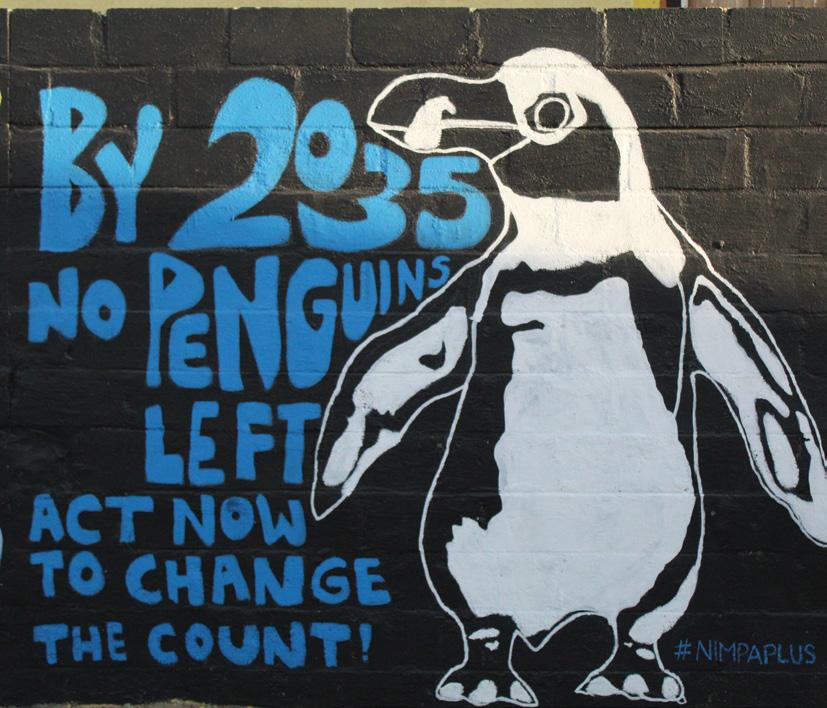


Namibia’s only marine protected area (MPA) is grappling with a multitude of threats, including overfishing, illegal fishing, climate change, pollution, habitat degradation, extractive activities and a general disconnect from the value of marine life. These challenges pose significant risks to the survival of marine species and the livelihoods of coastal communities. In response, the Namibia Nature Foundation (NNF), in collaboration with several partners and the government, has launched an innovative initiative aimed at strengthening the management and conservation of Namibia’s MPA and raising awareness about its value, particularly among the youth.
The Waves of Change mural project is an exciting and creative endeavour designed to engage coastal communities, especially young people, on the importance of marine conservation. This art project uses colourful murals painted around the coastal town of Lüderitz to share vital messages about marine life and pollution, showcasing the beauty of marine conservation and encouraging communities to take positive steps towards a healthier environment.
Depicting various marine species, the impacts of pollution and the importance of sustainable practices, the murals not only beautify the town of Lüderitz but also serve as constant reminders of the community’s role in marine conservation.
Collaborative effort
The NNF has teamed up with organisations such as the Blue Marine Foundation, GRID-Arendal, South Atlantic Environmental Research Institute (SAERI), Southern African Foundation for the Conservation of Coastal Birds (SANCCOB), Namibian Foundation for the Conservation of Seabirds (NAMCOB) and Community Skills Development Centres (COSDEC) Benguela. This coalition, in partnership with the government, is dedicated to addressing the
pressing issues facing Namibia’s MPA. Their goal is to strengthen the management and conservation efforts of the MPA while also fostering a greater appreciation for its value among the general public. The initiative also aims to improve the livelihood opportunities for coastal communities by promoting sustainable practices and enhancing their connection to the marine environment. By fostering a sense of ownership and responsibility towards the MPA, the project encourages communities to engage in activities that support conservation efforts.
“Next year, we look forward to collaborating with future partners, and the Lüderitz Town Council again, to engage with schools in Lüderitz, further promoting marine conservation awareness among coastal communities,” says Sunnypo Imalwa, communications support officer at the NNF.
According to Imalwa, the NNF envisions the future of marine conservation efforts to be vibrant and sustainable, hoping to see enhanced community engagement, stronger collaborative networks, increased public awareness and education, policy influence and advocacy, sustainable economic models as well as continuous learning and innovation. She adds that they are actively working together with the government to include ocean literacy in the Namibian school curriculum.
By involving young people in the creation and appreciation of these murals, the project hopes to cultivate a longlasting respect and care for the marine environment. In conjunction with the mural project, educational programmes and workshops provide young participants with the knowledge and skills needed to advocate for marine conservation.
Maggie Forcelledo Paz
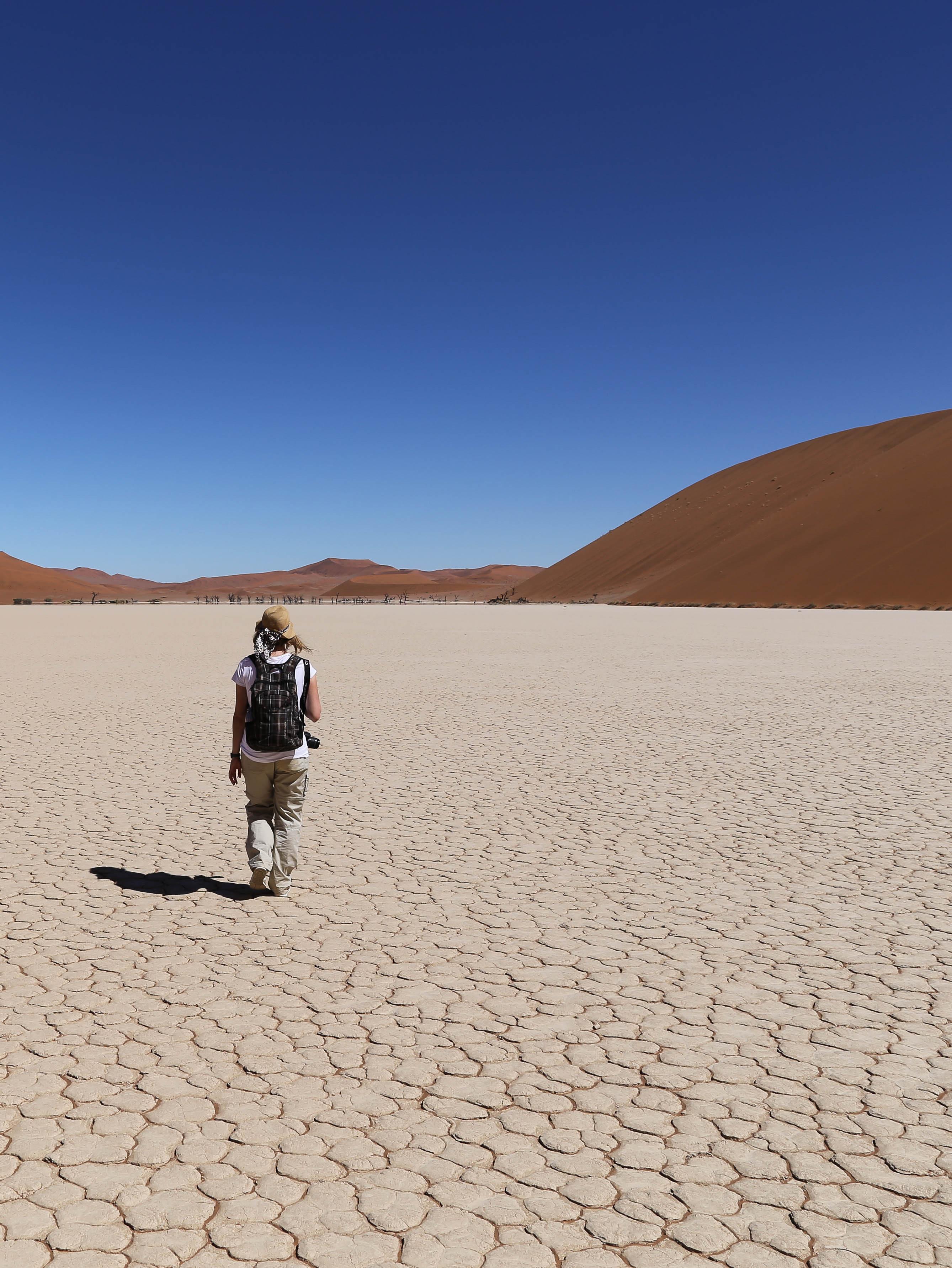
Tourism and hospitality builds the economy, by creating jobs, earning foreign currency, and supporting other sectors, such as transport and logistics. The Development Bank of Namibia understands that tourism is a roadmap to the future, which is why we give more flexibility and support to the sector, and more thought to the ideas, visions and plans of our applicants.
If you have a business plan for tourism and hospitality, call 061 - 290 8000, and expect more.

www.dbn.com.na


Monster: A Memoir by Jennifer
Romolini
For years, Romolini climbed the professional ladder to achieve high-profile success, a soughtafter C-suite position, and a celebrated book, all while presenting a picture-perfect life with her husband and child in Los Angeles. Yet, beneath this veneer, she was unravelling. Written with wit and self-deprecation, Ambition Monster examines workaholism, the addictive nature of achievement, and the haunting effects of childhood trauma. This anti-girlboss tale offers a candid critique of the modern rat race and the cost of capitalism, making it a must-read for overachievers and those driven by their past traumas. Romolini's story is a timely deconstruction of the American Dream, inspiring readers to always bet on themselves.
Goodreads score: 4.08/5

This podcast’s full title is Finally! A Show About Women That Isn’t Just a Thinly Veiled Aspirational Nightmare, breaking away from typical portrayals of women by focusing on the real, unfiltered details of their daily lives. Each episode features a different woman sharing her experiences and worldview, whether she's a Pike’s Fish Market worker who’s also a folk singer, an Instagram-famous octogenarian, or Grammy-nominated artist Valerie June. The podcast ditches the traditional host format, allowing the women's stories to shine on their own, making it a compelling and authentic listen.

This sharp social satire series with two seasons follows the chaotic exploits of both guests and employees of the fictional White Lotus resort chain. Over the course of a seemingly idyllic week, vacationers seek relaxation and rejuvenation, but as days pass, darker complexities and dysfunctions emerge among the picture-perfect travellers and the hotel's cheerful staff. With its biting humour, striking cinematography and intricate character dynamics, The White Lotus offers a captivating glimpse into the darker side of paradise.
Tomatometer: 90%
Our monthly round-up of good books, podcasts, movies and series.

Our Kind of Game by
Johanna Copeland
A serpentine suspense tale that delves into the violence men inflict on women, women's reclamation of their identities, and the haunting effects on their children. In 2019, Stella Parker’s perfect life in Washington, D.C., unravels when her neighbour Gwen reveals a dark secret from Stella's past. Flashback to 1987, Julie Waits dreams of cheerleading to escape her tumultuous home life. As Stella investigates Gwen's claims, a chilling connection between her and Julie emerges. This gripping novel is packed with twists and explores women's struggles for control and the lasting impact of violence.
Goodreads score: 3.80/5

Journalist Evan Ratliff takes on the overwhelming buzz around artificial intelligence by experimenting with publicly available AI tools to uncover their limitations. Through his explorations, Ratliff seeks to reclaim a sense of control in a rapidly changing tech landscape. While the series may have its uneven moments, the core of Ratliff’s journey – pushing back against the AI hype and defending human experience – makes for an engaging and thought-provoking listen.

After a fateful meeting at a local bar, the strong-willed Kathy (Jodie Comer) finds herself irresistibly drawn to Benny (Austin Butler), the latest recruit of the Midwestern motorcycle club, The Vandals, led by the enigmatic Johnny (Tom Hardy). As the country and the club evolve, what begins as a haven for local outsiders turns into a perilous underworld of violence. Benny faces a gripping dilemma: choose between his love for Kathy and his loyalty to the club. This film promises an intense journey through love, loyalty, and the spirit of cultural transformation.
Tomatometer: 80%


A man who lives life with a dash of flair and a whole lot of heart.

Over the next year, he will be travelling to FlyNamibia destinations, and sharing his experiences (like that of flying for the first time) with all of us. We’re thrilled to have him as part of our fly family, and can’t wait to see what this kind and gentle man with a contagious smile has in store for us.
But before we start our journey together with David, let us meet the man behind the incredible social media following, in a series of offbeat insights into his life. So, world, meet David!
Breakfast Faves
Ah, breakfast cereals—a staple of childhood mornings. For David, it was all about Jungle Oats. “Let’s just say we left it in childhood,” he chuckles. These days, cereal has taken a backseat in his life’s menu. “I’m not a fan of cereal anymore,” he admits. Seems like David’s grown up, and his breakfast tastes have, too!
The Sweet Surprise of Baking
Speaking of grown-up adventures, David’s most unexpected

hobby is baking. What started as a spontaneous fling with flour and sugar has turned into a full-blown business. “Baking! It started off spontaneously and it turned into a business,” he says with a grin. Looks like David’s love for the culinary arts was more than just a passing phase!
Scent of a True Grit
If David were to concoct his own signature scent, it wouldn’t be something from a fancy lab. Nope, it would be a mix of kindness, compassion, and integrity. “These are the ingredients that truly represent my personal brand,” he explains. Now that’s a fragrance worth smelling!
The Eureka Moment in the Oddest Place
Every great idea has its origin, and for David, it came from a rather unexpected spot: the realm of uncertainty due to unemployment. “It propelled me to explore self-employment through my hobbies; baking and content creation,” he reveals. Sometimes the best breakthroughs come when you’re least expecting them.
David’s Ultimate Playlist
When it comes to music, David’s life soundtrack has some serious depth. His top three tracks? “Definitely ‘Nekwa Lyatsima’ by Ras Sheehama,” he says, “This song keeps me grounded and reminds me of where I’m from.” Next up is Ed Sheeran’s “Photograph,” a nostalgic nod to his university days filled with love and friendship. And rounding out the trio is “Capable God” by Judikay, David’s anthem of faith and reassurance. “This is my reassurance song,” he explains, “It reminds me that no matter the situation, God is capable and in control.”





process that led to such an invention.” Imagine discussing the evolution of communication with the guy who started it all!
If David were to concoct his own signature scent, it wouldn’t be something from a fancy lab. Nope, it would be a mix of kindness, compassion, and integrity.
A Fictional Connection
David’s childhood hero? Alex Rider, the daring spy from Anthony Horowitz’s novels. “My love for adventure has been influenced by such characters,” David says. “I’ve always been daring and willing to try new things.” Who knew a fictional spy could inspire such real-life daring?
The Quirky Bag Essential
You might expect a lot of things in David’s bag—maybe a phone, a wallet, or some snacks. But there’s one quirky item he always carries: sunscreen. “I reapply it two to three times a day,” he insists. It’s clear that David’s not just protecting his skin but also staying sun-smart on the go.
Dinner with a Historical Game-Changer
If David could have dinner with any lesser-known historical figure, it would be Alexander Graham Bell. “Being a content creator, I make use of my cellphone for most of my business activities,” he notes. “It would be great to hear his thought
Teenage David Meets Entrepreneurial David
If David could chat with his teenage self, he’d talk about becoming an entrepreneur. “Younger David thought he had his life figured out,” he laughs. “He’d be in disbelief about how life turned out.” Sometimes, the journey to selfemployment is as surprising as it is fulfilling.
Packing Essentials for the Ultimate Trip
If David could pack only three things for a trip, his choices are practical yet stylish. “A cologne, because smelling good is essential,” he starts. Next, a good pair of sneakers for getting around, and finally, a jacket, because “an outfit always feels incomplete without one.” Classic, functional, and oh-so-David.
In his year as the Face of FlyNamibial David aims to showcase the potential within our beautiful Namibia and create awareness on the importance of self-development and investing in one's future. His message, through showcasing FlyNamibia’s destinations, is one of empowerment and the tenacity to be the pilot of your own destiny.
It’s clear that whether he’s baking up a storm or crafting a personal scent, David lives life with a dash of flair and a whole lot of heart!
Charene Labuschagne



SATURDAYS @16:00




Imagine being a subsistence farmer in the Ruacana area of Namibia – if you do not live near the Kunene River, Namibia’s northwestern border with Angola, your primary water source is likely to be the local borehole. The only way to extract this water is with a diesel-driven engine. As a subsistence farmer in the mopane-dotted landscape, money is hard to come by, yet every month you must make a contribution with the rest of the community to buy diesel to power the engine and pump water for each household. Sometimes the engine breaks down and needs to be taken to far-off Opuwo for repairs, leaving the community without water for several days. Your much-valued goats and cattle cannot access this water, as it would increase diesel costs. Instead, livestock must be taken to a water point 15 or more kilometres away – a journey made even more challenging by the scorching summer temperatures, which can easily range from the mid-30s to over 40°C.
Through the Namibia Integrated Landscape Approach for Enhancing Livelihoods and Environmental Governance (NILALEG) project, communities like these have been targeted to achieve the project’s main goal of improving living standards by reducing land degradation and integrating agriculture and forestry management. The beneficiaries are part of the Ruacana landscape, one of five landscapes identified in the country’s north as part of the project. The Ruacana focal landscape features two distinct topographies and stretches over parts of the Omusati and Kunene regions.
NILALEG rehabilitated three existing boreholes in the villages of Otjovanatje, Okauapehuri and Ongete and drilled a new one in Ombambihaka. The project included the installation of solar panels, electric water pumps, water tanks, troughs and protective walls around the installations in these Ovahimba villages.
“The situation was tough because we were using a diesel pump. It was difficult to buy diesel and to go fix the engine in Opuwo. Now, with the solar system, everything is very easy. We have constant access to water, our livestock drink daily and the farmers’ association also benefits through the
garden project,” says Gabriel Kajakurapo, the chairman of Ongete’s water committee.
Another initiative of the project was to set up water committees for each village. “The water committee was introduced to protect the water points at the borehole. We make sure all the livestock in the community get access to the drinking troughs and have a turn to drink water. We also ensure everything is in working order so that the community always has water,” explains Mavejaruka Tjiuma, the vice chairperson of the water committee at Okauapehuri.
In addition to being a member of the water committee, Mavejaruka is a grateful member of the community whose life has been greatly improved thanks to the project. “Due to the lack of water points, we sometimes had to fetch water from other villages. It was a struggle to go about our daily activities at home, doing basic tasks like cooking. We now have a water line that runs to the village, where everyone can collect water. We can make food on time now, and it is easier to feed our children,” she says.
Not only do the households benefit but farming practices have also been simplified. “Our animals no longer have to travel long distances for water. No one has to spend long hours with the animals in the veld searching for water. Our livelihoods are improving as we now have constant water close to the village, and our livestock numbers are increasing,” says Uaraja Kavari, the chairman of Okauapehuri’s water committee.
Funded by the Global Environmental Facility through the United Nations Development Programme, NILALEG is a fiveyear project which was officially launched in 2020. Through the implementation of natural resource management solutions, the project has reached more than 20,000 direct beneficiaries across the five focal landscapes.
Spearheaded by the NILALEG project, that is implemented by the Ministry of Environment, Forestry and Tourism in partnership with the United Nations Development Programme and funded by the Global Environmental Facility.



You cannot miss him. With his piercing stare, tousled brunette mane and rock-solid abs, Ruan commands attention on and off the runway.
Judging by his confident stride, one could be forgiven for thinking he has been modelling for a long time. However, Ruan only came into the spotlight in 2019 when a friend asked him to model his garments.
“I had a great connection with the photographer, so we did an editorial afterwards. He and the make-up artist believed I had a lot of potential, shared my contact details with people looking for models and that’s how my professional career took off in Windhoek,” he recalls.
Fast-forward a few years later, Ruan remains a regular at the biggest fashion event in the country, the MTC Windhoek Fashion Week. In fact, he has been a constant feature since his debut at the event in 2021. “Windhoek Fashion Week is like a community for me. From the fitting selections to the model bootcamp, they take the initiative to create a full experience for models. There’s a lot of learning, laughing and joyous moments. I am extremely grateful for what Namibia’s biggest fashion event has taught and shown me,” he says while pointing out that Rundu-based designer Santia Poroto was his favourite designer during his first year at the fashion week.
Ruan has big dreams for his career, listing getting booked for corporate shoots in Namibia as a short-term goal and walking for American designer Calvin Klein as a longer-term goal. “I would love to dip my toes in the high-fashion industry!” he proclaims matter-of-factly.
And while he loves being in front of the camera and acting as a muse, Ruan also dreams of launching his very own brand – RA by Ruan. While still in the incubation phase, Ruan envisions the brand coming to life and making its mark.
So how does one of Namibia’s “it boys” of fashion get into the zone before a big job? This focused young man believes in
Ruan advises young aspiring male models to find their “vibe” and strive to be expressive and authentic, and to put themselves out there.
caring for the body that works for him. “I prepare physically for modelling jobs by incorporating callisthenics and cardio into my routine.”
Asked what his preferred type of modelling work is, Ruan says he would choose editorial shoots any day. “Editorials allow me to express my individuality. I shot my first editorial in the thendry Avis Dam. It was cold and windy, and the sticks went into my shoes, but it was worth the experience,” he recalls.
Ruan describes his style as grungy and flamboyant, with a dose of elegance. “As a male model, I enjoy expressing the polarity within each of us. You can see that in my desired style, editorials and on the runway, I tend to break down the boundaries of male and female expression,” he says.
He is determined to grow as a model and see the industry thrive. He acknowledges that the Namibian fashion industry has evolved and that models have increased opportunities today. He further notes how the sector has consistently provided better representation of the Namibian population, saying, “We are moving away from using international ad campaigns to being more inclusive with locals, thereby improving familiarity and connection with the end customer”.
Currently, the brand Ruan admires the most is Zuriel by Luis Munana. He has worked with Zuriel on multiple occasions, including the recent Zuriel x Chivas Regal collaboration. Still on his radar of brands to work with is Sitwala, the menswear brand that Ruan describes as “very elegant”.
Ruan advises young aspiring male models to find their “vibe” and strive to be expressive and authentic, and to put themselves out there.
His parting words ring true to his passion and drive to make it on the big stage: “Climb out of your comfort zone, attend fashion meets and events, and network!”
Rukee Kaakunga






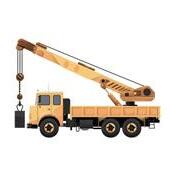




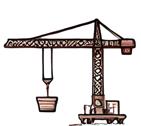
















While reading through the proof of last month’s column, I noticed for the first time that what I had written had been edited. I am sure that it was not the first time it has happened, and I am not sure why I had never noticed it before.
Anyway, that is not the point. The point is that I am not sure what the correct response to having your work edited is (probably just casually accepting that it is part of the writing and publishing process and moving on), but I am pretty sure it is not descending into a massive downward spiral of self-doubt where the voice inside your head tries to convince you that you are clearly terrible at writing and should probably just stop doing it altogether.
Don’t worry, I have not told you this to seek validation, nor is this column going to be a “pity party for poor old David”. Instead, I want to touch on what causes those negative voices. It is a concept that most of you reading this column are probably already familiar with, and one that many of you may experience, or possibly have experienced before. It is the concept of “imposter syndrome”. In fact, so common is imposter syndrome that Erin Michel writes in an article for the Graduate College at the University of Cincinnati that “at least 80% of the general population [will] experience it at some point in their lives”.
For those of you who are fortunate enough to not know about it, imposter syndrome is the feeling in people that they have not earned what they have achieved or that they are a fraud. They believe that they are not as good at something as people think they are, and they are just managing to fake it. They experience the fear that, as clinical psychologist Dr Audrey Ervin explains, “they’re going to be ‘found out’ or unmasked as being incompetent or unable to replicate past successes”.
In one of my favourite anecdotes by the author of bestsellers like Coraline , Stardust and American Gods (or, if you are more of a Netflix person, Lucifer or The Sandman ), Neil Gaiman shows how no one is really immune from feeling it:
Gaiman talks about how he was at an event being attended by the world’s “great and good people” and found himself standing at the back of the room, dreading the moment everyone there would realise that he did not belong. While there, he says, he started talking to an elderly gentleman with whom he shares a first name and at some point in
the conversation the other Neil turned to him and said: “I just look at all these people, and I think, what the heck am I doing here? They’ve made amazing things. I just went where I was sent.” To which Neil Gaiman replies: “Yes. But you were the first man on the moon. I think that counts for something.”
What Gaiman says he took away from the encounter was that “maybe there aren’t any grown-ups, only people who have worked hard and also got lucky and are slightly out of their depth, all of us doing the best job we can, which is all we can really hope for”.
While a little bit of self-doubt is probably not a bad thing, and imposter syndrome can, in certain cases, lead to growth, it can also stifle that growth and lead to increased feelings of anxiety and depression, and cause people to not live up to their true potential.
One of the best ways suggested to deal with the feelings of imposter syndrome is to recognise it for what it is and keep in mind that it is fleeting. Psychologists point out that it is not even a clinical diagnosis and should therefore rather be called imposter “phenomenon” or “experience”. While it is definitely a case of “easier said than done”, they also suggest that you “call yourself” on it. For example, rather than letting yourself spiral and start believing that you should stop writing altogether because your work was edited, stop yourself and realise that if your writing was really that horrible it would not just be subjected to some editing – the publishers would probably tell you outright that they no longer want you to write for them.
Other suggestions for dealing with the phenomenon (which may also be easier said than done) are letting go of perfectionism, being kind to yourself, celebrating your victories and being able to look back on them as facts. And accepting that, while the feeling is fleeting, you are sure to feel it again sometime in the future, but that when you do you will be better prepared to deal with it.
If you do suffer from the same feelings as I do, I hope some of this helps.
Until next month (provided that my imposter episode wasn’t right after all and they do decide that my writing is rubbish!), enjoy your journey.
David Bishop






In his first six months in office, President Nangolo Mbumba has navigated Namibia through a period of profound change and challenge following the passing of his predecessor, Dr Hage Geingob, in February 2024. Reflecting on this transition, President Mbumba has demonstrated a steady hand in guiding the nation through mourning and uncertainty, steering the country towards a phase of recovery and progress.
Despite the difficult circumstances of assuming office, President Mbumba has made significant strides in stabilising the country and advancing key priorities. His approach has been marked by a commitment to dialogue and collaboration with industry leaders and political figures alike. According to the presidential press secretary, Dr Alfredo Hengari, President Mbumba has sought to address challenges and foster solutions that resonate with the broader needs of Namibians.
With the presidential and National Assembly elections in November 2024, the president has engaged with political parties to ensure a peaceful and stable electoral environment, emphasising the crucial role of political stability in facilitating national development and calling on all parties to uphold this principle.
“The economy is showing signs of recovery, with a reported 4.2% growth last year and a positive outlook for the current year. Inflation rates are decreasing due to effective macroeconomic policies, and efforts are underway to enhance Namibia’s competitiveness as an investment destination,” said Hengari. Notably, President Mbumba has championed the green hydrogen sector as a strategic priority with his recent visit to Lüderitz. The green hydrogen initiative, alongside the establishment of a joint venture with Belgian partners in clean energy, highlights the country’s tangible steps towards combating climate change and creating employment opportunities. According to Hengari, over US$500 million has been invested in the green sector to date, resulting in more than 300 permanent jobs. The mining sector, particularly oil and gas, continues to show promising prospects, attracting significant global investment. “These developments reflect President Mbumba’s ongoing efforts to address youth unemployment and drive economic growth,” Hengari added.
As the president continues to address pressing issues in Namibia, the health sector remains a key priority. Recognising that a healthy nation is a prosperous nation, the president is committed to enhancing both the accessibility and quality of healthcare services across the country with recent initiatives that include the potential establishment of new clinics in
Nkurenkuru and the groundbreaking ceremony for a new hospital in Katutura. “These developments reflect the government’s ongoing efforts to meet the growing demand for healthcare services due to population growth,” said Hengari.
According to the press secretary, President Mbumba remains focused on expanding and upgrading health facilities to better serve Namibians, despite fiscal constraints which include the economic challenges from the commodity cycle bust and the impact of Covid-19.
In terms of the education sector, the government has secured a loan from the African Development Bank to improve school infrastructure, with approximately 500 new classrooms built in the past year to accommodate more learners. Ongoing efforts are also directed towards enhancing teacher training and ensuring that educational qualifications meet high standards. President Mbumba, a former education minister, emphasises the importance of aligning educational programmes with the demands of a modern economy, advocating for students to pursue fields relevant to economic growth, such as green technology, engineering and advanced healthcare specialist fields, in preparation for the fourth industrial revolution. In terms of social support programmes, the president is working to expand the school feeding programme, which currently benefits around 400,000 students. Hengari notes that while resources are limited, the government is taking incremental steps towards a broader implementation of a basic income grant. Presently, over 40,000 Namibians benefit from a modified basic income grant, and 200,000 elderly citizens receive old-age pensions. Despite resource constraints, the government is committed to maximising the impact of available funds to support vulnerable populations.
Mbumba was recently bestowed the honour of The Most Ancient Order of Welwitschia Mirabilis, an accolade that recognises individuals who have made significant contributions to the nation. “I want to thank the great people of our beloved nation, the Land of the Brave, for the trust and confidence you have vested in me during my current tenure and in my various portfolios. Words cannot express fully the depth of my gratitude and emotions. However, I thank you all, wholeheartedly, for bestowing upon me this great honour,” said Mbumba. The president has expressed his desire to retire from active public service for the government. “I think we all agree that his contribution to our republic has been exemplary,” Hengari added.
Maggie Forcelledo Paz

Popa Falls Resort Gross Barmen Resort
Khorixas Camp Hardap Resort
Discover unparalleled conference facilities amidst breathtaking natural landscapes with Namibia Wildlife Resorts. Host your next event at Popa Falls Resort, where the serene Okavango River meets nature’s tranquility. Gross Barmen Resort offers a rejuvenating retreat, blending wellness with state-of-theart conference amenities. At Khorixas Camp, immerse yourself in the rich history of ancient civilizations while enjoying modern conference conveniences. Lastly, Hardap Resort presents a lakeside haven, perfect for inspiring creativity and fostering collaboration. Elevate your conference experience with us!

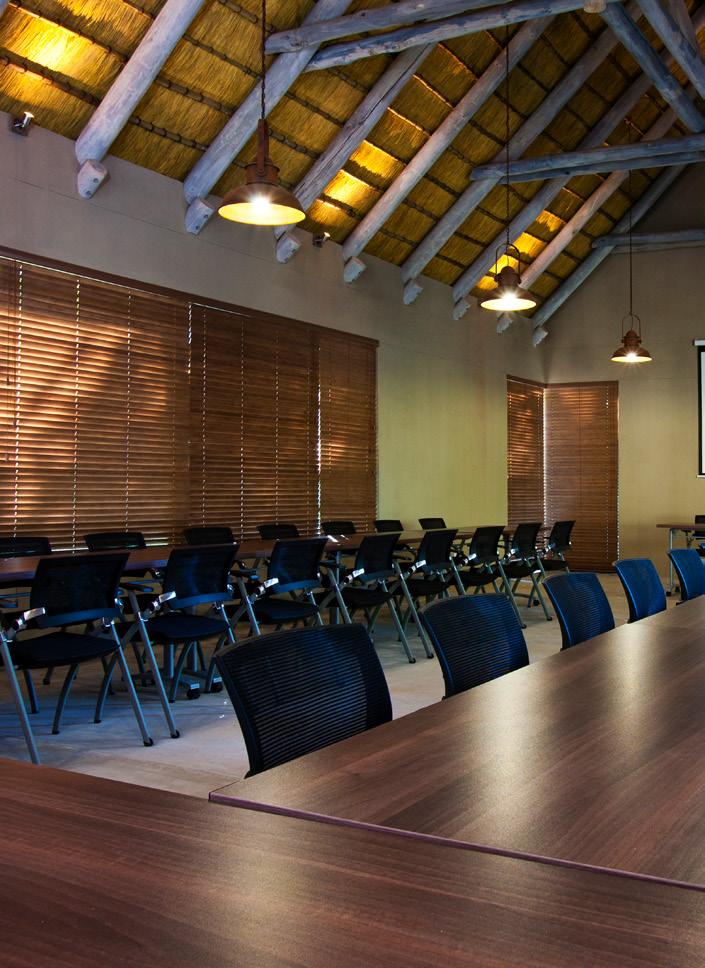
+264 61 285 7108 MICE@nwr.com.na www.nwr.com.na


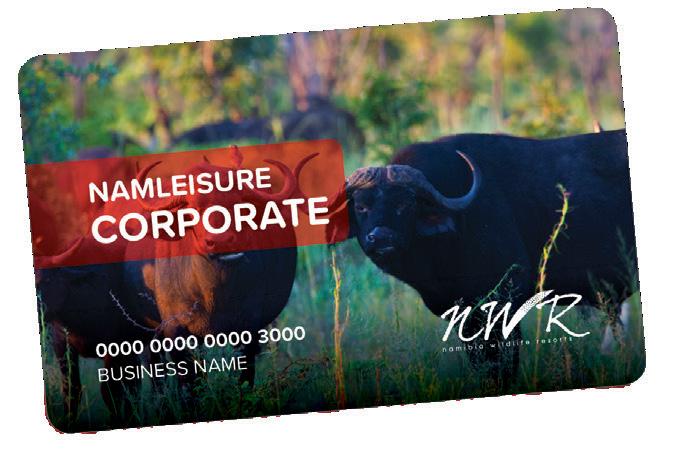

Etosha
National Park


Etosha owes its unique landscape to the Etosha Pan, a vast, shallow chalky white depression of approximately 5 000 km² that forms the heart of the park. Once a large inland lake fed by the early Kunene River and other rivers from the north, it began drying up about three million years ago when the Kunene was diverted to the Atlantic Ocean. A series of waterholes along the southern edge of the pan guarantee rewarding and often spectacular game viewing. In good rain years the pan fills with water draining southwards from Angola via a delta-like system of shallow rivers and oshanas, drying out in the winter to become an austere expanse of white cracked mud, shimmering with mirages and upward spiralling dust devils. What we call Etosha today was proclaimed as Game Reserve No 2 in 1907 by the German Governor Friedrich von Lindequist. With subsequent additions it became the largest game reserve in the world, covering a vast area of ±80 000 km². For political considerations its size was progressively diminished, until by 1975 it had been reduced by 77 per cent to its present surface area of 22 912 km². Nevertheless, it is still one of the largest game reserves in Africa.
Of the 114 mammal species found in the park, several are rare and endangered, such as black rhino and cheetah, and the lesserknown black-faced impala, which is endemic to northwestern Namibia and southwestern Angola. Etosha’s current population of black rhino represents one of the largest populations of black rhino in the world.
Other large mammals in the park include elephant, giraffe, blue wildebeest, mountain and plains zebra, hyaena and lion. Cheetah and leopard complete the trio of ‘big cats’. Antelope species range from kudu, gemsbok and the large and stately
BIRDING IN ETOSHA


eland to the diminutive Damara dik-dik. Smaller mammals include jackal, bat-eared fox, honey badger, warthog and the ubiquitous ground squirrel. For the greater part of the year (the dry season) Etosha’s animals and birds are dependent on about 30 springs and man-made waterholes. These provide excellent game viewing and photographic opportunities. A good policy before setting out is to enquire from camp officials what the current game movements are. During the rainy season, the birdlife at the main pan and Fischer’s Pan is well worth viewing. Etosha’s vegetation varies from dwarf shrub savannah and grasslands, which occur around the pan, to thornbush and woodland savannah throughout the park. Eighty per cent of all of Etosha’s trees are mopane. West of Okaukuejo is the wellknown Sprokieswoud – Fairy, Phantom or Haunted Forest – the only place where the African moringa tree, Moringa ovalifolia, grows in such a large concentration on a flat area. Etosha is open throughout the year and accessible by tarred roads via the Andersson Gate on the C38 from Outjo, the Von Lindequist Gate in the east from Tsumeb on the B1, the Galton Gate in the west from Kowares on the C35 and the King Nehale Gate located on the Andoni plains just north of the Andoni waterhole, which provides access from the north-central Owambo regions on the B1 from Omuthiya.
Find more Namibian travel inspiration at www.thisisnamibia.com
Follow @thisis_namibia on Facebook and Instagram for extraordinary Namibia travel stories.

FlyNamibia Safari between Hosea Kutako International Airport and Sossusvlei, Swakopmund, Twyfelfontein, Etosha - Ongava and Etosha - Mokuti.
Some 340 bird species occur in Etosha, about one third being migratory, including the European Bee-eater and several species of wader. Larger birds include Ostrich, Kori Bustard and Greater and Lesser Flamingo, of which tens of thousands congregate on the pan to breed during a good rainy season. Ten of Etosha’s 35 raptor species are migratory. Those most commonly seen are Lappet-faced, White-backed and Hooded Vultures, while sightings of the Cape, Egyptian and Palm-nut Vultures have been recorded. There are eight species of owl, including the Pearl-spotted Owlet and Southern White-faced Scops-Owl, and four species of nightjar.

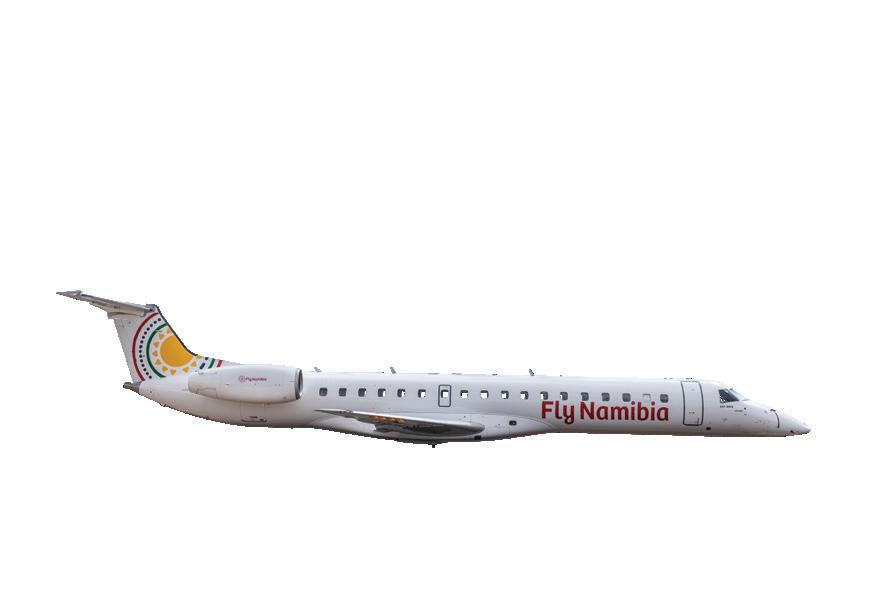




Imagine learning to ride a bike or swim without ever getting on the saddle or into the water. From their first few years of life, children need tactile experiences to grasp concepts effectively. Interactive learning activities and materials are therefore critical for kindergartens (known as early childhood development centres) around the world. However, children in the poorest urban areas in Namibia often have little or no access to such materials. At Development Workshop Namibia (DWN), they are working with educators to change this situation, providing training and resources to ensure every child has the opportunity to learn through experience.
Whether it is learning a new language or playing an instrument, active involvement leads to better understanding and skill development. Interactive learning is particularly vital during the first five years of life when 90% of brain development occurs. Scientific research shows that children absorb up to 80% of what they see and do, compared to minimal retention from passive methods like listening or reading. This underscores the importance of engaging multiple senses, especially during the formative years.
Susan Mathews is a teacher at Suzy’s Kindergarten & Daycare, located in Hakahana, an informal settlement in Windhoek. Informal settlements are usually areas where housing is makeshift or substandard, lacking basic services like clean water, sanitation and electricity. These settlements are often overcrowded, with houses built very close together, leading to high population density. Residents usually do not have legal rights to their homes, making them vulnerable to eviction. Infrastructure such as roads and drainage systems is often poorly maintained or non-existent, and these areas are frequently located in regions prone to environmental hazards like floods and landslides.
Early childhood development centres in poor areas like this face many challenges, including a lack of interactive learning materials and limited training for teachers on suitable learning activities. Recognising these needs, DWN, with the support of various partners like MTC, Capricorn Foundation, Twin Hills Trust and Interteam Swiss, initiated a transformative training programme focused on tactile learning experiences. Susan seized the opportunity to participate wholeheartedly. The training programme emphasises active, child-centred learning methods that use play to instil foundational skills. “Children learn about the world by using their senses – feeling, touching, smelling,
seeing and tasting,” Susan explains passionately. “Not having these materials really delays their development.”
The training sessions are packed with practical, fun-filled activities where educators learn by doing. From hopping to the rhythm of “The Wheels on the Bus” to playing interactive games like “I Spy with My Little Eye” and scavenger hunts, these activities ensure an engaging and hands-on learning experience for the children. Educators like Susan also learn how to use recycled materials and household items to create their own learning tools. “These materials are not only costeffective but sustainable. They allow us to make our own materials as needed.”
Excited to show what she has learned, Susan invited me to visit her kindergarten. When I arrived, I found children fully immersed in play with these homemade resources. “They have been enjoying the materials I made,” Susan shares with a smile. Beyond cognitive development, these activities promote crucial social and emotional skills like sharing and emotional management – a vital foundation for future success.
By investing in educators through this training, DWN enriches teaching practices and enhances learning outcomes for children. Every child, irrespective of background, deserves access to quality learning materials and skilled educators who nurture their potential. By addressing educational inequalities head-on, educators like Susan are empowered to ensure that children receive the essential foundation needed to thrive academically and socially.
Early childhood development is not just about education; it is about building resilient communities. Creative initiatives like these, supported by partners and driven by dedicated educators, demonstrate how targeted efforts can catalyze enduring change. These efforts will improve the learning abilities of children in the community for many years to come. Witnessing Susan’s dedication and the joy on her learners’ faces further reinforces the belief in the transformative power of education in overcoming adversity and fostering a brighter tomorrow.
Frieda Kakolo

For more information into the work carried out by Development Workshop Namibia, explore our website at dw-namibia.org or simply scan the QR code provided.
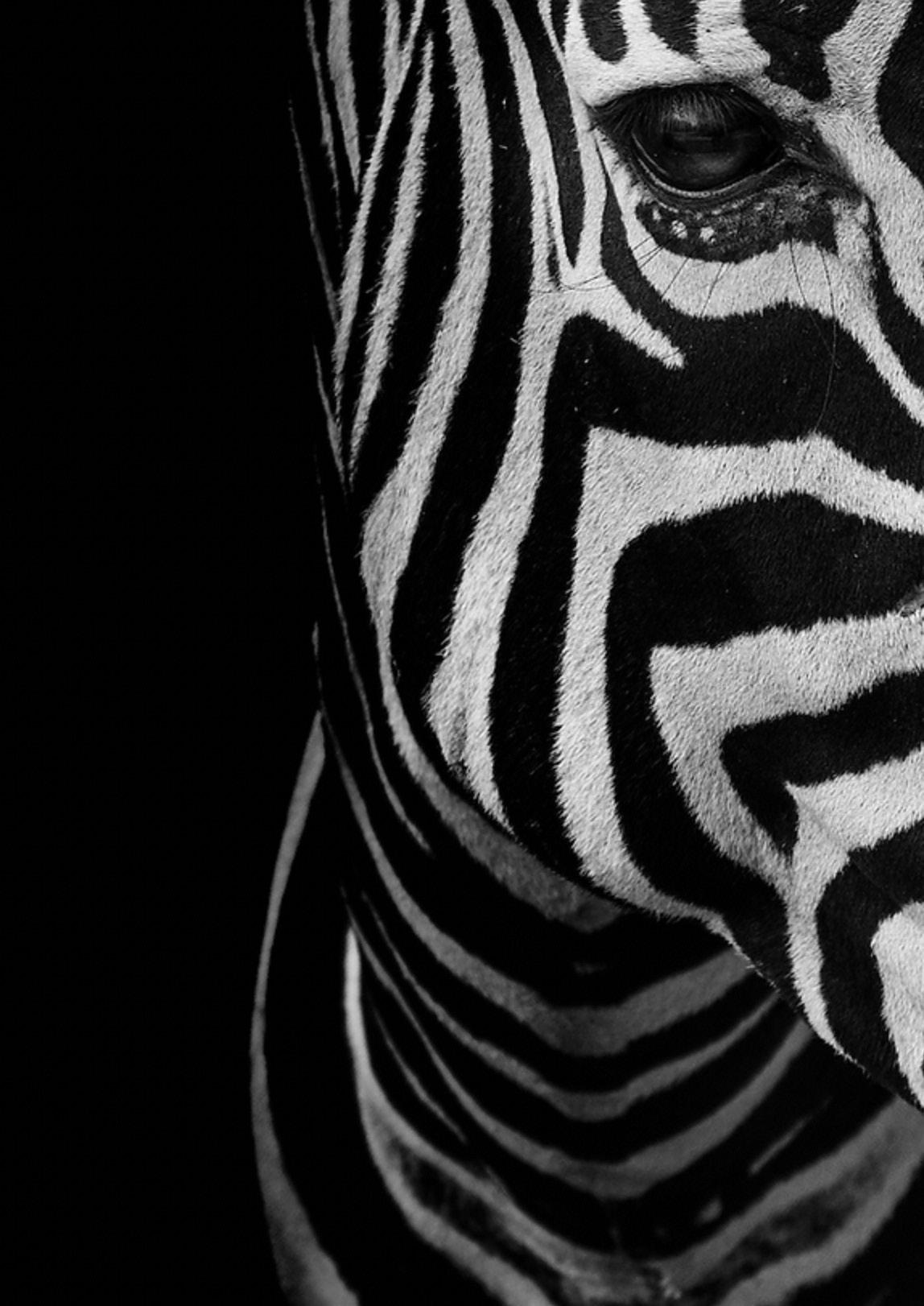

Cape Town, South Africa, proudly hosted the International Astronomical Union (IAU) General Assembly for the first time, which marked a historic occasion for the African astronomical community. The assembly, which took place from 6 to 15 August 2024, was a watershed moment for South Africa and the continent of Africa as a whole. The General Assembly, held at the Cape Town International Conference Centre (CTICC), brought together eminent astronomers, academics and enthusiasts from all over the world, providing a one-of-a-kind forum for international collaboration and knowledge exchange.
The IAU is part of the International Council for Science, an organisation founded in 1919, and seeks to advance and protect the scientific field of astronomy in all its facets. The IAU comprises a global network of over 12,000 individual members from 90 nations who are all dedicated to furthering astronomy education and research. Through international collaborations and scientific exchanges, the IAU is crucial in determining the direction of astronomy and guaranteeing its global advancement.
The assembly featured over 200 scientific sessions, which ensured a busy and engaging programme. Attendees enjoyed talks from notable speakers such as Dr Bernie Fanaroff, Prof. Natalie Batalha and Prof. Joop Schaye, alongside several Kavli, Shaw, Gruber and Nobel Prize winners, providing a diverse array of insights and discussions. A groundbreaking feature of the IAU General Assembly 2024 was its open access model. For the first time, oral talks and poster displays from every scientific session were freely accessible online, making the proceedings accessible to anybody in the world, including video Q&A sessions, mobile Zoom rooms and remote presentations. The assembly’s poster sessions were particularly unique. Every poster was screened so that writers could interact with attendees face-to-face and virtually via Zoom rooms that had cameras and microphones.
There were several public engagement initiatives during the assembly. On 7 August, a captivating public speech was given by Dr Sian Proctor, a geoscience professor and astronaut from SpaceX’s Inspiration4 mission. All conference attendees were also able to communicate over ham radio with astronauts via a live link to the International Space Station. In addition to the main programme, the assembly featured a range of side events, including scientific meetings, workshops, and hackathons. These provided further opportunities for collaboration and learning. There were also unconference sessions where attendees could suggest and cast votes on subjects for spontaneous talks and presentations, encouraging a lively interchange of ideas.
More than 600 representatives volunteered to engage with the public and schools in Cape Town, contributing to a robust outreach programme. Highlights from the conference were broadcast on a pop-up radio station in collaboration with a well-known radio host. This station provided a platform for
conference participants to share their research and discoveries with the broader public. The broadcast content was streamed online and shared with community radio stations around the world, particularly benefiting regions where community radio has a significant reach, including many parts of Africa. This initiative aimed to broaden the impact of the conference and engage a global audience in the discussions taking place.
A lively pop-up market showcasing regional vendors, artists and craftspeople was also part of the assembly. This market provided a venue for exhibiting and offering creative local items and handcrafted goods to a worldwide customer base. It supported regional business owners and aimed to improve Cape Town’s socioeconomic environment while offering conference attendees a distinctive shopping experience. The market established a significant relationship between the conference and the neighbourhood by showcasing South Africa’s rich cultural legacy and artisanal ability.
Participants had the opportunity to visit South Africa’s numerous astronomy facilities through organised technical tours. These tours were available before, during and after the conference, allowing attendees to explore the country’s significant contributions to the field of astronomy. Detailed information and booking options for these tours were provided through the conference’s technical tours portal. The conference’s social events were designed to offer a deep dive into African culture and provide opportunities for relaxation and enjoyment. In addition to the usual receptions, participants enjoyed a cultural evening featuring song and storytelling, as well as a talent night titled “Astronomer’s Got Other Talents”, which showcased the attendees’ diverse skills and talents outside of astronomy.
Another highlight of the conference was the art exhibition Shared Sky, organised by the Square Kilometre Array Organisation (SKAO). This international exhibition, which ran the entire conference, offered a profound reflection on the intersection of art and science under one sky and brought together Aboriginal Australian and South African artists to celebrate humanity’s ancient cultural wisdom through a collaborative display of indigenous art and astronomy.
In conclusion, Cape Town’s hosting of the IAU General Assembly in 2024 is evidence of the continent’s rising stature in the world of science. The occasion showed off South Africa’s capacity to organise an international scientific conference of this size as well as the country’s dedication to increasing the influence and scope of astronomy research. A collaborative and innovative attitude was fostered by the seamless fusion of cutting-edge technology formats with vibrant cultural and community interaction, resulting in a singularly gratifying experience. Future astronomical advances and international collaboration will surely be motivated by the assembly’s legacy, especially as Cape Town’s stature on the world scientific stage continues to grow.
Victoria Ndayambekwa Nakafingo




Connecting dreams to a decade of knowledge and experience
The leading aviation training organisation in Africa.




Another fascinating instalment of the Namibia Trade Network's Business Breakfast Club (BBC) took place in the capital, under the theme Innovation, Technology and Communication. The event was packed with business professionals eager to hear more from the diverse speakers who came to share the latest trends, discuss Namibian innovation, and suggest solutions to challenges in this space.
Speakers for this instalment included Jesaya Hano-Oshike, the co-founder & Director of the Basecamp Business Incubator, Naude Muller, with a wealth of experience building tech startups in Namibia, including co-founding PayToday and IDToday, Linda McLeod, the Acting Manager in Startup & Scale Unit at the Namibia Investment Promotion and Development Board as well as Yarukeekuro Ndorokaze, the Chief Strategic Communications and Support Engagements at the Namibia Revenue Agency (NamRa).
McLeod shared that “Namibia is the perfect launch pad for emerging technologies and industries.” She posed the question, “How do we prepare ourselves?” She excitedly shared why Namibia is on the verge of amazing things and important legislation to support this. McLeod went on to share that “we already have well-established industries like the financial industry. How can we be a sandbox for other countries?”
When talking about technology, McLeod spoke about how it’s hard to compare ourselves with international standards when it comes to technological uptake because while this might be true in Windhoek, it’s not the same case in rural areas. As she explained, “I think it's a digital divide but we are moving forward.”
Ndorokaze shared that at NamRa, although a relatively young organisation, they are constantly striving towards innovation as one of its strategic objectives. However, he shared that while they are focusing on creating a reliable way to submit tax returns digitally, many Namibians still prefer to work with printed documents, demonstrating the digital appetite in the country.
Hano-Oshike raised the question about what can be done to ensure that we focus on the promotion of the benefits of “using technology so that people would see the benefit.” He added that a lot is happening in the country in terms of innovation and technology.
Muller echoed sentiments about the exciting innovation happening here and shared thought-provoking stories from his experience as an engineer and business founder. An interesting takeaway for the audience came when he shared what he is currently working on, which leverages WhatsApp. He told the audience this is an underused tool that he recommends all businesses look into. As he explained, “The functionality and the flow functionality that WhatsApp is bringing out is going to be a major game changer. It's a way to reach your clients and you can run complicated processes in the background.”
Hosted at the exclusive Stellenbosch Wine Bar, the Business Breakfast Club Namibia is an exclusive membershipbased event series designed for professionals and business leaders who are looking to expand their networks and gain valuable insights into various Namibian industries, with a focus on fostering meaningful connections and promoting knowledge sharing. Each event features industry talks from experts and thought leaders, providing members with unique opportunities to learn from some of the most successful and innovative minds in business. Whether you are an entrepreneur, executive, or simply looking to connect with other professionals, the Business Breakfast Club Namibia offers an unparalleled opportunity to expand your network and deepen your knowledge of trade and industry. Learn more at www.bbcnam.com
The Namibia Trade Network and the Namibia Trade Network's Business Breakfast Club are key initiatives of Venture Media, a wholly Namibian-owned publishing and media company renowned for its expertise in content creation, storytelling, and media production. With a focus on tourism, conservation, and industry promotion, Venture Media leverages its three decades of experience to lead the industry in delivering accurate, credible, and up-to-date information across print, video, and digital platforms.
Kirsty Watermeyer
Would you like to be a part of the next Business Breakfast Club scheduled to take place on the 11th of September? We will be discussing healthcare & employee wellness. Register by sending an email to daleen@venture.com.na

A testament to the power and opportunity in sport
Growing up on dusty streets, Jojo Hamunyela’s love for bicycles started very young. “When I was five, my mom bought me a bike with two wheels at the back. I cherished it, but the bigger kids would often take it or ride it without my permission. I fought hard to keep it.” Jojo is an elite men’s cyclist who has represented Namibia all over the world, but his story is one of humble beginnings and how sport can help impoverished youth to sidestep the temptations of the streets.

Jojo grew up with his grandmother in a village in the Ohangwena Region, deep in rural Namibia. When he moved to Windhoek to start Grade 2, he had to leave his beloved bike behind in the north. By seventh grade, Jojo managed to build a bike from collected parts, crafting a little BMX-style bike. “I just wanted to ride,” he recalls. Living in a dangerous part of Windhoek meant it was not long before this bike was stolen. Later he moved with his mom to Donkerhoek, where he attended Immanuel Shifidi High School. It was here that he participated in a GIZ-sponsored programme that rewarded top learners with bikes, a coveted prize for the many benefits that a bike could give a child living in these parts of Windhoek.
Jojo explains: “I lived a long distance away from school and would walk to school. My childhood was a struggle, I didn’t


have transport or shoes that didn’t have holes in them. Winning that bike was, in a way, supporting my studies. It helped me to get to school.” Sadly, it wasn’t long before this bike was stolen too. It was then that he started attending the Physically Active Youth (PAY) after-school programme for children from disadvantaged communities. One of the pillars of the PAY programme is physical activity by offering children a chance to learn various sports. This meant that Jojo once again had access to a bike.
“We would use the bikes at PAY, do our training, and then bring them back to the centre. They wouldn’t be kept at our houses, so they couldn’t get stolen. We were so excited to finish school each day and complete our homework, because that meant we could spend time on the bikes,” says Jojo, recalling how this became the foundation for his professional cycling career. “We used to challenge each other to see who was the



fastest on the bike, and those guys would later become my professional teammates. I remember one day we had a coach from the UCI (Union Cycliste Internationale) in Switzerland to come talk to us at PAY. That was the day that I thought to myself, ‘I want to be a professional cyclist.’”
Marie-Jeanne Ndimbira-Rosner, co-founder of PAY, played a significant role in Jojo’s life. “She was like a second mother to me. I’m deeply grateful for everything she did for me,” says Jojo, who goes on to explain that she saw talent in him before anyone else did, and worked towards raising funds to see him enter professional races. When he first began competing against the top Namibian cyclists, he did so without professional gear and in nothing more than shorts, a T-shirt and rudimentary sneakers. Jojo explains that in those days it came as such a surprise that he could make money by winning races. “I came from a place where if you had one hundred Namibian dollars you were a rich man, and now I was winning prize money. It motivated me to win.” In case you were wondering what he did with these winnings, Jojo gave it to his mother.
Jojo’s success in cycling inspired others and made him a local celebrity in his community, which, he adds, saved his life. “Many of my old schoolmates faced tough lives, sometimes involving crime or substance abuse. In the streets, you are confronted by a lot of crime. Cycling gave me a path away from that.”
Jojo talks about how he almost lost his footing at one point, falling in with the wrong crowd, but again his second mother came to find him. “I was getting tempted as a young man. MarieJeanne came personally looking for me at my house, wanting to speak to me and my mom. She spent the whole day with us. She got us a sponsorship in cycling from Nedbank. We were the first guys to get sponsored in cycling. She connected us with Mr Steve Galloway, who is a good man. He helped us to do training camps and this also helped us to refocus.”

Many of my old schoolmates faced tough lives, sometimes involving crime or substance abuse. In the streets, you are confronted by a lot of crime. Cycling gave me a path away from that.
and Jojo hopes to secure bikes and a container to store them safely to prevent them from being stolen.
Jojo talks fondly of the many memories he has of competing on a bicycle, from chasing down teammates on the Daan Viljoen Road to being invited to represent Namibia in Japan. “For that race, the organisers invited me to compete and paid for everything, from flights to accommodation.”
Now, Jojo is moving into a new chapter of his career as a cycling coach. He is currently a Level 2-certified coach and aims to become a Level 3 coach – the highest certification – with the necessary training in Switzerland. Meanwhile, he has established the Jojo Cycling Academy to help the underprivileged youth. The academy is in its early stages,
In a testament to the aspirational power of sport and the promise of a life out of the ghettos and off the streets, Jojo explains that when he sets off in the morning to train on his bike, he would see many children from his community line the street to wave him off, and when he returns in the twilight hours, they would still be there to wave him home. Perhaps their mere proximity to him might mean that they, too, will get the chance to ride a bike one day, or see their names in the newspaper, or even see the world. “They ask me when I’m going to help them get bikes. They say they want to ride like me. They see what cycling has done for my life. I want to help those kids.”
Kirsty Watermeyer
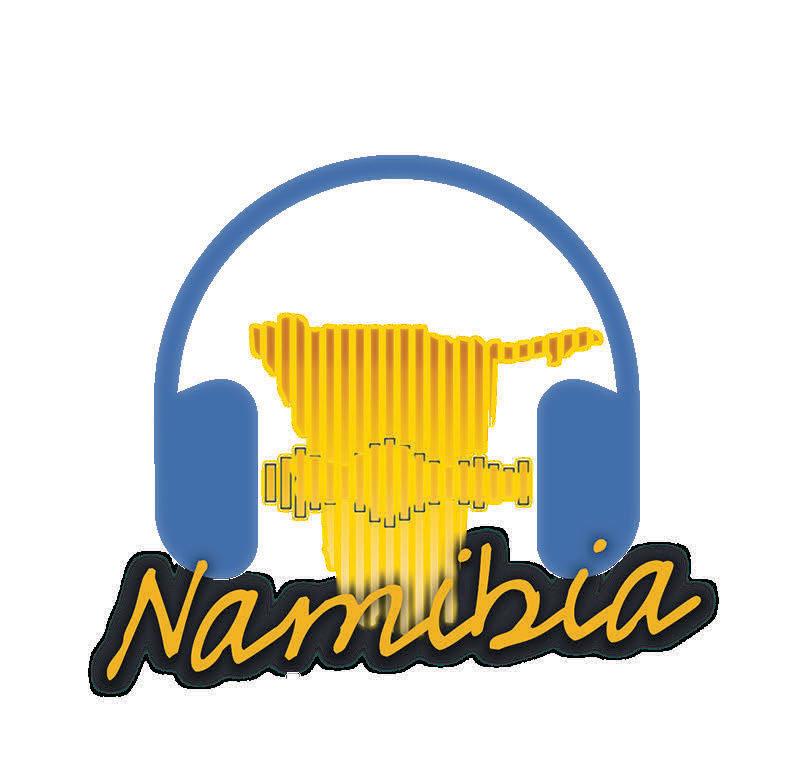



Imagine a flat tire in the middle of the Namibian bush, while a young elephant bull is approaching…and that was only the beginning of three exciting days at Etosha Heights, a private game reserve, bordering the famous Etosha National Park.
Imagine a flat tire in the middle of the Namibian bush, while a young elephant bull is approaching…and that was only the beginning of three exciting days at Etosha Heights, a private game reserve, bordering the famous Etosha National Park.
Imagine a flat tire in the middle of the Namibian bush, while a young elephant bull is approaching…and that was only the beginning of three exciting days at Etosha Heights, a private game reserve, bordering the famous Etosha National Park.
We joined students and researchers from the Namibian University of Science and Technology in releasing two cheetahs into the wild, searching for GPS-collared elephants and witnessed the passion of our Namibian youth for conservation. And we kept the microphones rolling throughout to bring you another story about our favorite topic: Namibia!
We joined students and researchers from the Namibian University of Science and Technology in releasing two cheetahs into the wild, searching for GPS-collared elephants and witnessed the passion of our Namibian youth for conservation. And we kept the microphones rolling throughout to bring you another story about our favorite topic: Namibia!
We joined students and researchers from the Namibian University of Science and Technology in releasing two cheetahs into the wild, searching for GPS-collared elephants and witnessed the passion of our Namibian youth for conservation. And we kept the microphones rolling throughout to bring you another story about our favorite topic: Namibia!
The land of vast spaces, of contrasting landscapes, of desertadapted elephants, Omajova mushrooms and glorious sunsets. The land of stories galore.
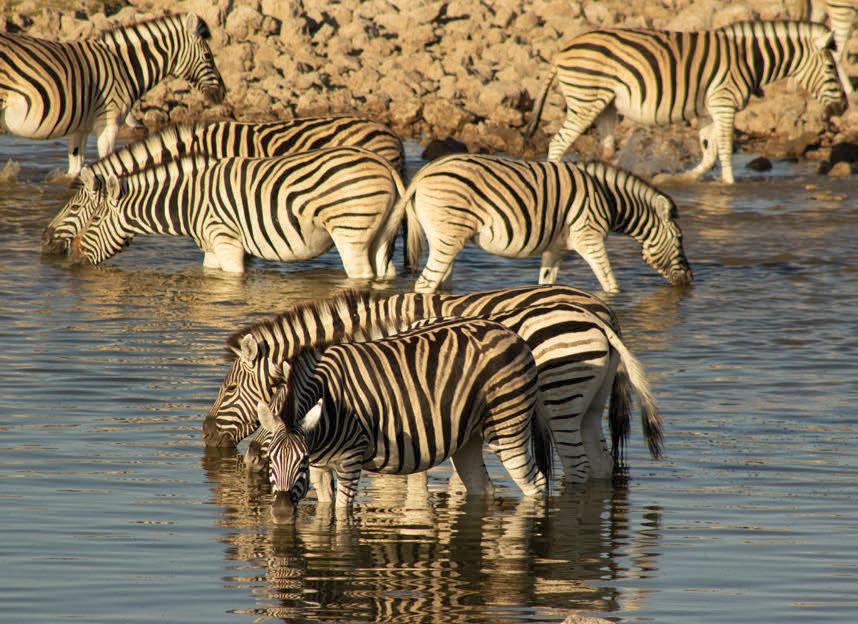
of the most exciting places. And we meet people who care deeply about this country. Discover Namibia with us and share our love for this beautiful land.
of the most exciting places. And we meet people who care deeply about this country. Discover Namibia with us and share our love for this beautiful land.
of the most exciting places. And we meet people who care deeply about this country. Discover Namibia with us and share our love for this beautiful land.
We showcase our unique natural environment and tell you about Namibia’s conservation. We find out how charcoal or beer made in Namibia finds its way to foreign markets. Or what makes Kapana or Zambezi bream so special? And what role sports, music and politics play here. In short, we take you on a journey through Namibia.
We showcase our unique natural environment and tell you about Namibia’s conservation. We find out how charcoal or beer made in Namibia finds its way to foreign markets. Or what makes Kapana or Zambezi bream so special? And what role sports, music and politics play here. In short, we take you on a journey through Namibia.
The land of vast spaces, of contrasting landscapes, of desertadapted elephants, Omajova mushrooms and glorious sunsets. The land of stories galore.
We showcase our unique natural environment and tell you about Namibia’s conservation. We find out how charcoal or beer made in Namibia finds its way to foreign markets. Or what makes Kapana or Zambezi bream so special? And what role sports, music and politics play here. In short, we take you on a journey through Namibia.
Want to join the world of Namibian wonders and beauties? Simply tune in to Hitradio Namibia’s podcast ‘Namibia hören’.
Want to join the world of Namibian wonders and beauties? Simply tune in to Hitradio Namibia’s podcast ‘Namibia hören’.
In our podcast ‘Namibia hören’ we take a look behind the scenes
In our podcast ‘Namibia hören’ we take a look behind the scenes
The land of vast spaces, of contrasting landscapes, of desertadapted elephants, Omajova mushrooms and glorious sunsets. The land of stories galore.





In our podcast ‘Namibia hören’ we take a look behind the scenes


No need to worry about missing out because of language restraints – the podcast is a mix of German and English.
No need to worry about missing out because of language restraints – the podcast is a mix of German and English.
Want to join the world of Namibian wonders and beauties? Simply tune in to Hitradio Namibia’s podcast ‘Namibia hören’. No need to worry about missing out because of language restraints – the podcast is a mix of German and English.




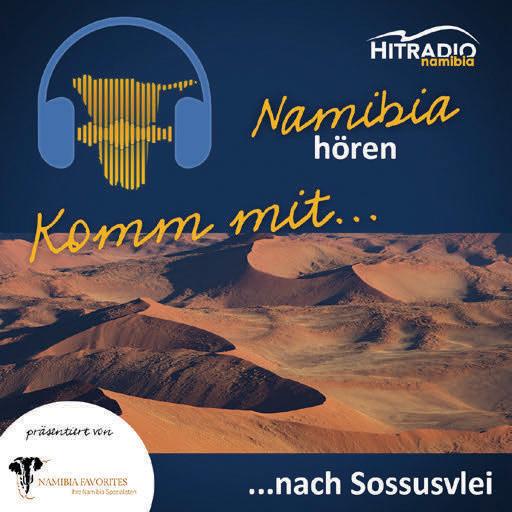




In the vibrant town of Rundu, nestled within the beautiful Kavango East Region of Namibia, a new initiative was recently unveiled, to assist the town's waste management efforts. This project, spearheaded by FlyNamibia in collaboration with the Rundu Municipality, aims to tackle the pervasive issue of littering in Rundu and promote a culture of cleanliness and sustainability.
The journey began with a comprehensive assessment of the town's waste disposal needs. FlyNamibia's team identified high-traffic areas where the absence of proper waste management facilities was most noticeable. Parks, markets, recreational areas, and public transportation hubs were among the priority locations for this initiative.
FlyNamibia supplied bright blue waste bins to be installed across the town. The bins' strategic placement encourages residents and visitors to dispose of waste responsibly, reducing littering and enhancing the town's aesthetic appeal.
Keeping Rundu clean is essential not only for its residents but also for the health of the Kavango River, a lifeline for many communities in the region and beyond. This river provides life-giving water to countless people, and maintaining a clean environment ensures that its waters remain unspoiled and healthy for future generations.
Community engagement played a vital role in the project's success. Awareness campaigns and discussions were held to educate the public on the importance of proper waste disposal. Local businesses were encouraged to participate, and residents were invited to share their feedback on the initiative's effectiveness.
FlyNamibia hopes that not only will the bins assist the town and its people in keeping their public spaces clean, but also inspire individuals and other businesses to take up the mantle of community support for these kinds of initiatives. We hope Rundu's public spaces will see a noticeable reduction in litter, and that the community will embraced a cleaner, greener way of life. The waste bins, which will be regularly maintained by the municipality, stand as symbols of the town's commitment to environmental stewardship.
This project is a testament to the power of collaboration and community spirit. By working together, FlyNamibia and the people of Rundu have created a sustainable solution that benefits both residents and visitors alike. It's a shining example of how FlyNamibia lives by its motto, "We rise by lifting others," ensuring that our contributions uplift the community and the environment.
Elzanne McCulloch

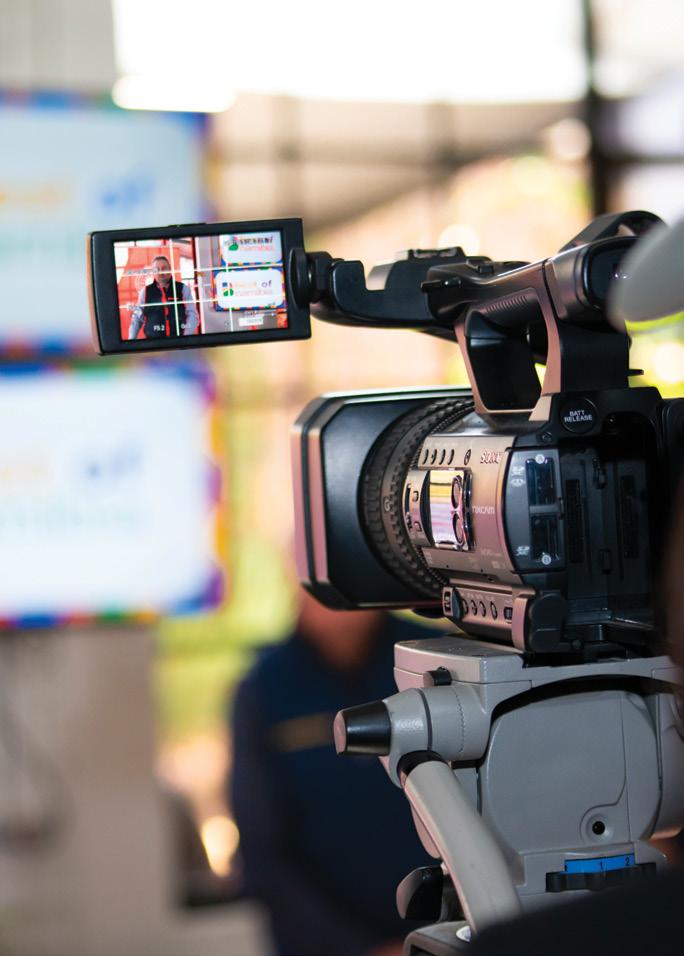



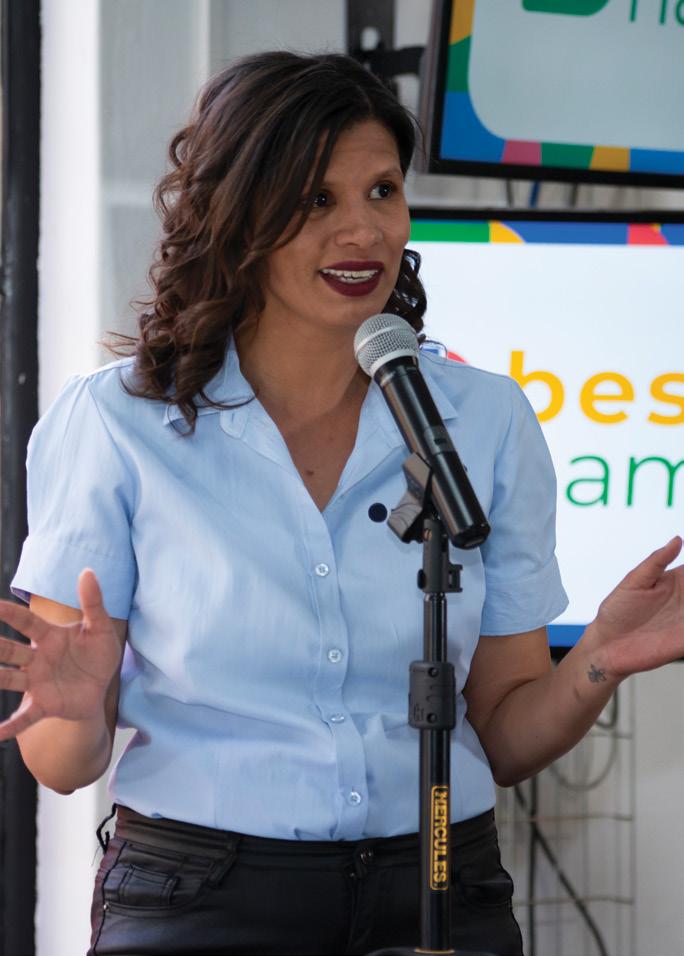
The Best of Namibia campaign, created by Venture Media and Future Media and proudly sponsored by FlyNamibia, celebrated its first edition’s award ceremony at the end of July. This new public choice awards campaign sought to find the nation’s favourite businesses across various categories and industries. From a nomination phase where the public could nominate any Namibian businesses in predetermined categories, the Best of Namibia team shortlisted finalists in each category. All categories were then open to public voting. With thousands of votes received from you the public, the Best of Namibia was crowned and given the accompanying bragging rights. We’d like to thank our campaign sponsor, FlyNamibia, our auditors CRVW, as well as our individual category sponsors. The Best of Namibia will be back in 2025!
RETAIL
Best Fashion Retailer Woolworths
Best Namibian-Made Fashion or Lifestyle Goods Retailer Shilongo Leather
Best Supermarket for Your Essentials Spar
Best Local Produce Food Lover’s Market
Best Hardware Store Pupkewitz Megabuild
Best Home Appliance Store Nictus
Best Mall/Shopping Centre The Grove Mall
BEVERAGE HOTSPOTS
Best Cafe/Coffee Shop Slowtown
Best Shebeen/Neighbourhood Pub Nico’s
Best Bottle Store Metro Liquor
WEDDINGS & EVENTS
Best Wedding Venue Droombos
Best Conference Venue Droombos
Best Wedding/Event Caterer Droombos
TRAVEL & ACCOMMODATION
Best Hotel Strand Hotel Swakopmund
Best Lodge/Safari Camp Desert Grace
Best Bed and Breakfast/ Guesthouse Atlantic Villa Boutique Guesthouse
Best Campsite Etosha Safari Camp
Best Weekend Getaway Midgard
Best Glamping Etosha Safari – Camping2Go
Best Travel Agent/Tour Operator Gondwana Collection
VEHICLES & MOBILITY
Best New Car Dealership Indongo Toyota
Best Second-Hand Car Dealership Indongo Toyota Automark
Best Auto Repair Workshop Indongo Toyota Windhoek
Best Panel Beaters Star Body Works
Best Tyre Fitment and Automotive Centre TrenTyre
Best Car Rental Namibia2Go
Top Rideshare/Taxi Service or App Yango
Best Bicycle Shop CYMOT
PERSONALITIES & ICONS
Best Local Sports Hero Christine Mboma
Best Namibian Musician Gazza
Best Local Band One Blood







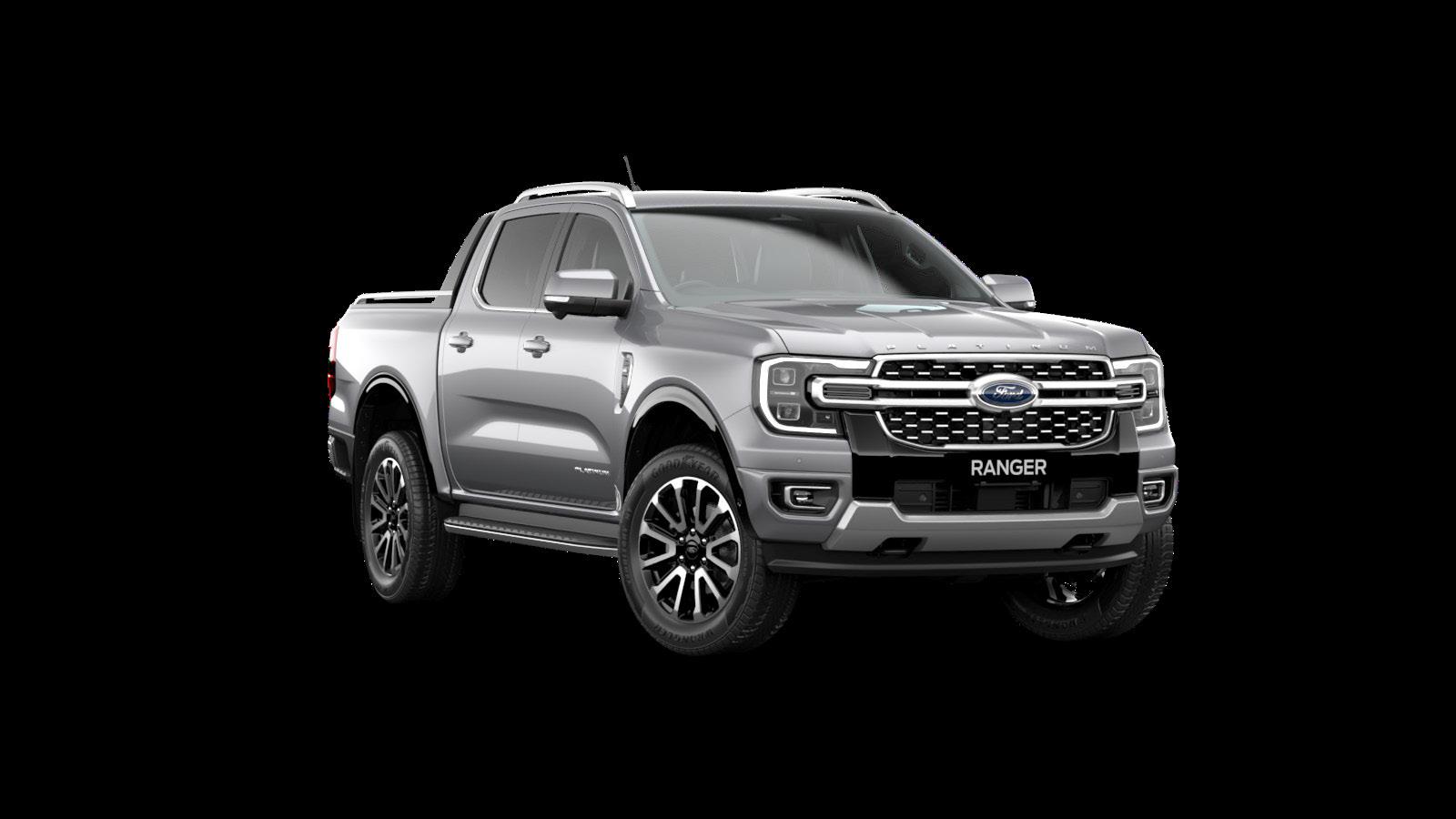


The Namibia Airports Company (NAC) recently commissioned 49 young Namibians with basic fire-fighting skills following a six-month rigorous training at the Hosea Kutako International Airport (HKIA) and Walvis Bay International Airport. NAC Chief Executive Officer Bisey /Uirab : “As our operations revolve heavily around airport rescue and firefighting, it is essential to have teams that are highly trained and skilled at readiness. This program supports our commitment to the highest safety and emergency preparedness levels. It reflects our commitment to investing in people, who are our most valuable Capital”.
After a three-month probationary period, the trainees will become Assistant Rescue and Firefighting Officers, deployed at the eight airports under the management of the NAC. The airports are HKIA and Walvis Bay International Airports, Andimba Toivo Ya Toivo Airport at Ondangwa, Katima Mulilo Airport, Rundu Airport, Lüderitz Airport, Keetmanshoop Airport and Windhoek’s Eros Airport.
Best Sports & Recreation Centre
MTC Dome
Top Neighbourhood Gym
Virgin Active
Best Spa and Wellness Centre Younique Day Spa
Best Nail Tech
Classic nails by Helvi
CHARITIES
Education and Youth Development
Drought Relief Namibia
Health and Wellness
CAN – Cancer Association of Namibia
Environmental Conservation Drought Relief Namibia
Social Services and Community Development
Charity Work Havannah
Advocacy and Awareness
CAN – Cancer Association of Namibia
Animal Welfare
SPCA Windhoek
FOOD & DINING
Best Family Restaurant Spur
Best Asian or Sushi Restaurant Cape Town Fish Market
Best Seafood Restaurant Cape Town Fish Market
Best spot to go for a Pizza Goodfellas
Best Deli Hartlief
Best Kapana Vendor Dolce & Kapana
Best Ribs Spur
Best Steak Restaurant Butcher’s Block
Best Slap Chips OK Baines
Best Burger Rocco Mamas
Best Place to Buy Biltong Wilhelmstal Padstal

SERVICES
Best Bank First National Bank
Best Short Term Insurer Old Mutual
Best Health and Medical Services Lady Pohamba Private Hospital
Best Pharmacy Dischem
Best Network Provider MTC
Best Courier Service Nampost
EDUCATION
Best Pre-Primary/Day Care Centre Pikkie Paradys
Best Primary School Pioneerspark Primary School
Best High School WHS
Best Higher Education Centre NUST







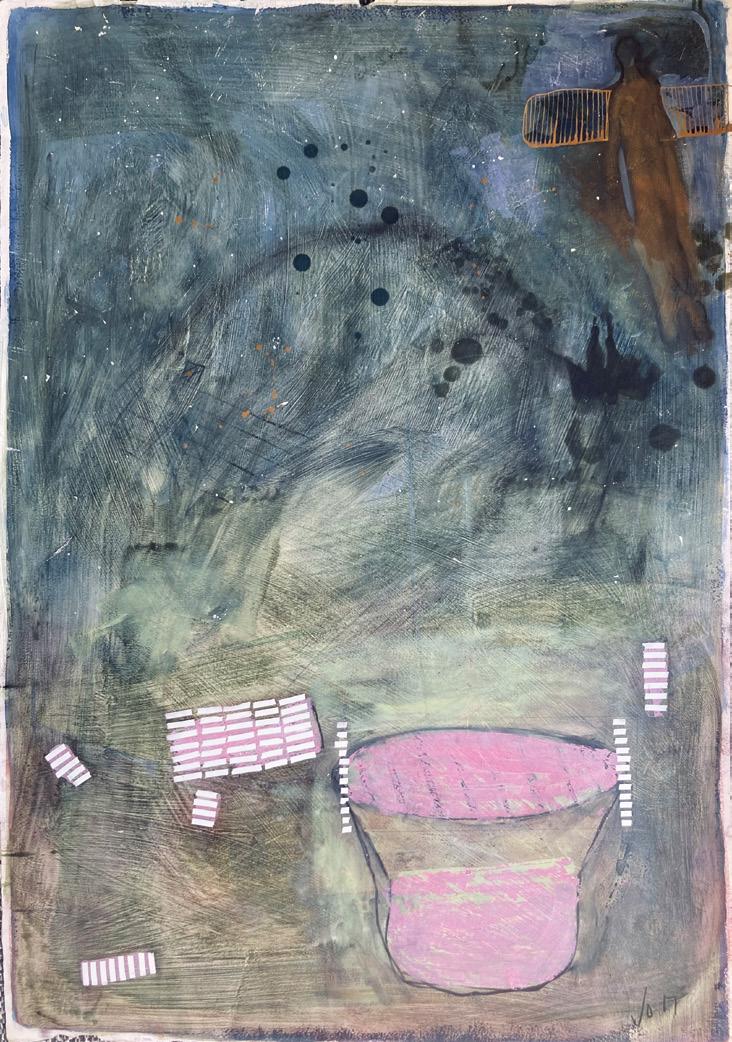
So


In this body of work, artist Jo Rogge returns to Namibia with a solo show built on their role as a witness and social commentator on a myriad of issues unfolding around them. Grappling with concerns ranging from the personal to the societal, the temptation to read the work as a form of activism is irresistible. A radical feminist reading is a prerequisite if we are to make sense of the title, bearing in mind that Lot’s loyal wife resisted a commandment, looking back to witness the destruction of Sodom and Gomorrah, an incident that “liberated” her from enduring the pain of continuing to live with would-be “traitors”, albeit she is said to have been turned into a pillar of salt. To this, the artist has added the rejoinder: “So what?”
The Lady Chatelaine was always going to feature a prince –the artist presents the lifeless body of a black figure lying on a supposed bed of roses, while the red motif resembles the spilling of blood. In this painting, Rogge takes on the matter of hate killings in Namibia, specifically referencing a recent brutal and senseless murder widely covered by local media. The conceptual abstractions Supplication I and Supplication II, although stylistically different, echo this theme – a solemn plea for change in the existing reality. Mythical references also offer clues to the works Andromeda’s Escape and The Three Fates
In the series of text-based salvaged textiles, Jou Ma se Doilie, the artist casts their net beyond queer tropes, capturing memes largely culled from social media, creating a tonguein-cheek narrative of stitched words over exquisitely fine embroidery from the past.
What is desired and what is discarded seems to be a central mantra in both the artist’s life and the process of their practice. What is self-censorship? What leads one to edit,
distort and deface the past? What is there to hide? Could it be shame? Only fragments of the truth, disjointed narratives and a distortion of reality remain. The live art performance in which Rogge erases their written journals and artworks evokes a number of questions for the audience, concerning not only the artists’ personal journey but also the violent past of recorded history.
Discarded materials, past their use, also largely dictate Rogge’s spontaneous sculptural compositions. As is the case with artists in most southern African countries, this form of upcycling emerged as an improvisation mechanism for artists unable to access conventional art materials, either due to their high costs or scarcity. Interestingly, materials of this nature always add layers of meaning to the work as they carry multiple accumulated stories.
A consistent thread underlining this body of work is Rogge’s refusal to be boxed, as Stephen King reminds us in The Shawshank Redemption:
“Some birds are not meant to be caged, that’s all. Their feathers are too bright, their songs too sweet and wild. So, you let them go, or when you open the cage to feed them, they somehow fly out past you.”
Rogge’s solo exhibition, so she was turned to a pillar of salt, will be held at The Project Room in Windhoek from 13 September to 12 October 2024.
Barnabas Ticha Muvhuti

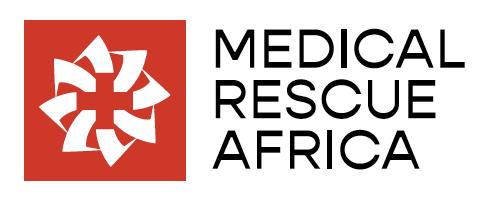

Medical Rescue Africa (MRA) is Namibia’s leading fixed wing Aeromedical Evacuation company specialising in the evacuation of critically ill and injured patients across Africa, 24 hours a day, 7 days a week.
MRA, through Westair Aviation, has a dedicated fleet of Air Ambulance aircraft on standby which have the ability to land on unimproved airstrips as well as to operate at night and in bad weather conditions. Air crews undergo regular refresher training, and all operations comply with the highest safety and quality standards.
MRA has its own 24-hour Call Centre with trained and dedicated operators utilising state of the art equipment and aviation information technology. The Call Centre liaises with local and international Medical Aid, insurance and medical assistance companies to help facilitate and coordinate medical evacuations, and medical repatriation services.
To ensure the best possible pre-hospital treatment to patients, MRA offers a 24-hour Road Ambulance at Eros Airport for transporting patients from the Airport to the treating Hospital. The MRA Ambulance is equipped to an ICU patient care level. MRA has a standard service-level agreement with all accredited ALS Ambulance Services across Namibia for effective Road Ambulance evacuation services should the requirement be to not activate the fixed wing Air Ambulance.
MRA is led by a management team with extensive experience in medical response, evacuation and support operations.
Tel: 912 within Namibia or +264 83 339 0033

Debmarine Namibia’s commitment to environmental stewardship and scientific research is evident in its recent initiative to donate surplus benthic samples to several institutions. By supporting the Ministry of Fisheries and Marine Resources, the Ministry of Education, the Directorate of National Heritage and Culture Programmes, the University of Namibia (UNAM), and the Namibia University of Science and Technology (NUST), the company is enhancing marine research and education.
Reiterating the company’s commitment to environmental stewardship and fostering meaningful partnerships with these institutions, Debmarine Namibia's Chief Executive Officer, Willy Mertens emphasised that the company operates in the offshore realm, with immediate communities acting as guardians of the vast Atlantic Ocean. “One of our core initiatives is the benthic monitoring programme, which assesses the impact of our recovery operations on the benthic communities in the Atlantic 1 Mining Licence Area. This programme also monitors the recovery time after recovery activities. Annually, between October and December, we collect benthic samples from designated control, impact and natural variability sites across the mining licence area. This commitment to comprehensive data collection and analysis demonstrates our dedication to understanding and minimising our environmental impact. These samples have been collected for the past three years, with an investment of over N$20 million.”
Mertens mentioned that the company’s utmost respect for the marine environment includes the recovery process involving the extraction of diamondiferous gravel from the ocean floor at depths reaching 140 metres. Notably, 80 percent of the extracted material is returned to the seabed, showcasing the company’s dedication to sustainable practices. To ensure operations align with the highest environmental standards, Debmarine Namibia has obtained certification to the ISO 14001
international standard. This certification establishes stringent requirements for an environmental management system that supports environmental protection, pollution prevention, and compliance with legal obligations. It also emphasises the importance of socio-economic considerations and close collaboration with key stakeholders.
Debmarine Namibia's Chief Environmental Scientist, Dr. Deon Louw, highlighted the significance of partnerships in achieving the company’s environmental goals. “We work closely with the Benguela Current Commission, a multinational cross-sectoral initiative involving Angola, Namibia, and South Africa. In 2012, the company took a significant step by initiating the establishment of the Marine Scientific Advisory Committee (MSAC). This committee comprises independent scientists from various local and South African universities, as well as experts from the De Beers group. This year, international scientists have been added to MSAC as well. The philosophy that underpins Debmarine Namibia, as reflected in the company’s environmental policy, is a commitment to continual improvement in environmental management practices. By closely monitoring the key characteristics of operations, Debmarine Namibia aims to minimise any potential negative impacts on the environment.
The donation of samples to Professor Lameck Mwapagha of NUST, Dr. Eliakim Hamunyela of UNAM, and Dr. Francois Becker of the National Museum of Namibia demonstrates the value placed on academic and scientific partnerships. These collaborations are expected to significantly contribute to advancing marine research and enhancing knowledge about the Atlantic Ocean’s ecosystems.



Alex Forbes’ Head of Actuarial, Aimee Langford, says an average Namibian contributes only 13% of their income towards retirement savings, falling short of the recommended 23.5% needed to maintain a comfortable lifestyle in retirement. Speaking at Alex Forbes’ Hot Topics 2024, Langford said individuals should aim to replace 75% of their pre-retirement income when investing to maintain their standard of living in retirement. “And so ultimately we saw that members only contributed 13% on average towards their savings. Langford further explained that members contributing less than 8% of their income towards retirement savings could only expect to replace about a quarter of their previous income in retirement. However, the majority of members were still contributing at a level that would only allow them to replace less than half of their previous income in retirement. She also said that only approximately 41% of members could expect a replacement ratio of between 50% and 75%, but only 5% were projected to meet or exceed the 75% target. “The majority of members are contributing at a level that will not allow them to replace more than half of their pre-retirement income, which is concerning. To gain a more comprehensive understanding, we also analysed member projections, considering not only contributions but also accumulated savings and time until retirement,” she said. She further explained that another problem is the low rate of pension preservation. Only 15% of Namibians who change jobs preserve their pension savings, while the remaining 85% opt to cash out. Langford explained that this decision, while tempting in the short term, has devastating long-term consequences, especially for older workers who have less time to recover lost savings. “What we did see though is that more recently there was an uptick and as recently as 2022 that the preservation rate actually increased to just under 15%, so that’s very positive news. However, on the flip side, that does mean that 85% of members who left the fund during that year chose to cash their full benefit,” she said.

The Ministry of Agriculture, Water and Land Reform says it has lifted the ban on importing live poultry and birds from South Africa. Simultaneously, the Ministry has suspended the import and in-transit movement of live poultry from Brazil.The Ministry’s Acting Chief Veterinary Officer, Johannes Shoopala, said importers can now resume bringing in live poultry and birds from South Africa, provided they meet specific conditions. The conditions include that the poultry must originate from compartments approved by the South African Department of Agriculture, Land Reform and Rural Development and registered in terms of VPN 44.201201. “Additionally, the poultry must be from a compartment listed for export to Namibia in the monthly list approved by Namibia’s Director of Animal Health. Be from parent flocks that have not been vaccinated against Highly Pathogenic Avian Influenza,” he said. He also added that the ban on imports from Brazil also includes birds, raw/uncooked poultry products, live ostriches, and raw ostrich products from the State of Rio Grande do Sul, Brazil. This decision follows the outbreak of Newcastle Disease in the region. “The disease was detected on 9th July 2024; therefore, the suspension is effective as of 18 June 2024 based on an incubation period of 21 days as set by the World Organisation for Animal Health,” he said. He further explained that consignments from the State of Rio Grande do Sul containing poultry products packed in their final packaging on or after 18 June 2024, will be rejected and sent back to Brazil or destroyed at the importer’s cost. “Please note that a reefer container will be regarded as a consignment, and will be handled as an entity. We will not allow cartons (e.g., in case of chicken meat) to be sorted according to the date of production. All previously issued import and in transit permits issued to the State of Rio Grande Do Sul are hereby cancelled and recalled with immediate effect,” he said. Cooked poultry meat products for commercial purposes may still be imported into Namibia under a veterinary import permit.

The Perivoli Rangeland Institute says Namibia has immense potential for carbon sequestration projects but lacks a developed carbon credit market. Researcher Daisy Nielsen said the country faces key challenges, including high financial costs, transparency issues, and concerns over greenwashing.Nielsen highlighted the urgent need for effective regulatory frameworks and community involvement to unlock the market’s potential and drive sustainable environmental benefits as Namibia seeks to capitalise on these opportunities. “Namibia has significant potential for carbon credit projects in renewable energy, reforestation, agricultural transitions, and ocean-based solutions like kelp forest restoration. Proper bush management can restore environments, boost biodiversity, and increase soil organic carbon over time,” she said at a recent Biomass Conference. She said biodiversity credits, a new and rapidly developing market, involve payments for the protection, restoration, or management of biodiversity. Nielsen noted that although less formalised than carbon markets, countries like Australia have begun trading these credits, and Namibia has significant potential for projects that combine biodiversity and carbon credits, although combining them remains complex. “Namibia’s Ministry of Environment and Tourism supports carbon and biodiversity projects through policies like the Climate Change Policy and the Environmental Management Act. International standards also provide guidance, but challenges such as transparency, greenwashing, and financial limitations must be addressed,” she added. Nielsen noted these markets can diversify economic activities in agriculture, communal areas, and tourism. “Carbon and biodiversity credits transfer wealth from industrialised countries to developing nations like Namibia, building resilience to climate change and providing scientific solutions to land degradation,” she said. This comes as there is a global need to reduce atmospheric carbon from around 240 ppm to 350 ppm. “Carbon sequestration is central to this mission. Biodiversity has also gained significance, leading to the development of international frameworks guiding carbon and biodiversity markets,” she said. The Perivoli
Rangeland Institute is currently conducting a feasibility study on a high-integrity biochar project while restoring arid land and sequestering carbon dioxide in Sub-Saharan Africa. The institute was established under the UK associate Perivoli Climate Trust, founded in 2020 to fund climate change research, which the Rangeland Institute implements through agri-ecological farming and converting invasive bushes to biochar, enhancing livelihoods and sequestering greenhouse gases. Last year, Presidential Economic Advisor and Hydrogen Commissioner James Mnyupe revealed that Namibia was exploring the possibility of venturing into carbon trading.
Namibia has been ranked second in terms of income inequality, with an inequality index score of 59.1 according to a report by Rand Merchant Bank (RMB). RMB’s “Where to Invest 2024” report highlights a dramatic widening of the gap between the rich and poor in Namibia, placing it second only to South Africa on the income inequality index. “Namibia retains several troubling difficulties also entrenched in its southern neighbour. Both nations are among the world’s most extreme for inequality and unemployment,” the report said. It further reported that the country’s unemployment rate had positioned it in the 27th place with a rate of 20.6% on the RMB Where to Invest in Africa model, surpassing South Africa by four positions. The report also added that both countries were grappling with entrenched inequality. “To the investor, this may represent a low base with much to be gained if change is made,” the report stated. Despite these challenges, Namibia has shown potential in other areas. It ranks as the 18th most attractive investment destination in Africa, according to the RMB, scoring -0.05. While this places Namibia behind countries like Benin, Rwanda and Botswana, the report highlights strong fundamentals such as a sound GDP per capita, robust political stability, and high personal freedom as potential strengths. The report cites the country’s emerging oil and gas industry could also significantly boost its investment attractiveness. The country’s Orange Basin is considered one of the world’s most promising oil and gas regions, with the potential to transform Namibia into a petro-state. “Namibia’s most exciting prospect lies in offshore oil and gas discoveries. In fact, the country’s Orange Basin is emerging as one of the world’s most promising prospective oil and gas regions and, as the Financial Times puts it, “could make it the world’s newest petro-state,” the report reads. The report warns however that the successful commercialisation of these discoveries and the effective management of potential oil wealth through a sovereign wealth fund will be crucial factors in determining the country’s future economic trajectory.





We love seeing your journeys with FlyNamibia on Instagram. Keep Tagging!
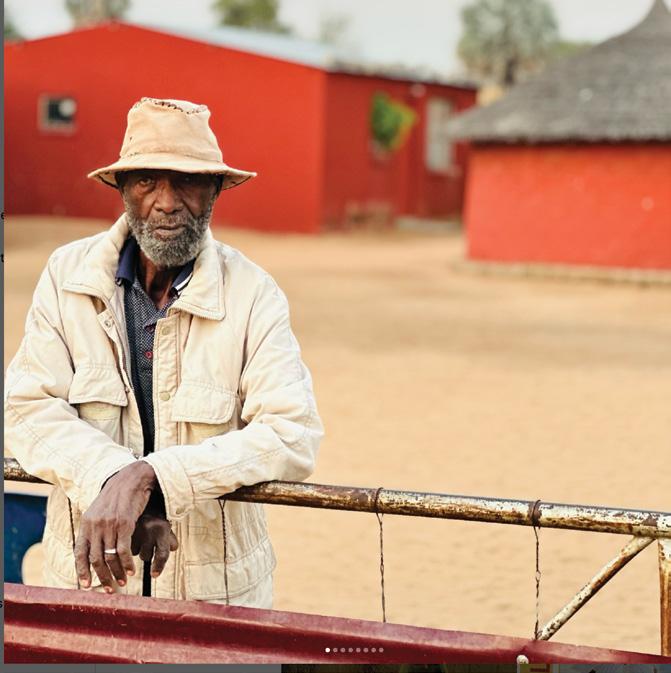
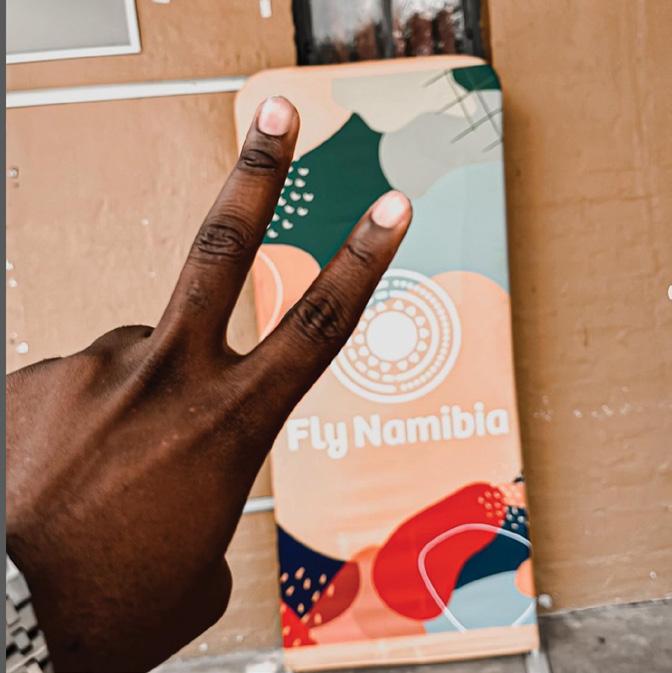
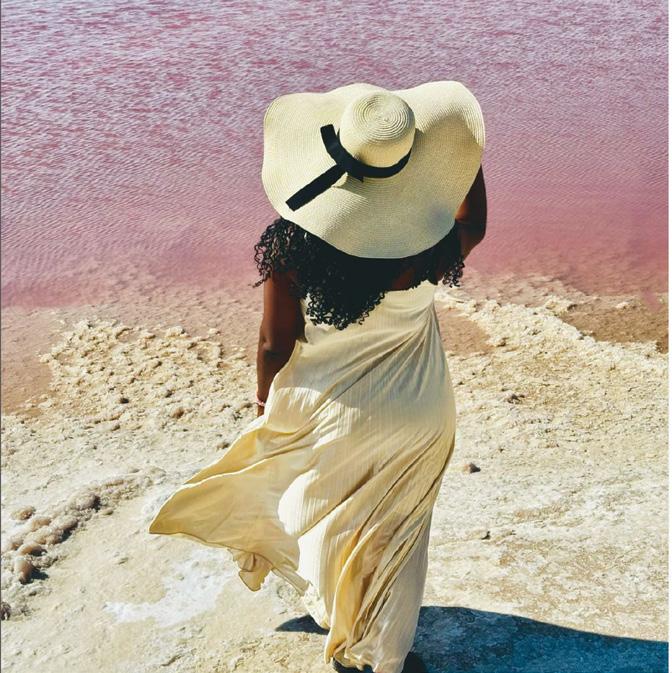

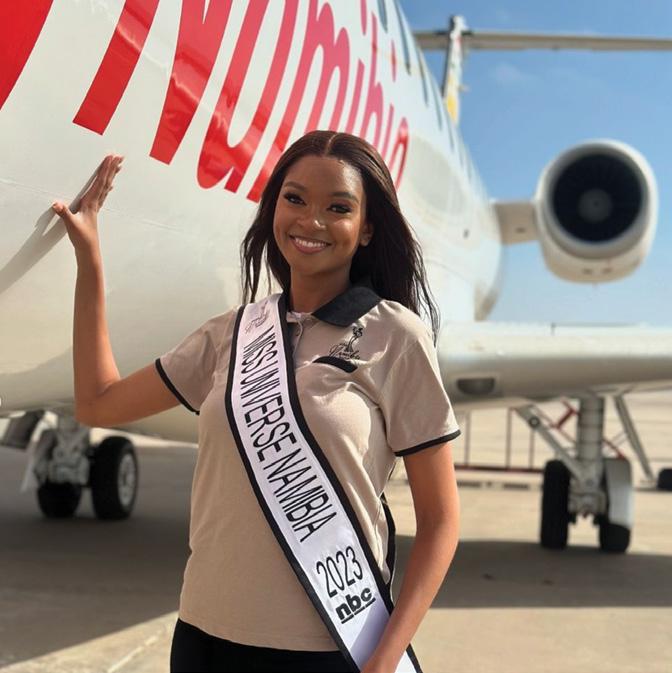


We asked: Picture this... you've just landed at your destination. Who is the first person you're calling?










The silhouette of a makalani palm during sunset is an aesthetically stunning sight to behold. These palms are tall, one-stemmed trees with big dusty-green fronds spread out like a fan. Thus the makalani is also known as the real fan palm. The leaves bring a pleated skirt to mind, with tiny sickle-shaped thorns along the margins. The tree bears clusters of rounded fruits which turn from green to brown as they ripen. Makalani palms can grow up to 10 metres high, while the fronds can reach a length of up to one metre. They are resilient trees with plenty of uses in rural communities as they provide timber as well as other raw material for a variety of products.
The leaves are tough, but livestock such as cattle nevertheless chew on them. Arts and crafts have always been a popular social activity among rural communities and women use palm leaves to weave baskets. It is a household art which can still be a source of extra income. Hand-woven baskets are mostly sold at the open markets and at cultural festivals. The baskets differ in size, patterns and colour. Dried leaves are dyed by boiling them in traditional natural dyes.
The petiole of the fronds is commonly used for fencing and making kitchen utensils. Sap is tapped from the makalani palm and left to ferment naturally. The sap is transparent, naturally sweet and appetizing. It is usually tapped between August and December. I assisted a fellow student on a study during 2016 where we looked into tapping methods and the importance of makalani sap to rural livelihoods in the Okalongo and Anamulenge constituencies in the Omusati Region. A total of 30 households were interviewed for the study, based on purposive sampling.
The findings indicated that the local population applies various criteria for selecting which trees to tap from: e.g. the colour of
Scientific name: Hyphaena petersiana Common name: Makalani palm
the leaves, the gender of trees, the size and the height of the stem as well as the immediate surroundings. The two common methods for tapping sap from the makalani palm tree are piercing and cutting. Piercing is said to be more sustainable for the survival of trees, as cutting can eventually cause the tree to dry out.
The makalani fruit has a shiny shell. The dry flesh is consumed by both humans and livestock. It can be quite tough and contains a lot of fibre. The only seed, known as vegetable ivory, is carved by craftsmen with various designs, from animals to plants, letters and signs – an ideal souvenir in the form of a keyring.
The field study offered an opportunity to engage with communities. Never in my wildest dreams had I expected that the seeds of the makalani palm fruit can be burned into a powder to feed with pap to a dog suspected of having rabies. A remedy to cure rabies in dogs, compliments of indigenous knowledge. The rabies cure came up at least three times from respondents as we carried out this survey. An animal scientist could actually research the chemical composition of the powder from the makalani seed and its properties to treat rabies.
Scientific, indigenous knowledge and the arts had the most intriguing findings in this study. Eating marula kernels with the makalani palm fruit will always be a nostalgic experience, triggering childhood memories. Experiments are part and parcel of any discovery. In the rural communities, alcohol seems to be readily available because almost every fruit can be used to produce spirits. The flesh of the fruit is boiled and the process of distillation takes its course, producing a strong spirit that is 100% natural.
Agnes Shivute
The four pillars of

Embarking on a mental health journey to healing is a deeply personal and often transformative process marked by self-discovery and growth. For many, this journey begins with a recognition of the need for change – a moment when the emotional burden becomes heavier than the challenges of recovery. But what is necessary for this journey?
First and foremost, one will have to talk about it. Support can come in many forms, from professional therapy and counseling to support groups or conversations with trusted friends and family. Each of these resources offers unique benefits, but the common thread is their ability to provide understanding, validation and strategies for coping. Therapy, for instance, can be a powerful tool in unpacking the complexities of one’s mental health. A skilled therapist can help you explore the roots of distress, understand your emotions and develop coping mechanisms. Therapists can help you challenge and change negative thought patterns, and if need be, deal with past trauma or troublesome interpersonal relationships.
Support from others is the fourth and equally important pillar. No man is an island! Connecting with empathetic individuals who understand and validate one’s experiences can be incredibly healing. Whether through support groups or trusted friends and family, sharing one’s struggles can foster a sense of community and reduce feelings of isolation.
Moreover, the healing journey often includes the development of resilience. As individuals confront their mental health challenges, they may learn new coping strategies and build a greater sense of self-efficacy. This resilience not only helps in managing current difficulties but also prepares individuals to handle future stressors more effectively.
First and foremost, one will have to talk about it.
Secondly, there might be the need for medication, particularly in cases where mental health conditions are believed to have an organic component. When prescribed and monitored by a healthcare professional, medication can alleviate symptoms and make additional therapeutic work more effective.
As a third pillar, one’s own effort is needed. Self-care is a crucial aspect of the healing journey. It involves adopting practices that nurture physical, emotional and mental wellbeing. This can include physical activity such as a walk in nature, healthy eating habits, proper sleep hygiene and activities that bring joy or relaxation to help us stay grounded and manage stress.
Ultimately, the path to mental health recovery is not linear. It is a bumpy road with setbacks and periods of stagnation, but each step, no matter how small, contributes to the overall healing process. Embracing this journey with patience and compassion towards oneself is key. It is about making progress, not achieving perfection, and recognising that healing is a continuous, evolving process.
Dr Daleen de Lange Specialist Psychiatrist



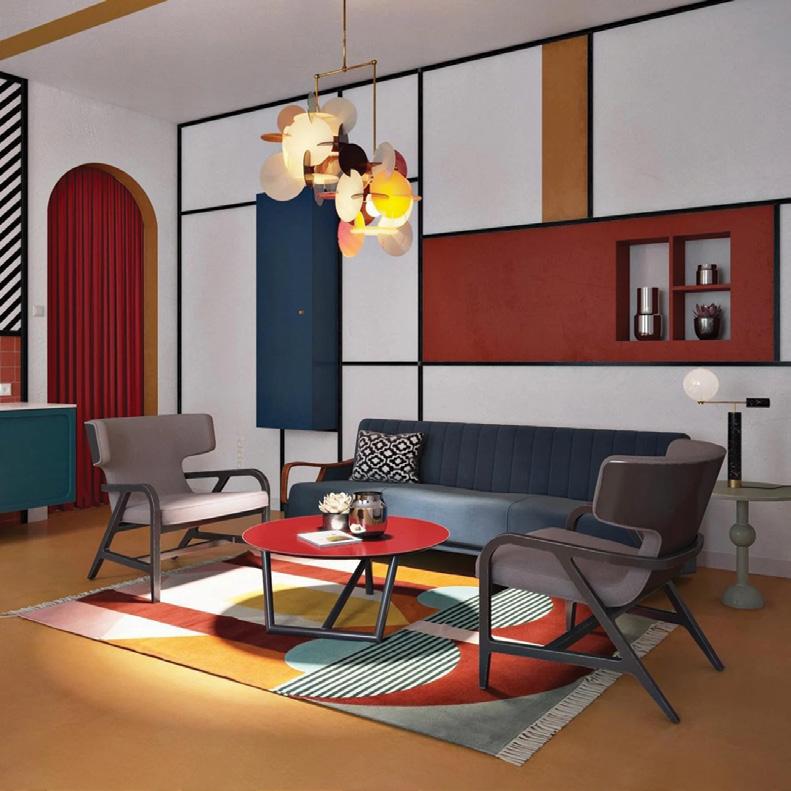
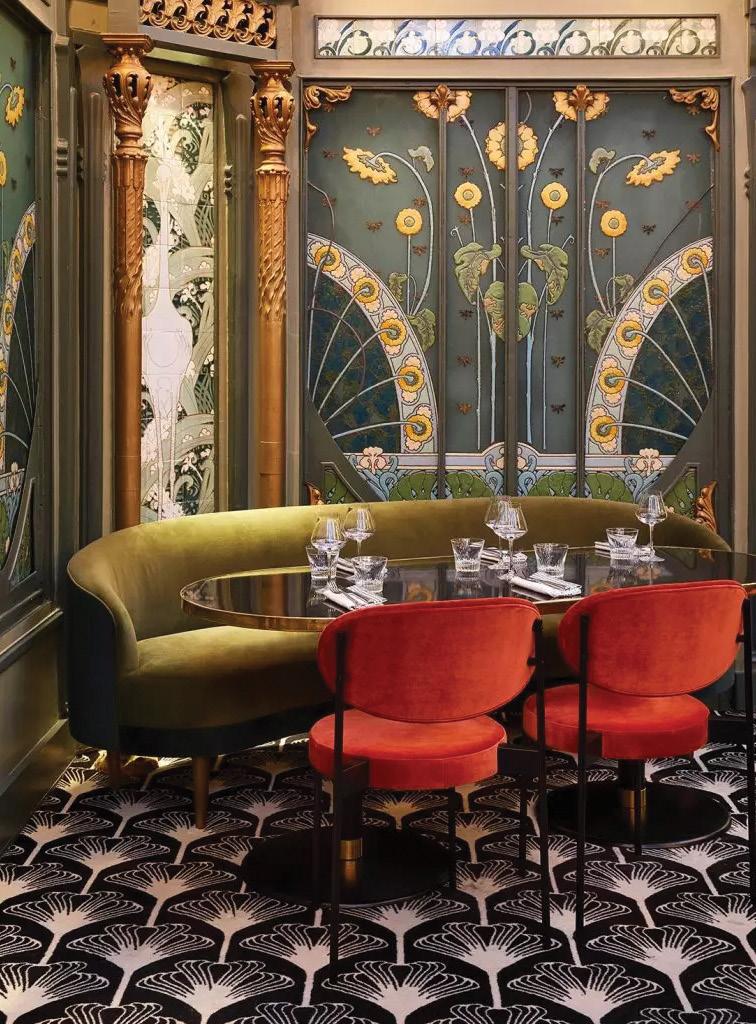

Interior design and architecture, much like fashion and other cultural capital, have always mirrored our collective zeitgeist. The neoclassical style emerged in France in the mid-18th century as a symbol of the rejection of monarchy and the embrace of republicanism. Bauhaus came about in the wake of World War I, when morale was rather low and people sought to simplify and beautify their homes with sleek designs that were affordably mass-produced. The Art Deco design style in the United States, interestingly, ran parallel with the timeline of Bauhaus in Europe, yet showed a juxtaposed craving for excess and extravagance, which quickly came to a grinding halt with the onset of the Great Depression. Mid-century modern, characterised by simplicity and closeness to nature, was the USA’s response to post-war sentiment and practical needs.
Much like these design eras reflected human experience at the time, the way we decorate our spaces today also says something about us. The pandemic, for instance, saw many people setting up dedicated workspaces. Our collective conscience on fast consumerism and waste has driven an upcycling and second-hand culture. The out-of-pocket housing market has propelled a new industry of renterfriendly wallpaper and tiles. Homes, offices, and restaurants will always reflect how we experience the world, and what we desire to get out of it. But more than anything, our unpredictable world should drive us to craft spaces we want to exist in, that bolster community, comfort and connection.
Take this quiz to find out which pivotal design era you should incorporate into your home.
1. Which one of the following movies do you find most visually striking?
a. The Great Gatsby
b. Marie Antoinette
c. The Matrix
d. Once Upon a Time in Hollywood
2. Wallpaper has made a major comeback! What kind would you consider putting on your walls?
a. A simple geometric motif
b. Scalloped gold-leaf feather shapes
c. An abstract mural
d. Faux wood panelling
3. What kind of lighting would you place in your dream dining room?
a. A white, dome pendant above the table, and a brass floor lamp in the corner
b. Crystal chandelier above the table and a candle sconces around the room
c. Three smaller pendants above the table and a glassdomed floor lamp
d. Brass and sanded glass ornate chandelier and half moon sconces on the walls
4. If you had to choose just one accent colour to incorporate in your living room, what would it be?
a. Powder blue
b. Terracotta orange
c. Emerald green
d. Scarlet red
If minimalism and maximalism had a love child, it would be the neoclassical style. Drawing inspiration from the excessive Baroque and Rococo styles, pairing them down with a modern approach, Neoclassic is defined by symmetry, clean lines, and a balanced approach to design.
Imagine huge, arched French windows, a chequered floor and an ornate fireplace. The furniture in this boujee space will then soften the extravagance of these architectural elements. It’s giving old money with lots of class, a family estate passed down through generations, but the great, great grandkids have friends in furniture design.


This geometry-minded design approach is defined by the principle of ‘form follows function.’ Excess ornamentation and “frills” have no place here, it’s about simplicity and the beauty thereof. To combine art and industry, Bauhaus can best be implemented in your space through strong, industrial materials like steel and concrete, paired with clean lines and primary colours. It should not be mistaken for sad, grey minimalism. Although Bauhaus does incorporate minimalist ideas, its thoughtful use of colour and practicality adds fun and flair to spaces. In short, bring in lots of solid colour, and if that lounge chair never sees a bum, it doesn’t belong.
Rich colour, decadent marble and bold geometry are just some of the basics of Art Deco design. Celebrating modernity, technology, and the machine age, Art Deco emphasised opulence and was heavily influenced by the Cubist and Futurist art movements. To implement it in your home, the best way to start is not to shy away from darker colours like deep burgundy and even back lacquer. Add brass, gold and mirrored elements and why not throw in a zebra skin on the floor. Geometry in Art Deco is best included through rounded and ornate shapes like arches, or sharp lines like chevron patterns. But it also doesn’t take itself so seriously. If you need a refresher, just watch The Great Gatsby again.


Lots and lots of wood with retro colours and curves. MCM marked a major return to the natural and organic between 1945 and the early 70’s, best defined by the work of architect Frank Lloyd Wright. If you happen to find yourself in a face-brick or breeze block home, I dare you to lean into the MCM style, as the neural colours and textures of these finishes lay the perfect backdrop. To implement this style in your home, try mixing modern furniture pieces with classic textiles like velvet, set the stage with earthy tones and inject colours like olive green and burnt orange. Big windows without curtains are also a major MCM moment.
Charene Labuschagne


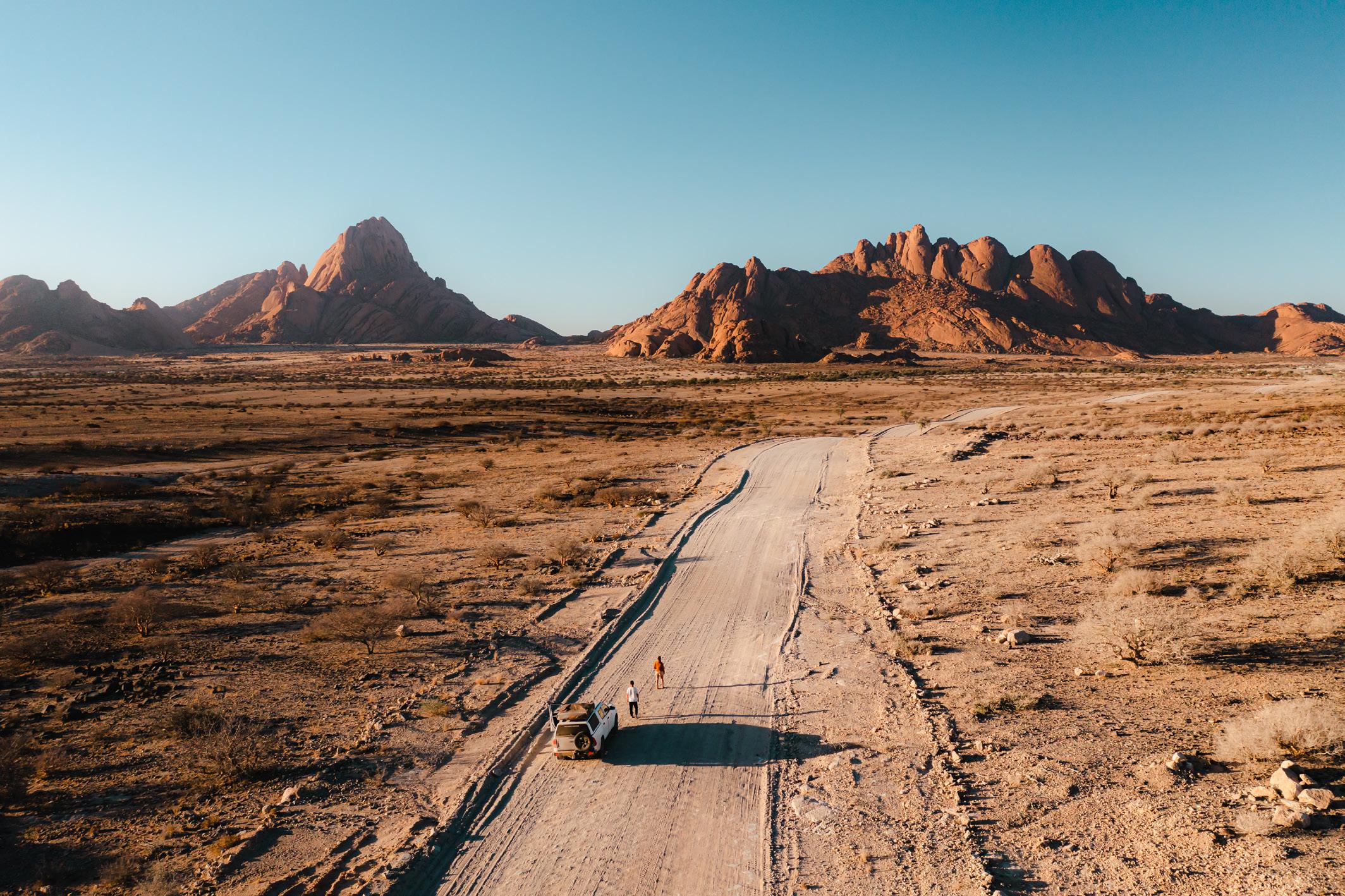


If you, like me, grew up in a small town you know that this means that dirty laundry is out for all to see. Affairs and other scandals become public fodder. Not necessarily because they happen with more frequency than in bigger cities, but because the connectedness of people in small towns makes it easy for stories to spread.
Social media is a lot like this small-town effect, where you get the rapid spreading of information. The recently concluded 2024 Summer Olympic Games in Paris is a great example of this and also demonstrates how social media was built for fighting.
The games themselves certainly leaned into the creation of their own controversy. Think of the opening ceremony, the official logo that looked like Mary J Blige, or the filth in the Seine River that even hospitalised swimming participants. But another interesting factor of this year’s games was the extent to which armchair critics became public commentators, thanks to social media. This phenomenon demonstrated how much the internet is built for fighting.
There’s no shortage of research about the psychology of arguing online. For example, it is well known that a person’s voice conveys more than just their words. When we hear a person explain their beliefs, that person will seem more human and more competent to us than if we were to read their words. This is why it is easier to dehumanise someone you are fighting with online.
What we also need to consider is that the design of social media is made for fighting. Research has found a few factors in the online war of words. One is that people can find it nearly impossible to avoid arguments on certain platforms such as Facebook and WhatsApp. Another is that disagreements become sparring matches with a captive audience, rather than two or more people trying to express their views and find common ground. And let us not forget that the way Facebook structures commenting prevents meaningful engagement because many comments are automatically hidden and cut shorter.
Returning to the Olympics as our example here, while the Olympics have always drawn attention, nowadays views can
go viral, whether they are based in fact or not.
Take for example how French pole vaulter Anthony Ammirati received maybe more attention than he wanted when after a video went viral suggesting a "bulge" in his shorts cost him a medal. In Ammirati's case, a closer view of the video shows that his knee hit the bar. Moreover, while he also failed in all three attempts, nine other men didn’t.
According to Paul Miser, executive vice president and group director at marketing firm The How Agency, “the speed, amplification, broader reach, and ability to build and engage in real-time conversations around Olympic moments have shifted the dynamic of how the games are covered and consumed. Social media empowers users to decide what they find interesting, endearing, and newsworthy.”
What adds frustration to this mix is that often when the internet gets it wrong and something goes viral before the truth has been established, it takes the conversation away from the actual problem and makes it about something else. What comes to my mind here is how, when the world jumped in to discuss Algerian boxer Imane Khelif who was at the centre of a controversy over gender for her high testosterone, we Namibians stood in disbelief with the knowledge of what our runners Christine Mboma and Beatrice Masilingi have been through to be allowed to compete due to their testosterone levels.
If you recall, last year new regulations by World Athletics meant they had to lower their higher-than-usual testosterone levels to compete in events. This hormone therapy led to quick fatigue, impacting their performance, and dreams of competing at this year’s Olympics were dashed.
So if social media has the power to make unlikely stars, like the newfound fame Turkish shooter Yusuf Dikec received, wouldn’t it be wonderful if this force was used for good, or to shine a light on double standards and inequalities worldwide? Wouldn’t that be nice?
Kirsty Watermeyer
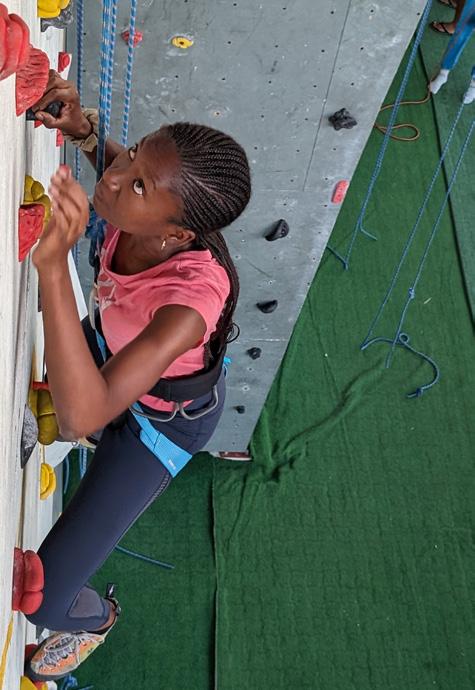
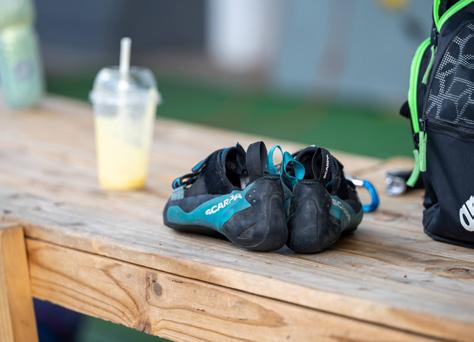

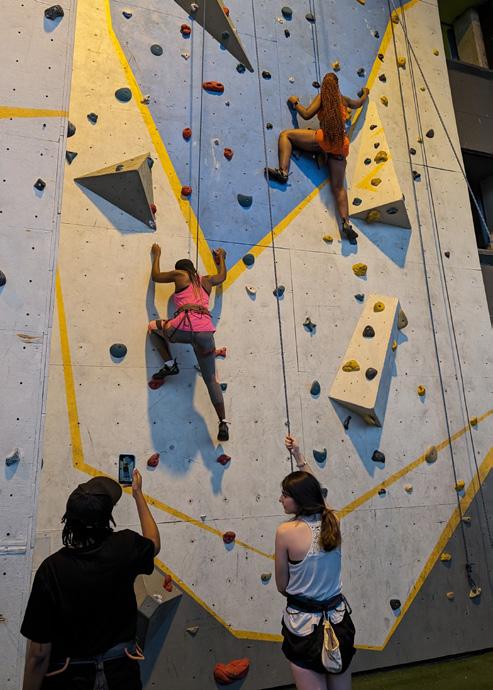








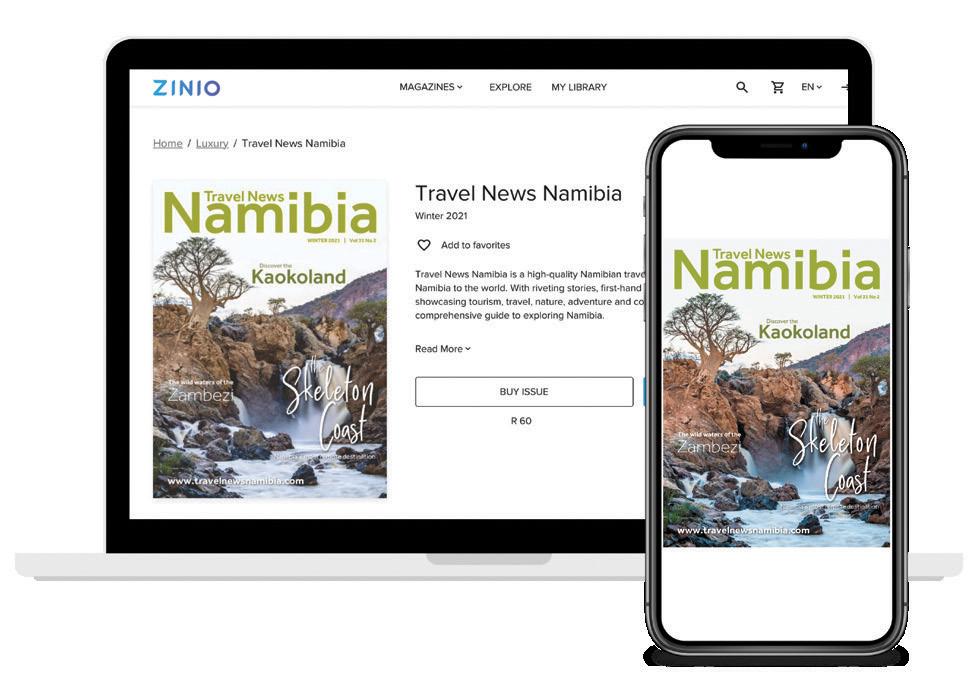




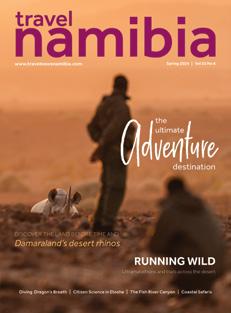
2 September 31 BC
Mark Antony and Cleopatra defeated at the Battle of Actium. It took place in the Ionian Sea near Actium, Greece and was the climax of a decade-long rivalry between Augustus Octavian and Antony.

3 September 1939
Declaration of war by Britain and France on Germany signalling the beginning of the Second World War.
6 September 1959
Mattel Toy Corporation sold the first Barbie doll. Considered revolutionary as the first adult doll on offer at a time when baby dolls - that allowed girls to pretend to be mothersdominated the market.


September 1986
Desmond Tutu became archbishop of Cape Town. He was known for his work as an anti-apartheid and human rights activist.

Islamic extremists hijacked four aeroplanes in a coordinated suicide terrorist attack that flew into the World Trade Centre, New York. Nearly 3 000 people died in the events of 9/11.
The first Glastonbury music festival took place over two days, The 1,500 people that attended paid £1 each for their ticket, which included fresh milk from Worthy Farm, where the festival was held.

September 1869
Black Friday: an attempted fraud caused a severe fall in the price of gold and a US financial crisis.
Announcement by JeanFrancois Champollion, founder of Egyptology, that he had deciphered Egyptian hieroglyphs using the Rosetta Stone.

The name September comes from the septem, meaning “seven” in Latin. It was the seventh month in the early Roman Calendar.
Virgo (Aug. 23–Sept. 22) are practical, sensible and loyal people with a tireless perfectionist streak.

Libra (Sept. 23–Oct. 22) is known for being natural peace-makers, charming, and well-balanced people with an indecisive streak.
The goal of Sudoku is to fill a 9×9 grid with numbers so that each row, column and 3×3 section contain all of the digits between 1 and 9.
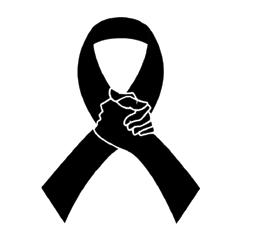



Glide across nothing, and everything | Soaring above the vast dunes of the Namib Desert, a hot air balloon ride over Sossusvlei offers an unparalleled experience. As the sun rises, the golden sands and ancient landscapes unfold beneath you, creating a breathtaking panorama that captures the essence of Namibia's wild, untouched beauty.
Elzanne McCulloch
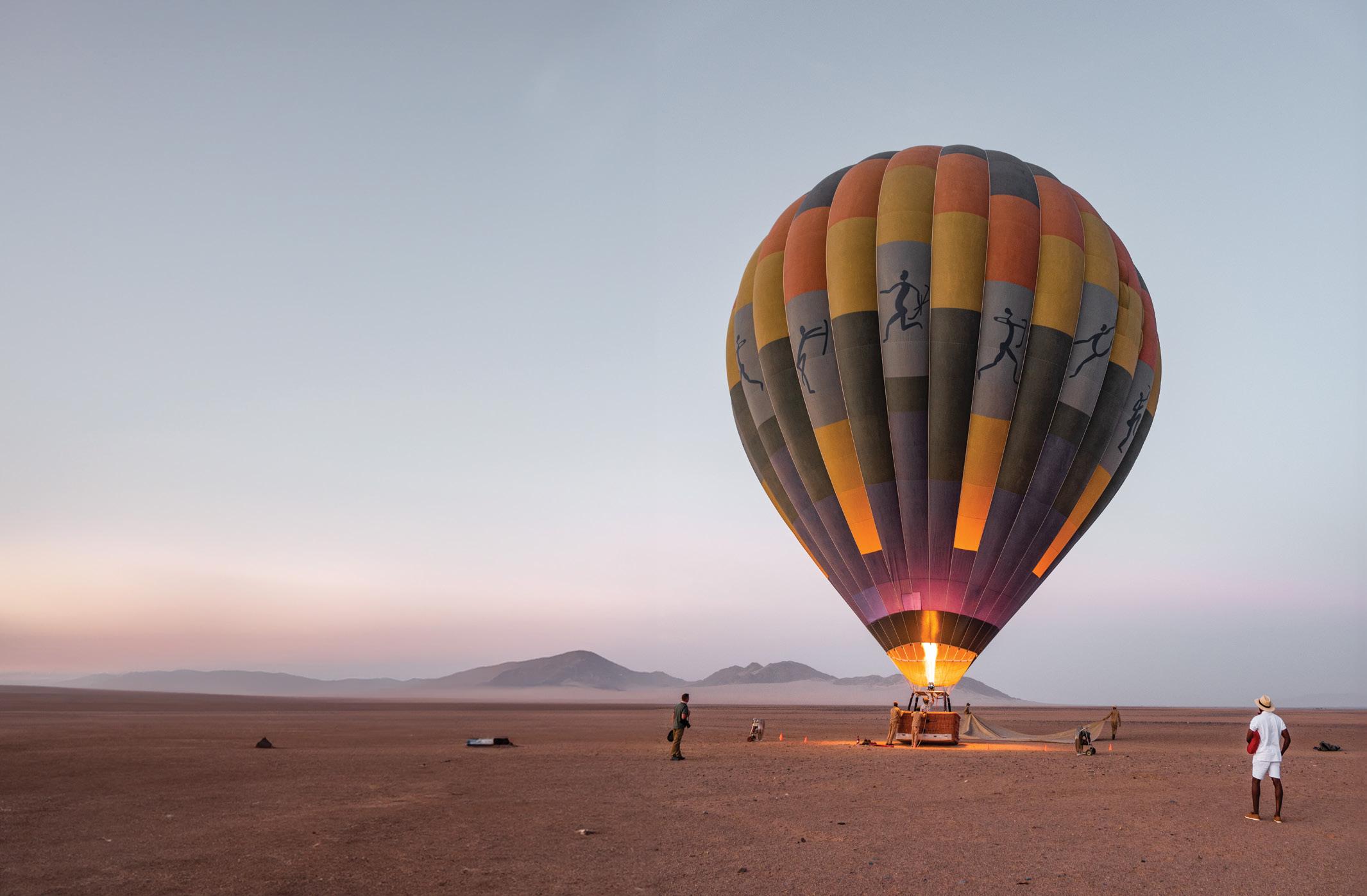
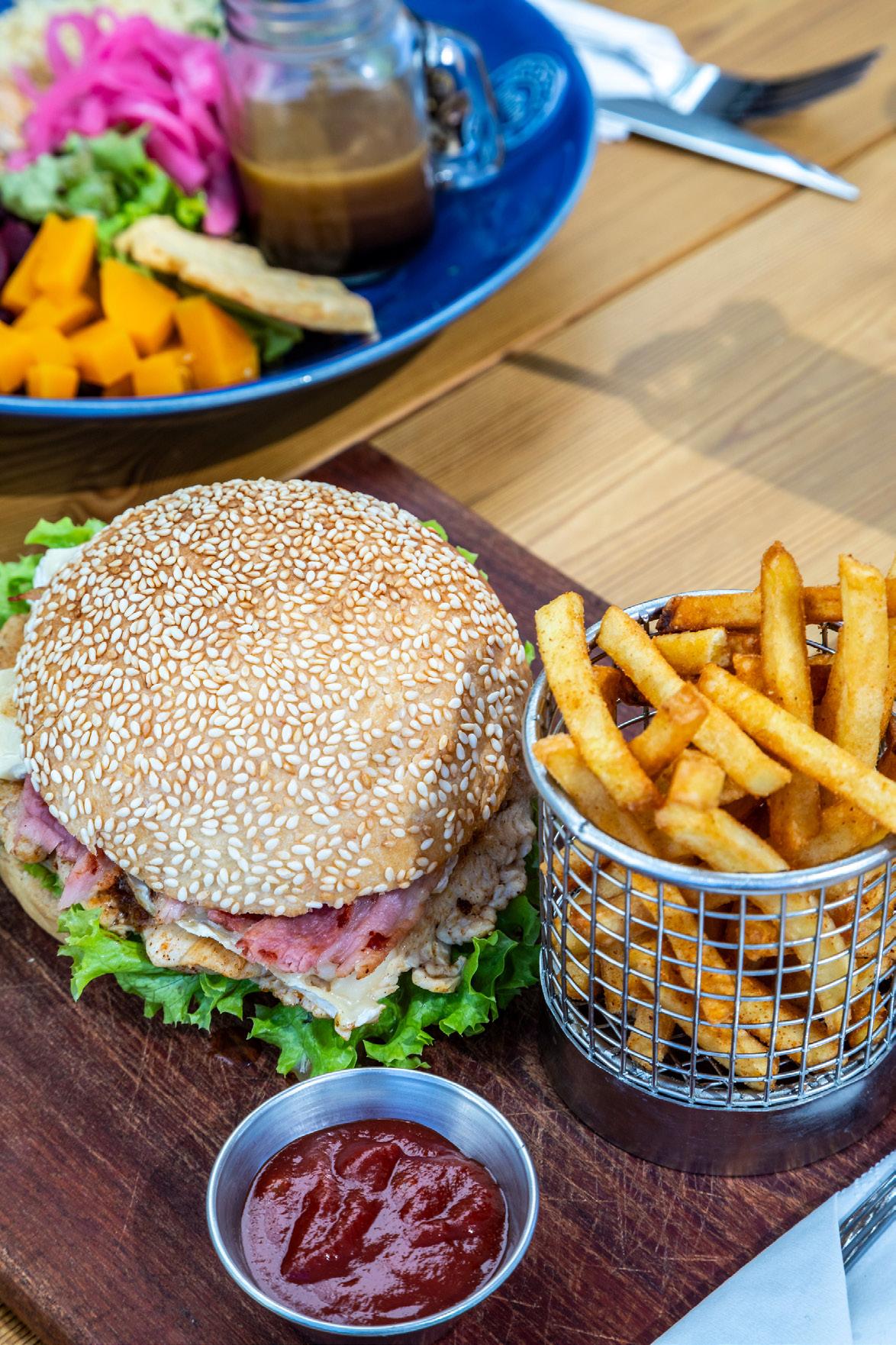

or just because.
081 861 4614

